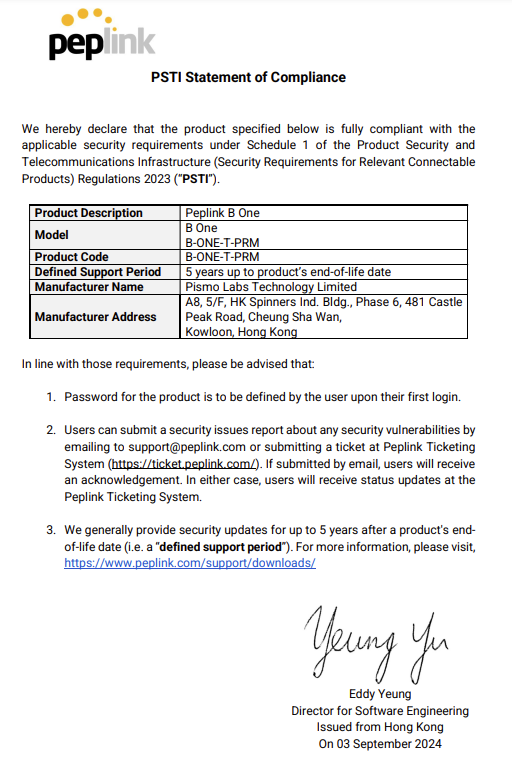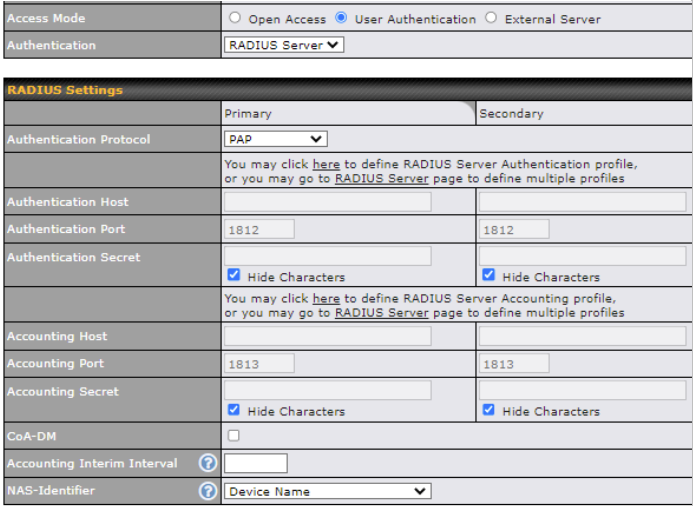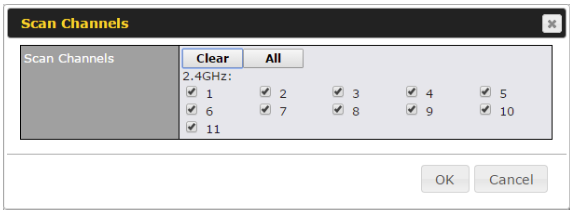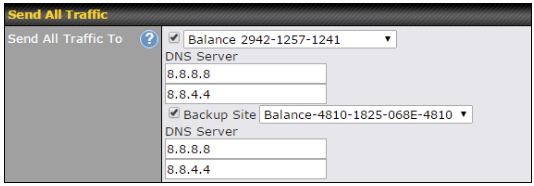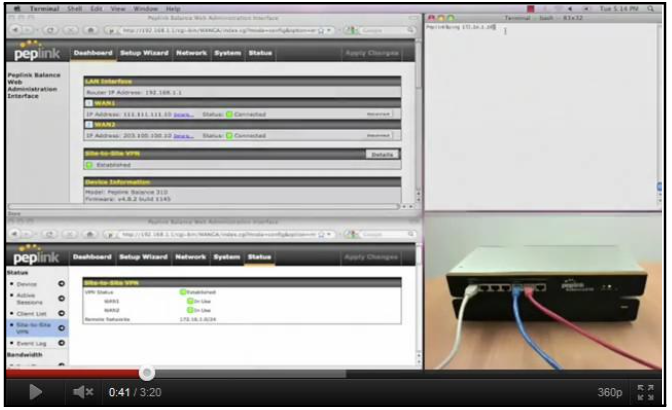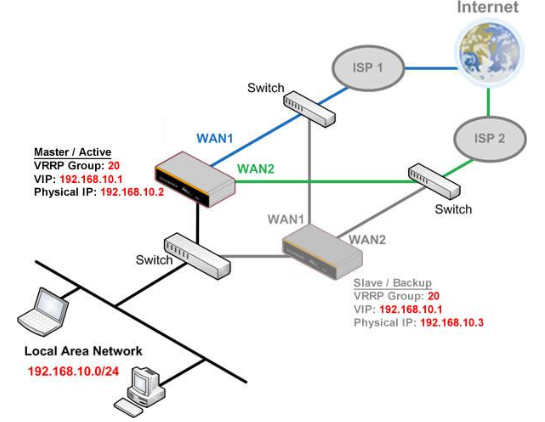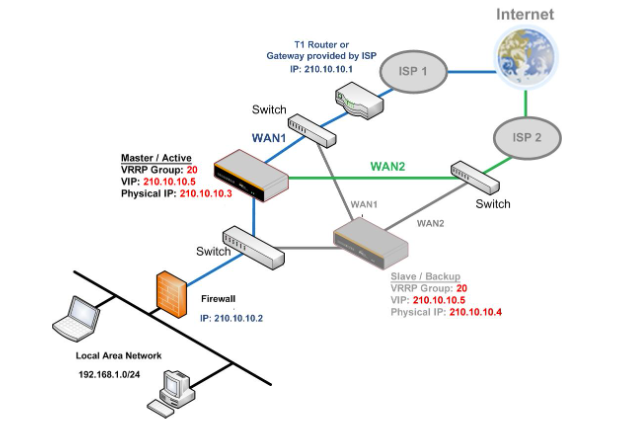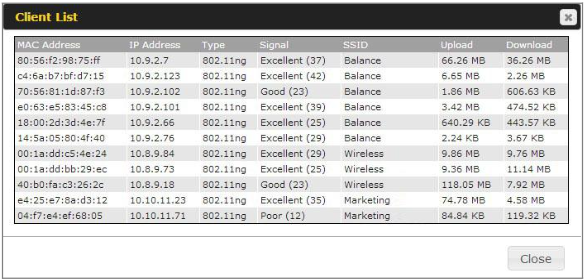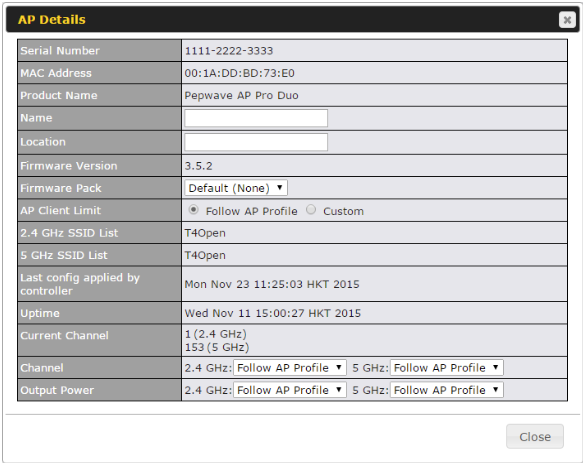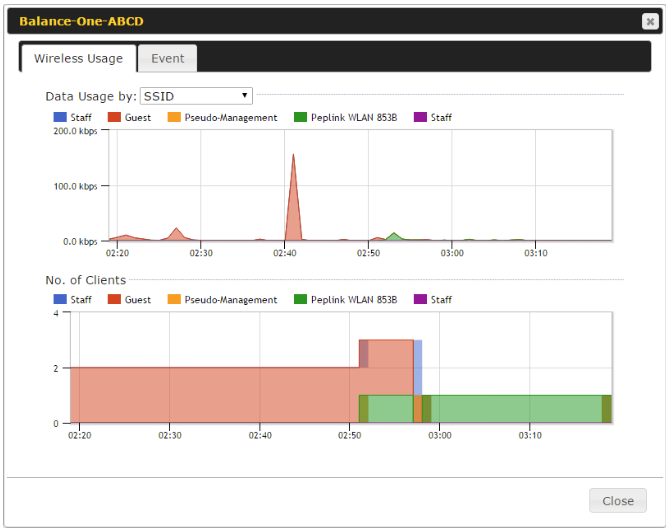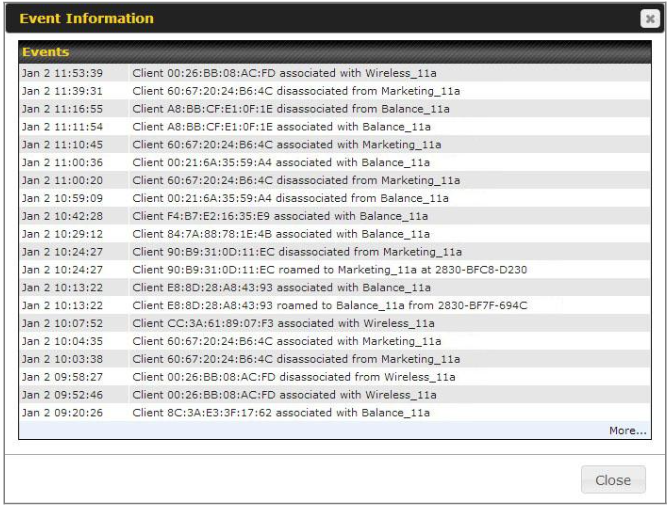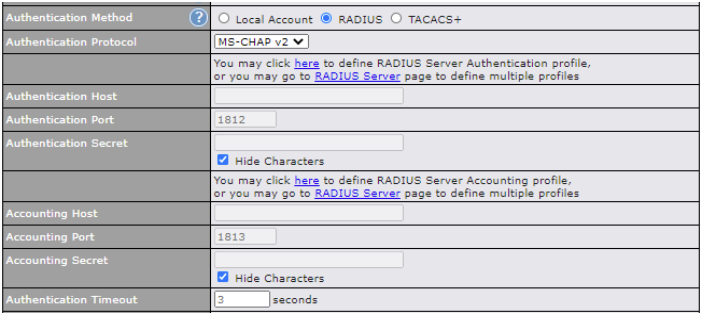Peplink B One Series User Manual#

B One Series
User Manual
Peplink Products:
B One, B One Plus & B One 5G
Peplink Firmware 8.5.2
June 2025
Introduction and Scope#
Peplink routers provide link aggregation and load balancing across multiple WAN connections, allowing a combination of technologies like 3G HSDPA, EVDO, 4G LTE, Wi-Fi, external WiMAX dongle, and satellite to be utilized to connect to the Internet.
The MAX wireless SD-WAN router series has a wide range of products suitable for many different deployments and markets. Entry level SD-WAN models such as the MAX BR1 are suitable for SMEs or branch offices. High-capacity SD-WAN routers such as the MAX HD2 are suitable for larger organizations and head offices.
This manual covers setting up Peplink routers and provides an introduction to their features and usage.
| Tips |
| Want to know more about Peplink routers? Visit our YouTube Channel for a video introduction!
|
Glossary#
The following terms, acronyms, and abbreviations are frequently used in this manual:
| Term | Definition |
| 3G | 3rd generation standards for wireless communications (e.g., HSDPA) |
| 4G | 4th generation standards for wireless communications (e.g., LTE) |
| DHCP | Dynamic Host Configuration Protocol |
| DNS | Domain Name System |
| EVDO | Evolution-Data Optimized |
| FQDN | Fully Qualified Domain Name |
| HSDPA | High-Speed Downlink Packet Access |
| HTTP | Hyper-Text Transfer Protocol |
| ICMP | Internet Control Message Protocol |
| IP | Internet Protocol |
| LAN | Local Area Network |
| MAC Address | Media Access Control Address |
| MTU | Maximum Transmission Unit |
| MSS | Maximum Segment Size |
| NAT | Network Address Translation |
| PPPoE | Point to Point Protocol over Ethernet |
| QoS | Quality of Service |
| SNMP | Simple Network Management Protocol |
| TCP | Transmission Control Protocol |
| UDP | User Datagram Protocol |
| VPN | Virtual Private Network |
| VRRP | Virtual Router Redundancy Protocol |
| WAN | Wide Area Network |
| WINS | Windows Internet Name Service |
| WLAN | Wireless Local Area Network |
Ch1. Product Features#
Peplink routers enable all LAN users to share broadband Internet connections, and they provide advanced features to enhance Internet access. Below is a list of supported features on Peplink routers. Features vary by model. For more information, please see peplink.com/products.
Supported Network Features#
WAN
- Ethernet WAN connection in full/half duplex
- Static IP support for PPPoE
- Built-in cellular modems
- USB mobile connection(s)
- Wi-Fi WAN connection
- Network address translation (NAT)/port address translation (PAT)
- Inbound and outbound NAT mapping
- IPsec NAT-T and PPTP packet passthrough
- MAC address clone and passthrough
- Customizable MTU and MSS values
- WAN connection health check
- Dynamic DNS (supported service providers: changeip.com, dyndns.org, no-ip.org, tzo.com and DNS-O-Matic)
- Ping, DNS lookup, and HTTP-based health check
LAN
- Wi-Fi AP
- Ethernet LAN ports
- DHCP server on LAN
- Extended DHCP option support
- Static routing rules
- VLAN on LAN support
VPN
- PepVPN with SpeedFusionTM
- PepVPN performance analyzer
- X.509 certificate support
- VPN load balancing and failover among selected WAN connections
- Bandwidth bonding and failover among selected WAN connections
- IPsec VPN for network-to-network connections (works with Cisco and Juniper)
- Ability to route Internet traffic to a remote VPN peer
- Optional pre-shared key setting
- SpeedFusionTM throughput, ping, and traceroute tests
- PPTP server
- PPTP and IPsec passthrough
Firewall
- Outbound (LAN to WAN) firewall rules
- Inbound (WAN to LAN) firewall rules per WAN connection
- Intrusion detection and prevention
- Specification of NAT mappings
- Outbound firewall rules can be defined by destination domain name
Captive Portal
- Splash screen of open networks, login page for secure networks
- Customizable built-in captive portal
- Supports linking to outside page for captive portal
Outbound Policy
- Link load distribution per TCP/UDP service
- Persistent routing for specified source and/or destination IP addresses per TCP/UDP service
- Traffic prioritization and DSL optimization
- Prioritize and route traffic to VPN tunnels with Priority and Enforced algorithms
AP Controller
- Configure and manage Pepwave AP devices
- Review the status of connected APs
QoS
- Quality of service for different applications and custom protocols
- User group classification for different service levels
- Bandwidth usage control and monitoring on group- and user-level
- Application prioritization for custom protocols and DSL/cable optimization
Other Supported Features#
- User-friendly web-based administration interface
- HTTP and HTTPS support for web admin interface (default redirection to HTTPS)
- Configurable web administration port and administrator password
- Firmware upgrades, configuration backups, ping, and traceroute via web admin interface
- Remote web-based configuration (via WAN and LAN interfaces)
- Time server synchronization
- SNMP
- Email notification
- Read-only user access for web admin
- Shared IP drop-in mode
- Authentication and accounting by RADIUS server for web admin
- Built-in WINS servers*
- Syslog
- SIP passthrough
- PPTP packet passthrough
- Event log
- Active sessions
- Client list
- WINS client list *
- UPnP / NAT-PMP
- Real-time, hourly, daily, and monthly bandwidth usage reports and charts
- Support USB tethering on Android 2.2+ phones
* Not supported on MAX Surf-On-The-Go, and BR1 variants
Ch2. Peplink B One Series Routers Overview#
B One#
Panel Appearance
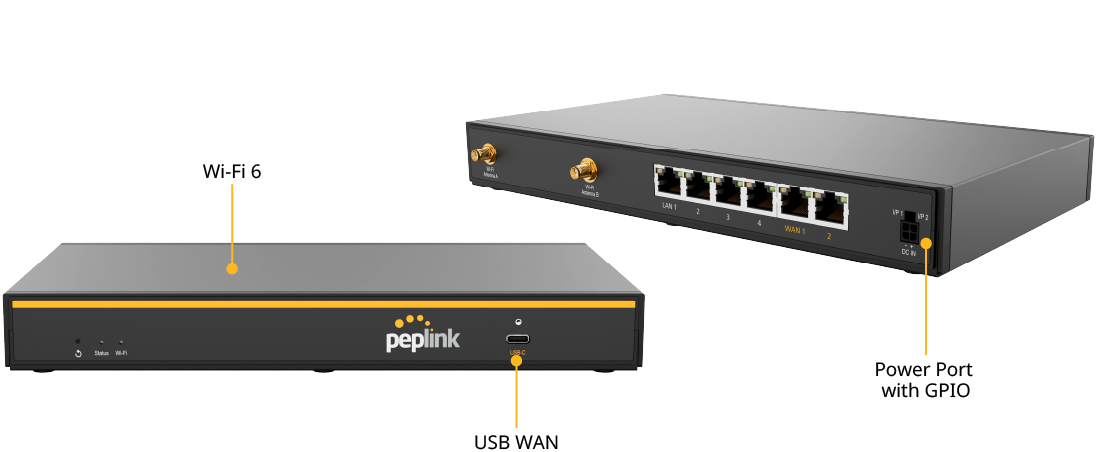
LED Indicators
The statuses indicated by the front panel LEDs are as follows:
| Wi-Fi Indicators | ||
| Wi-Fi | OFF | Wi-Fi AP or Wi-Fi WAN is disabled. |
| Green | Wi-Fi AP or Wi-Fi WAN is enabled. | |
| Status Indicator | ||
| Status | OFF | Power Off |
| Red | Booting up or busy | |
| Blinking Red | Boot up error | |
| Green | Ready | |
B One Plus#
Panel Appearance
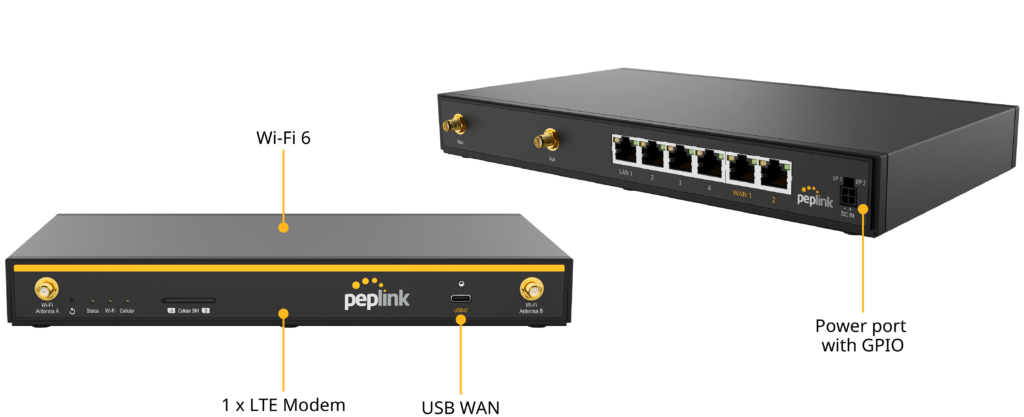
LED Indicators
The statuses indicated by the front panel LEDs are as follows:
| Wi-Fi Indicators | ||
| Wi-Fi | OFF | Wi-Fi AP or Wi-Fi WAN is disabled. |
| Green | Wi-Fi AP or Wi-Fi WAN is enabled. | |
| Cellular Indicator | ||
| Status | OFF | Disabled or no SIM card inserted |
| Blinking Slowly | Connecting to network(s) | |
| Green | Connected to network(s) | |
| Status Indicator | ||
| Status | OFF | Power Off |
| Red | Booting up or busy | |
| Blinking Red | Boot up error | |
| Green | Ready | |
B One 5G#
Panel Appearance
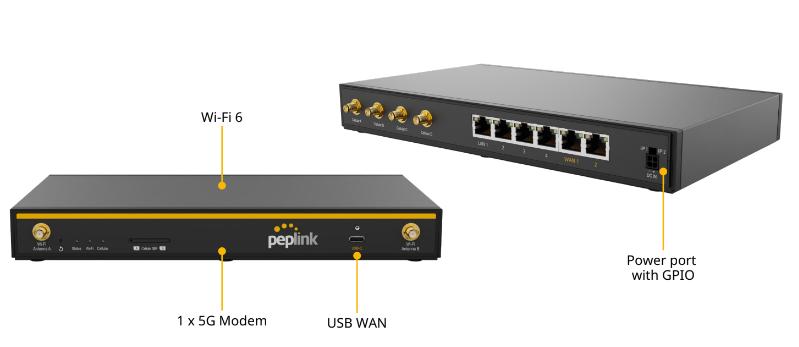
LED Indicators
The statuses indicated by the front panel LEDs are as follows:
| Wi-Fi Indicators | ||
| Wi-Fi | OFF | Wi-Fi AP or Wi-Fi WAN is disabled. |
| Green | Wi-Fi AP or Wi-Fi WAN is enabled. | |
| Cellular Indicator | ||
| Status | OFF | Disabled or no SIM card inserted |
| Blinking Slowly | Connecting to network(s) | |
| Green | Connected to network(s) | |
| Status Indicator | ||
| Status | OFF | Power Off |
| Red | Booting up or busy | |
| Blinking Red | Boot up error | |
| Green | Ready | |
Ch3. Advanced Feature Summary#
Drop-in Mode and LAN Bypass: Transparent Deployment
USB Modem and Android Tethering
Built-In Remote User VPN Support
Drop-in Mode and LAN Bypass: Transparent Deployment#
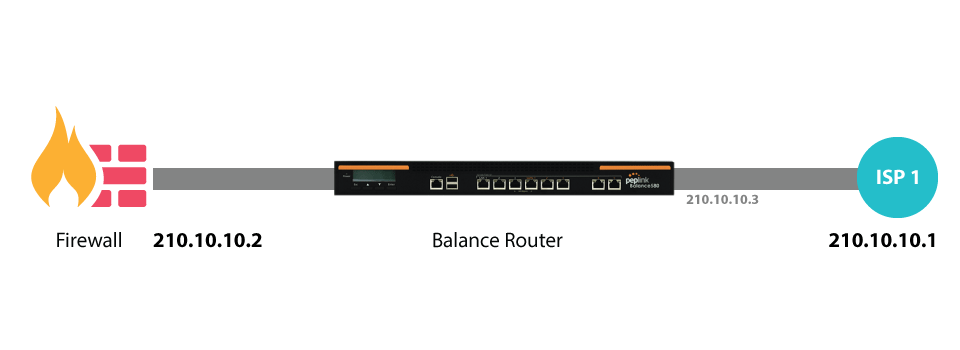
As your organization grows, it may require more bandwidth, but modifying your network can be tedious. In Drop-in Mode, you can conveniently install your Peplink router without making any changes to your network. For any reason your Peplink router loses power, the LAN Bypass will safely and automatically bypass the Peplink router to resume your original network connection.
Note: Drop-in mode is compatible for All MAX models except MAX BR1 IP67
QoS: Clearer VoIP#

VoIP and videoconferencing are highly sensitive to latency. With QoS, Peplink routers can detect VoIP traffic and assign it the highest priority, giving you crystal-clear calls.
Per-User Bandwidth Control#
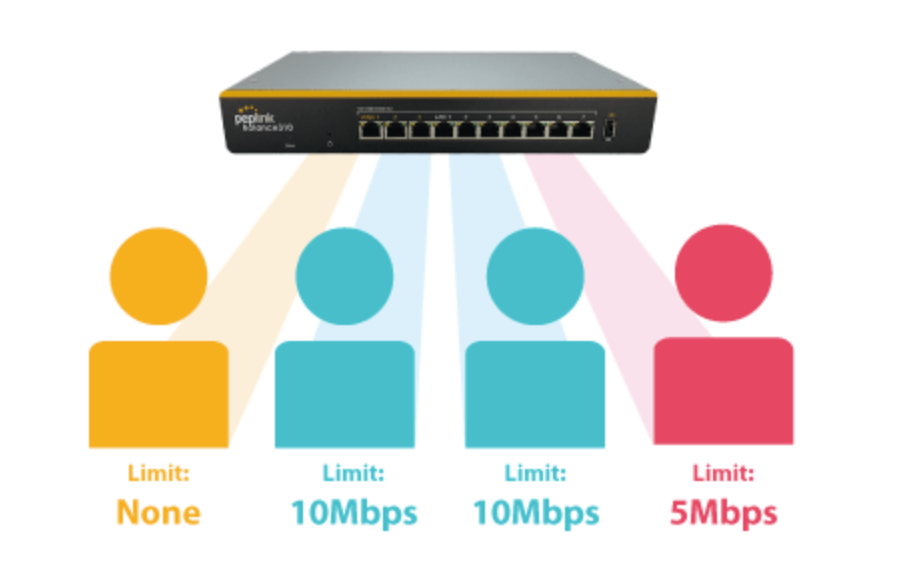
With per-user bandwidth control, you can define bandwidth control policies for up to 3 groups of users to prevent network congestion. Define groups by IP address and subnet, and set bandwidth limits for every user in the group.
High Availability via VRRP#
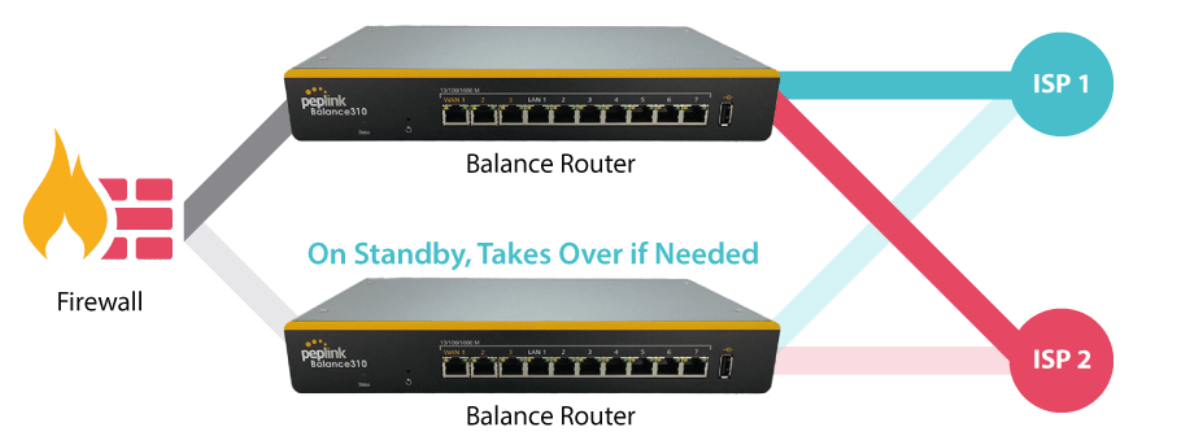
When your organization has a corporate requirement demanding the highest availability with no single point of failure, you can deploy two Peplink routers in High Availability mode. With High Availability mode, the second device will take over when needed.
Compatible with: MAX 700, MAX HD2 (All variants), HD4 (All Variants)
USB Modem and Android Tethering#
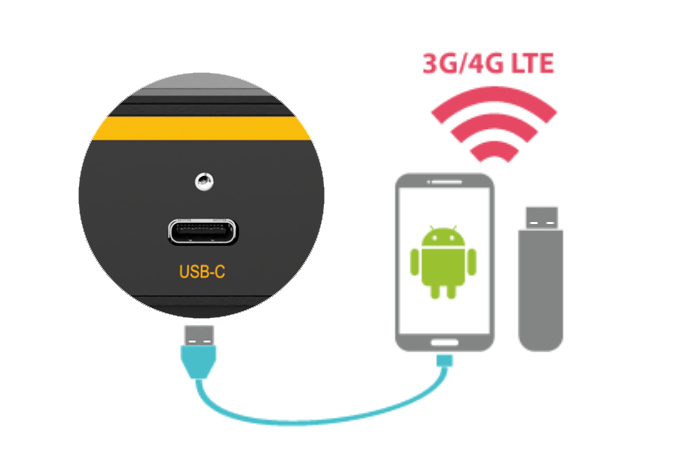
For increased WAN diversity, plug in a USB LTE modem as a backup. Peplink routers are compatible with over 200 modem types. You can also tether to smartphones running Android 4.1.X and above.
Compatible with: MAX 700, HD2 (all variants except IP67), HD4 (All variants)
Built-In Remote User VPN Support#

Use OpenVPN or L2TP with IPsec to safely and conveniently connect remote clients to your private network. L2TP with IPsec is supported by most devices, but legacy devices can also connect using PPTP.
Click here for the full instructions on setting up L2TP with IPsec.
Click here for the full instructions on setting up OpenVPN connections
SIM-card USSD support#

Cellular-enabled routers can now use USSD to check their SIM card’s balance, process pre-paid cards, and configure carrier-specific services.
Click here for full instructions on using USSD
DPI Engine#
The DPI report written in the updated KB article will show further information on InControl2 through breaking down application categories into subcategories.
NetFlow#
NetFlow protocol is used to track network traffic. Tracking information from NetFlow can be sent to the NetFlow collector, which analyzes data and generates reports for review.
Note: To enable this feature, go to https://<Device’s IP>/cgi-bin/MANGA/support.cgi

Wi-Fi Air Monitoring#
Pepwave routers support Wi-Fi “Air Monitoring Mode” which is used to troubleshoot remotely and proactively monitor Wi-Fi and WAN performance. The report can be viewed under InControl 2 > Reports > AirProbe Reports after enabling Wi-Fi Air Monitoring.
Note: To enable this feature, go to https://<Device’s IP>/cgi-bin/MANGA/support.cgi

SP Default Configuration#
The SP Default Configuration feature written in the updated KB article allows for the provisioning of custom made settings (a.k.a. InControl2 configuration) via the Ethernet LAN port and is ideal for those wanting to do a bulk deployment of many Peplink devices.
Note: If you would like to use this feature, please contact your purchase point (Eg.VAD).
Peplink Relay#
Cloud Service Providers often restrict access to certain applications. With SFC Relay, you can route traffic before going out to the Internet, allowing access to previously restricted applications experienced with the public SpeedFusion Cloud nodes. Available as an add-on for your home router or as an upgradable license to your Peplink router, SFC Relay is sure to impress you and any peers you give access to.
DNS over HTTPS (DoH)#
DoH provides the benefits of communicating DNS information over a secure HTTPS connection in an encrypted manner. The protocol offers increased privacy and confidentiality by preventing data interception and man-in-the-middle attacks.
Peplink InTouch#
InTouch is Peplink’s zero-touch remote network management solution, leveraging InControl 2 and a SpeedFusion Connect (formerly known as SpeedFusion Cloud) data plan. This service extends a network administrator’s ability to reach any device UI backed by a Peplink/Pepwave router. To configure InTouch, all you need is a valid InControl 2 subscription, a SpeedFusion Connect data plan, and a Peplink/Pepwave router (which requires the latest 8.2.0 firmware).
To watch a demonstration and read the FAQ, visit https://www.peplink.com/enterprise-solutions/intouch/
Or learn to configure InTouch at https://youtu.be/zg0iavHGkJw
Synergy Mode#
Synergy mode is a cascade multiple devices and combine the number of WANs to a single device virtually. All the WANs on the Synergized Device will appear as native WAN interfaces at the Synergy Controller and it can be managed like the built-in WAN interfaces.
https://forum.peplink.com/t/synergy-mode-(firmware-8.3.0)/639be7d8af8c71a6f3050323/
Virtual WAN on VLAN#
The Virtual WAN Activation License allows you to create 1 x virtual WAN on a particular VLAN, on either WAN or LAN interface. This means that you can create a virtual WAN on VLAN for a WAN port, or a virtual WAN on VLAN for a LAN port.
https://forum.peplink.com/t/b20x-virtual-wan-activation-license-faq/6204bac7d90b9e6355e96e8d/1
Ch4. Installation#
The following section details connecting Pepwave routers to your network.
Preparation
Before installing your Pepwave router, please prepare the following as appropriate for your installation:
- At least one Internet/WAN access account and/or Wi-Fi access information
- Depending on network connection type(s), one or more of the following:
- Ethernet WAN: A 10/100/1000BaseT UTP cable with RJ45 connector
- USB: A USB modem
- Embedded modem: A SIM card for 5G/4G LTE service
- Wi-Fi WAN: Wi-Fi antennas
- PC Card/Express Card WAN: A PC Card/ExpressCard for the corresponding card slot
- A computer installed with the TCP/IP network protocol and a supported web browser. Supported browsers include Microsoft Internet Explorer 11 or above, Mozilla Firefox 24 or above, Apple Safari 7 or above, and Google Chrome 18 or above.
Constructing the Network
At a high level, construct the network according to the following steps:
- With an Ethernet cable, connect a computer to one of the LAN ports on the Pepwave router. Repeat with different cables for up to 4 computers to be connected.
- With another Ethernet cable or a USB modem/Wi-Fi antenna/PC Card/Express Card, connect to one of the WAN ports on the Pepwave router. Repeat the same procedure for other WAN ports.
- Connect the power adapter to the power connector on the rear panel of the Pepwave router, and then plug it into a power outlet.
Configuring the Network Environment
To ensure that the Pepwave router works properly in the LAN environment and can access the Internet via WAN connections, please refer to the following setup procedures:
- LAN configuration
For basic configuration, refer to Connecting to the Web Admin Interface.
For advanced configuration, go to Configuring the LAN Interface(s).
- WAN configuration
For basic configuration, refer to Connecting to the Web Admin Interface.
For advanced configuration, go to Captive Portal.
Ch5. Connecting to the Web Admin Interface#
- Start a web browser on a computer that is connected with the Pepwave router through the LAN.
- To connect to the router’s web admin interface, enter the following LAN IP address in the address field of the web browser: http://192.168.50.1(This is the default LAN IP address for Pepwave routers.)
- Enter the following to access the web admin interface.
Username: admin
Password: admin
(This is the default username and password for Pepwave routers).
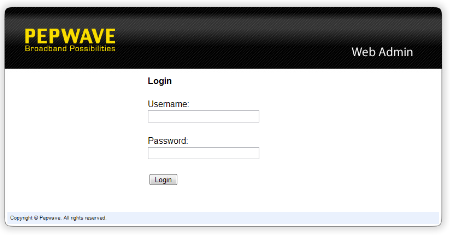
- You must change the default password on the first successful logon.
- Password requirements are: A minimum of 10 lower AND upper case characters, including at least 1 number.
- When HTTP is selected, the URL will be redirected to HTTPS by default.
- Login will be suspended for 5 minutes after attempting to log in with an “Invalid Username or Password.”
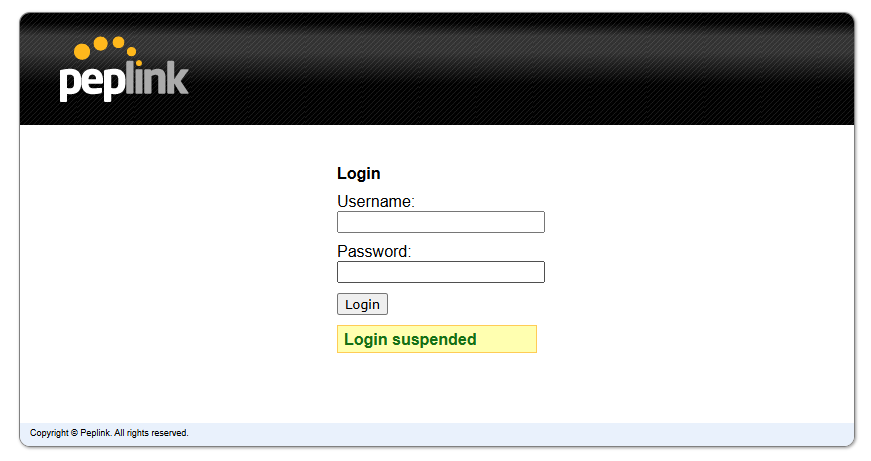

After successful login, the Dashboard of the web admin interface will be displayed.
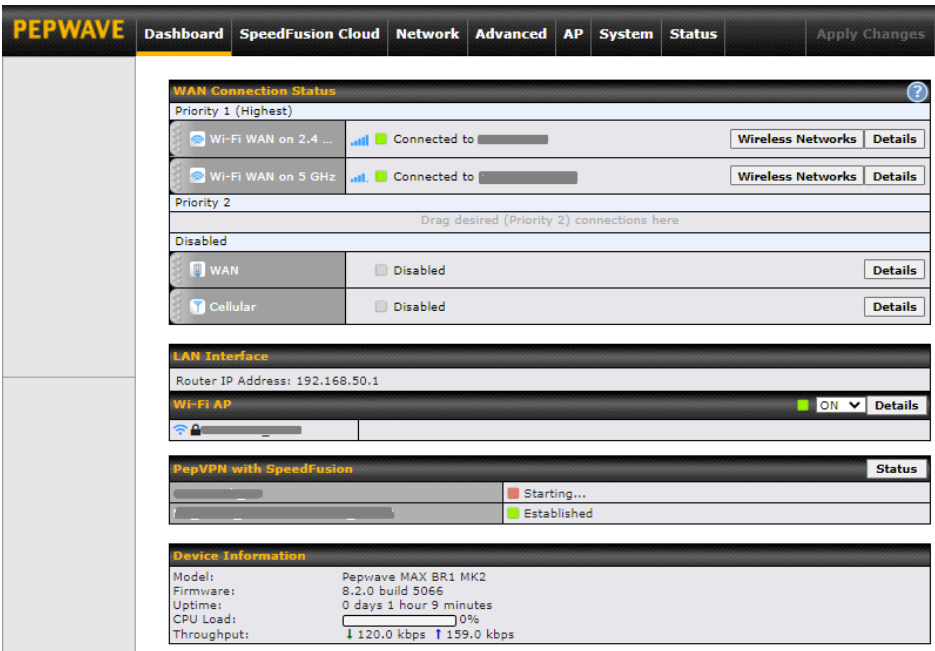
The Dashboard shows current WAN, LAN, and Wi-Fi AP statuses. Here, you can change WAN connection priority and switch on/off the Wi-Fi AP. For further information on setting up these connections, please refer to Sections 8 and 9.
Device Information displays details about the device, including model name, firmware version, and uptime. For further information, please refer to Section 22.
| Important Note |
| Configuration changes (e.g. WAN, LAN, admin settings, etc.) will take effect only after clicking the Save button at the bottom of each page. The Apply Changes button causes the changes to be saved and applied. |
Ch6. SpeedFusion Connect#
With Peplink products, your device is able to connect to SpeedFusion Connect without the use of a second endpoint. This service has wide access to a number of SpeedFusion endpoints hosted from around the world, providing your device with unbreakable connectivity wherever you are.*

*SpeedFusion Connect is supported in firmware version 8.1.0 and above. SpeedFusion Connect is a subscription basis. SpeedFusion Connect license can be purchased at https://estore.peplink.com/ > SpeedFusion Service > SpeedFusion Connect.
Activate SpeedFusion Connect Service#
All Care plans now come with SpeedFusion Connect included. This data allowance will automatically begin and end in accordance with your warranty. No activation is required.
Enable SpeedFusion Connect#
Access the Web Admin of the device you want to create as the Peplink Relay Server, navigating to the “SFC Protect” tab.
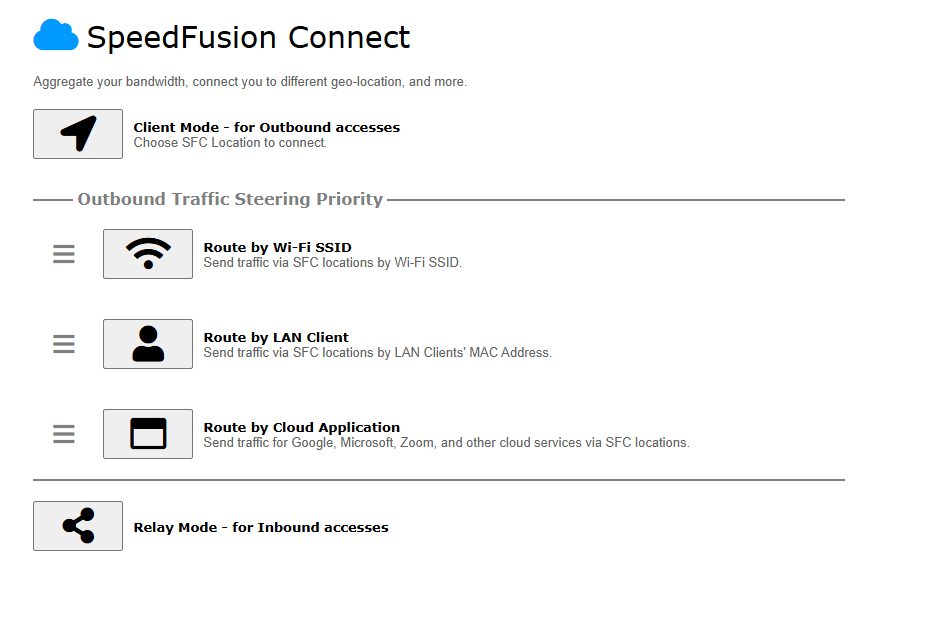
To setup a Peplink Relay Mode, select “Relay Mode – for Inbound accesses” > Choose the SFC Protect Location you wish to connect to > Click on the Green tick button to confirm the change.
User may also get the suggestions cloud location based on latency by click “here”.

The Protect private networks option blocks traffic from Relay Clients to private IP address ranges, including:
- 10.0.0.0/8
- 100.64.0.0/10
- 172.16.0.0/12
- 192.168.0.0/16
- 169.254.0.0/16
Enabling this option prevents access to these private networks from Relay Clients to protect your private networks and devices. This can improve the security of your local network against unwanted traffic from Relay Clients.

To block other devices from connecting, select “Block all except the allowed list” and add allowed devices serial number under the list.

The Relay Sharing Code will be generated, and other peers can use this code to establish a SpeedFusion Connect Protect that will forward the traffics to this device, allowing them to access local networks and the internet via your WAN connection.

To connect to SpeedFusion Connect Protect, you can select a SFC Protect Location of your choice, or simply and Automatic then the device will establish connection to the neareset SFC Protect server.
Choose Automatic > Click on the green tick button to confirm the change.

Or you may select Home Sharing and use your Relay Sharing Code to create a profile if you have set up a Peplink Relay Client on another device.

Click on Apply Changes to save the change.
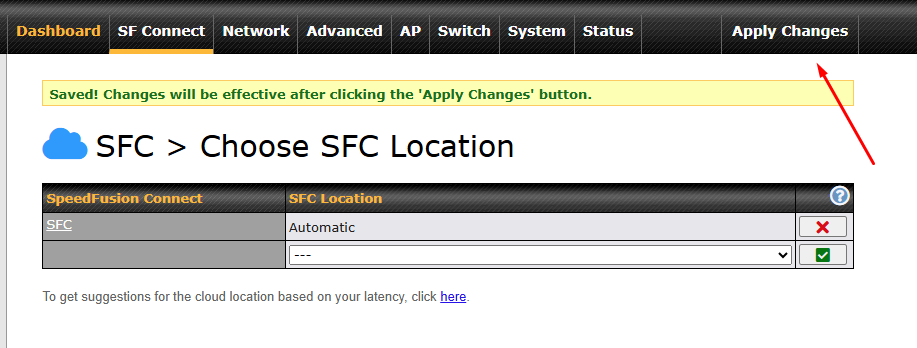
By default, the router will build a SpeedFusion tunnel to the SpeedFusion Connect Protect.

If you are running a latency sensitive service like video streaming or VOIP, a WAN Smoothing sub-tunnel can be created. Navigate to Navigate to SFC Protect > Client Mode – for Outbound accesses > SFC.

A SpeedFusion Connect Protect Profile configuration window will pop out. Click on the + sign to create the WAN Smoothing sub-tunnel.

Click on Save and Apply Changes to save the configuration. Now, the router has 2 Speedfusion tunnels to the SpeedFusion Connect Protect.

Data usage allowance is able to check from the below SpeedFusion Connect from Dashboard.
| Status | |
|---|---|
| Data usage allowance: [remaining data] (Expiry date: 2025 | Remaining SFC data usage occurs. |
| Fair usage policy (Expiry date: 2025) | Device with active care plan but exceeded SFC data usage. This mode will reduce the throughput to 10 Mbps |
Create an outbound policy to steer the internet traffic to go into SFC Protect. Please go to Advanced > Outbound Policy, click on Add Rule to create a new outbound policy.
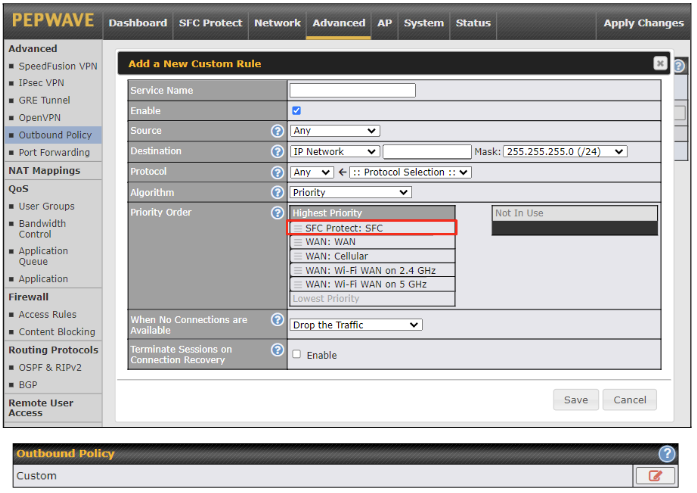
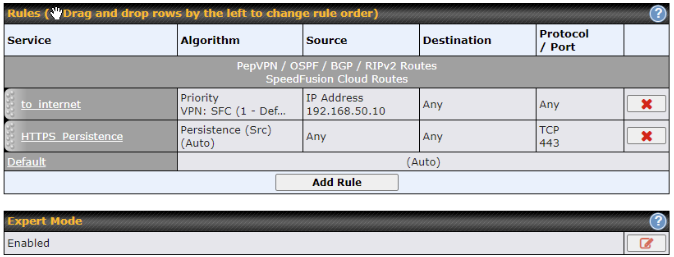
Route by Cloud Application#
Optimize Cloud Application allows you to route Internet traffic through SpeedFusion Connect Protect based on the application. Go to SFC Protect > Route by Cloud Application.

Select a Cloud application to route through SpeedFusion Connect Protect from the drop down list > Click ![]() > Save > Apply Changes.
> Save > Apply Changes.
Click the ![]() to remove a selected Cloud application from routing through SpeedFusion Connect Protect.
to remove a selected Cloud application from routing through SpeedFusion Connect Protect.
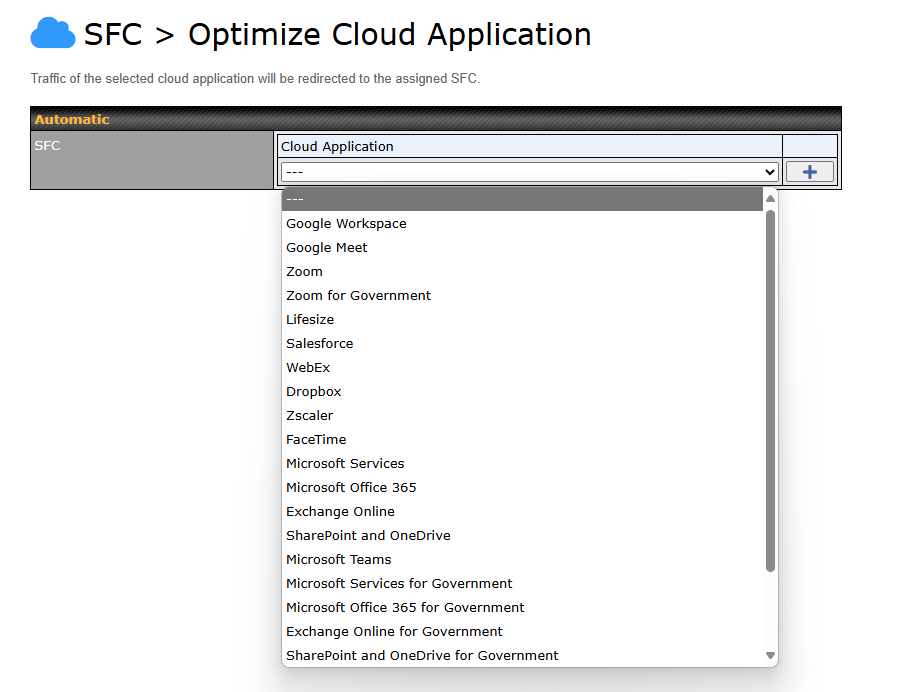
Route by Wi-Fi SSID#
SpeedFusion Connect Protect provides a convenient way to route the Wi-Fi client to the cloud from SFC Protect > Route by Wi-Fi SSID.
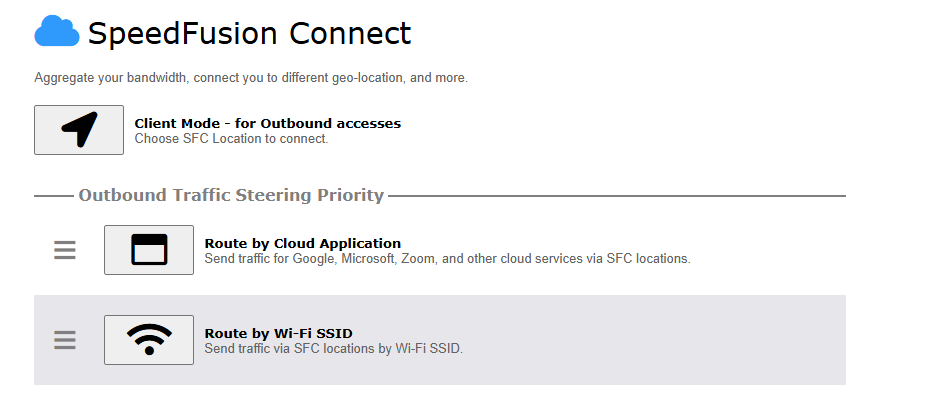
Create a new SSID for SFC Protect. The new SSID will inherit all settings from one of the existing SSIDs including the Security Policy. Then click Save followed by Apply Changes.

SFC Protect SSID will be shown on Dashboard.

Route by LAN Client#
SpeedFusion Connect Protect provides a convenient way to route the LAN client to the cloud from SFC Protect > Route by LAN Client.
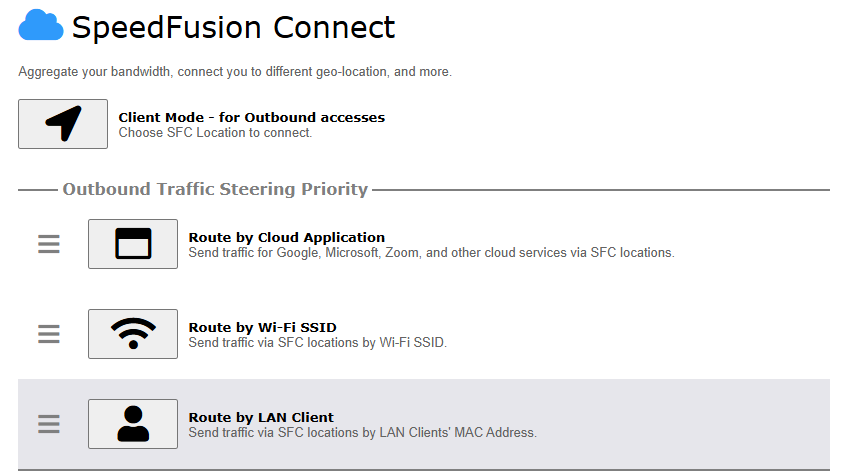
Choose a client from the drop down list > Click + > Save > Apply Changes.

Ch7. Configuring the LAN Interface(s)#
Basic Settings#
LAN interface settings are located at Network > LAN > Network Settings. Navigating to that page will show the following dashboard:

This represents the LAN interfaces that are active on your router (including VLAN). A gray “X” means that the VLAN is used in other settings and cannot be deleted. You can find which settings are using the VLAN by hovering over the gray “X”.
Alternatively, a red “X” means that there are no settings using the VLAN. You can delete that VLAN by clicking the red “X”
Clicking on any of the existing LAN interfaces (or creating a new one) will show the following :

| IP Settings | |
| IP Address | The IP address and subnet mask of the Pepwave router on the LAN. |

| Network Settings | |
| Name | Enter a name for the LAN. |
| VLAN ID | Enter a number for your VLAN. |
| Inter-VLAN routing | Check this box to enable routing between virtual LANs. |

| Layer 2 SpeedFusion VPN Bridging | |
| SpeedFusion VPN Profiles to Bridge | The remote network of the selected SpeedFusion VPN profiles will be bridged with this local LAN, creating a Layer 2 SpeedFusion VPN, they will be connected and operate like a single LAN, and any broadcast or multicast packets will be sent over the VPN. |
| Spanning Tree Protocol | Click the box will enable STP for this layer 2 profile bridge. |
| DHCP Option 82 | Click on the question Mark if you want to enable DHCP Option 82.
This allows the device to inject Option 82 with Router Name information before forwarding the DHCP Request packet to a SpeedFusion VPN peer, such that the DHCP Server can identify where the request originates from. |
| Override IP Address when bridge connected | Select “Do not override” if the LAN IP address and local DHCP server should remain unchanged after the Layer 2 SpeedFusion VPN is up.
If you choose to override the IP address when the VPN is connected, the device will not act as a router, and most Layer 3 routing functions will cease to work. |
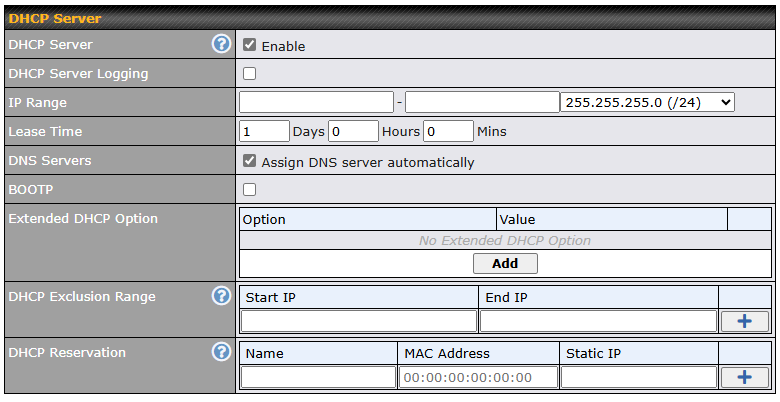
| DHCP Server Settings | |
| DHCP Server | When this setting is enabled, the Pepwave router’s DHCP server automatically assigns an IP address to each computer that is connected via LAN and configured to obtain an IP address via DHCP. The Pepwave router’s DHCP server can prevent IP address collisions on the LAN.
To enable DHCP bridge relay, please click the |
| DHCP Server Logging | Enable logging of DHCP events in the eventlog by selecting the checkbox. |
| IP Range | These settings allocate a range of IP addresses that will be assigned to LAN computers by the Pepwave router’s DHCP server. |
| Lease Time | This setting specifies the length of time throughout which an IP address of a DHCP client remains valid. Upon expiration of Lease Time, the assigned IP address will no longer be valid and the IP address assignment must be renewed. |
| DNS Servers | This option allows you to input the DNS server addresses to be offered to DHCP clients. If Assign DNS server automatically is selected, the Pepwave router’s built-in DNS server address (i.e., LAN IP address) will be offered. |
| BOOTP | Check this box to enable BOOTP on older networks that still require it. |
| Extended DHCP Option | In addition to standard DHCP options (e.g. DNS server address, gateway address, subnet mask), you can specify the value of additional extended DHCP options, as defined in RFC 2132. With these extended options enabled, you can pass additional configuration information to LAN hosts. To define an extended DHCP option, click the Add button, choose the option to define, and then enter its value. For values that are in IP address list format, you can enter one IP address per line in the provided text area input control. Each option can be defined once only. |
| DHCP Exclusion Range | To reserve a range of IP addresses from the DHCP pool, users may exclude a smaller range of IP addresses to avoid IP release behavior. Note: The start IP should be lower than the end IP, and both the start and end IPs should be within the range of the DHCP pool. |
| DHCP Reservation | This setting reserves the assignment of fixed IP addresses for a list of computers on the LAN. The computers to be assigned fixed IP addresses on the LAN are identified by their MAC addresses. The fixed IP address assignment is displayed as a cross-reference list between the computers’ names, MAC addresses, and fixed IP addresses.
Name (an optional field) allows you to specify a name to represent the device. MAC addresses should be in the format of 00:AA:BB:CC:DD:EE. Press |
To configure DHCP relay, first click the ![]() button found next to the DHCP Server option to display the settings.
button found next to the DHCP Server option to display the settings.

| DHCP Relay Settings | |
| Enable | Check this box to turn on DHCP relay. Click the |
| DHCP Server IP Address | Enter the IP addresses of one or two DHCP servers in the provided fields. The DHCP servers entered here will receive relayed DHCP requests from the LAN. For active-passive DHCP server configurations, enter active and passive DHCP server relay IP addresses in DHCP Server 1 and DHCP Server 2. |
| DHCP Option 82 | DHCP Option 82 includes device information as relay agent for the attached client when forwarding DHCP requests from client to server. This option also embeds the device’s MAC address and network name in circuit and remote IDs. Check this box to enable DHCP Option 82. |
| DHCP Relay Logging | Enable logging of DHCP Relay events in the eventlog by selecting the checkbox. |
Once DHCP is set up, configure LAN Physical Settings, Static Route Settings, and DNS Proxy Settings as noted above.

| Static Route Settings | |
| Static Route | This table is for defining static routing rules for the LAN segment. A static route consists of the network address, subnet mask, and gateway address. The address and subnet mask values are in w.x.y.z format.
The local LAN subnet and subnets behind the LAN will be advertised to the VPN. Remote routes sent over the VPN will also be accepted. Any VPN member will be able to route to the local subnets. Press |
A – Advanced feature, please click the ![]() button on the top right hand corner of the Static Route section to activate and configure Virtual Network Mapping to resolve network address conflict with remote peers.
button on the top right hand corner of the Static Route section to activate and configure Virtual Network Mapping to resolve network address conflict with remote peers.

In case of a network address conflict with remote peers (i.e. SpeedFusion VPN / IPsec VPN / IP Forwarding WAN are considered as remote connections), you can define Virtual Network Mapping to resolve it.
Note: OSPF & RIPv2 settings should be updated as well to avoid advertising conflicted networks.
For further details on virtual network mapping watch this video:
| Virtual Network Mapping | |
| One-to-One NAT | Every IP Address in the Local Network has a corresponding unique Virtual IP Address for NAT. Traffic originating from the Local Network to remote connections will be SNAT’ed and behave like coming from the defined Virtual Network. While traffic initiated by remote peers to the Virtual Network will be DNAT’ed accordingly. |
| Many-to-One NAT | The subnet range defined in Local Network will be mapped to a single Virtual IP Address for NAT. Traffic can only be initiated from local to remote, and these traffic will be NAT’ed and behaves like coming from the same Virtual IP Address. |
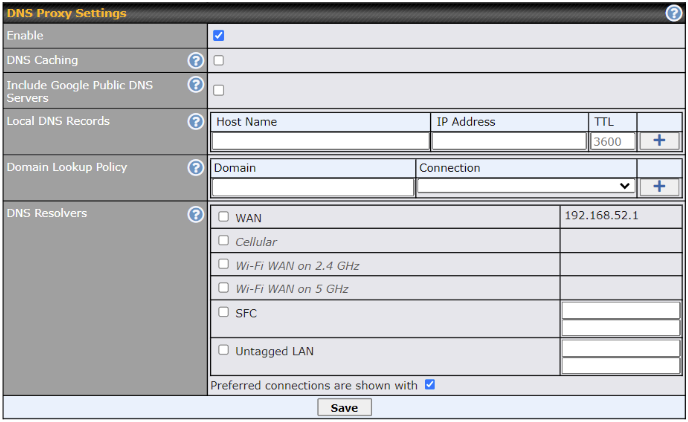
| DNS Proxy Settings | |
| Enable | To enable the DNS proxy feature, check this box, and then set up the feature at Network > LAN > DNS Proxy Settings. A DNS proxy server can be enabled to serve DNS requests originating from LAN/PPTP/SpeedFusionTM peers. Requests are forwarded to the DNS servers/resolvers defined for each WAN connection. |
| DNS Caching | This field is to enable DNS caching on the built-in DNS proxy server. When the option is enabled, queried DNS replies will be cached until the records’ TTL has been reached. This feature can help improve DNS lookup time. However, it cannot return the most up-to-date result for those frequently updated DNS records. By default, DNS Caching is disabled. |
| Include Google Public DNS Servers | When this option is enabled, the DNS proxy server will also forward DNS requests to Google’s Public DNS Servers, in addition to the DNS servers defined in each WAN. This could increase the DNS service’s availability. This setting is disabled by default. |
| Local DNS Records | This table is for defining custom local DNS records. A static local DNS record consists of a host name and IP address. When looking up the host name from the LAN to LAN IP of the Pepwave router, the corresponding IP address will be returned. Press |
| Domain Lookup Policy | DNS Proxy will lookup the domain names defined in this table using the specified connections only. |
| DNS Resolvers A | This field specifies which DNS servers can receive forwarded DNS requests. If no DNS server is selected, then all of them will be selected by default.
If you wish to select a SpeedFusion VPN peer, enter the IP address(es) of the VPN peer’s DNS server. Incoming queries will be forwarded to one of the selected servers. If none of the selected servers can be reached, then the router will forward incoming queries to all servers with healthy WAN connections. |
A – Advanced feature, please click the ![]() button on the top right hand corner to activate.
button on the top right hand corner to activate.
Finally, if needed, configure Bonjour forwarding, Apple’s zero configuration networking protocol. Once VLAN configuration is complete, click Save to store your changes.

| Bonjour Forwarding Settings | |
| Enable | Check this box to turn on Bonjour forwarding. |
| Bonjour Service | Choose Service and Client networks from the drop-down menus, and then click |
Drop-In Mode
Drop-in mode (or transparent bridging mode) eases the installation of the Pepwave MAX on a live network between the firewall and router, such that changes to the settings of existing equipment are not required.
The following diagram illustrates drop-in mode setup:
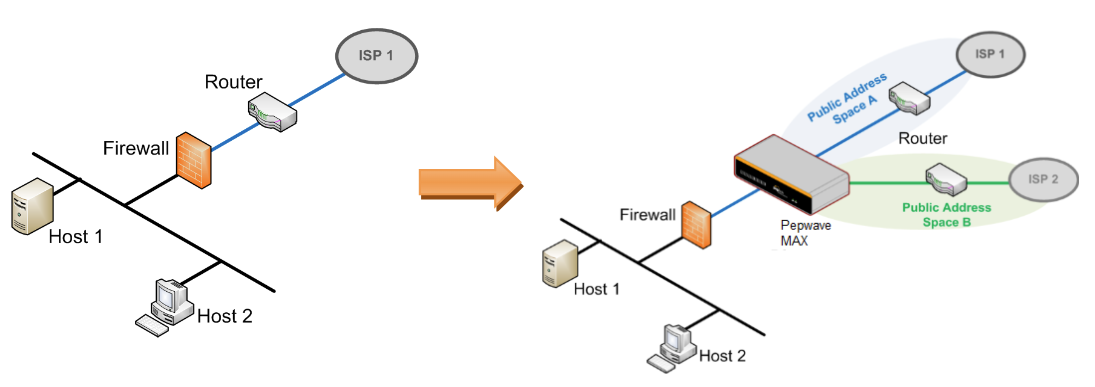
Check the box Enable to enable the Drop-in Mode. After enabling this feature and selecting the WAN for Drop-in mode, various settings including the WAN’s connection method and IP address will be automatically updated.
When drop-in mode is enabled, the LAN and the WAN for drop-in mode ports will be bridged. Traffic between the LAN hosts and WAN router will be forwarded between the devices. In this case, the hosts on both sides will not notice any IP or MAC address changes.
After successfully setting up the Pepwave MAX as part of the network using drop-in mode, it will, depending on model, support one or more WAN connections. Some MAX units also support multiple WAN connections after activating drop-in mode, though a SpeedFusion license may be required to activate more than one WAN port.
Please note the Drop-In Mode is mutually exclusive with VLAN.
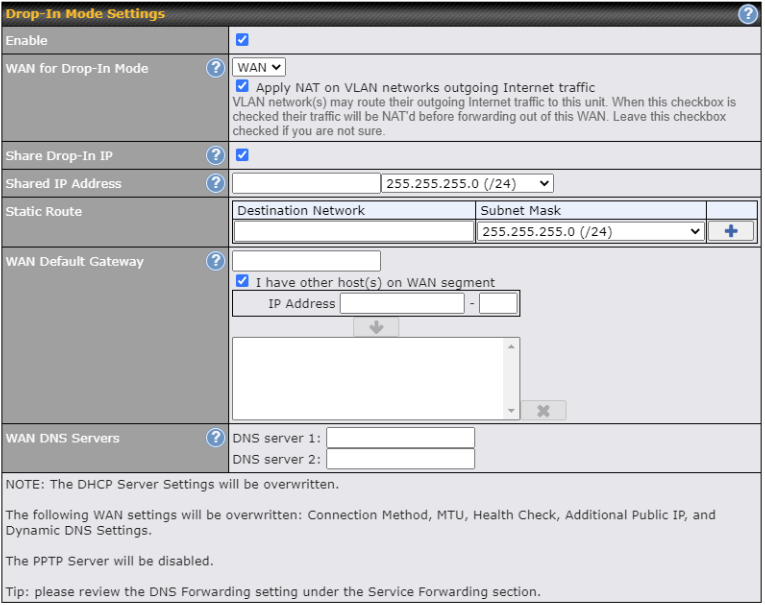
| Drop-in Mode Settings | |
| Enable | Drop-in mode eases the installation of the Pepwave MAX on a live network between the existing firewall and router, such that no configuration changes are required on existing equipment. Check the box to enable the drop-in mode feature. |
| WAN for Drop-In Mode | Select the WAN port to be used for drop-in mode. If WAN is selected, the high availability feature will be disabled automatically. |
| Shared Drop-In IPA | When this option is enabled, the passthrough IP address will be used to connect to WAN hosts (email notification, remote syslog, etc.). The MAX will listen for this IP address when WAN hosts access services provided by the MAX (web admin access from the WAN, DNS server requests, etc.).
To connect to hosts on the LAN (email notification, remote syslog, etc.), the default gateway address will be used. The MAX will listen for this IP address when LAN hosts access services provided by the MAX (web admin access from the WAN, DNS proxy, etc.). |
| Shared IP AddressA | Access to this IP address will be passed through to the LAN port if this device is not serving the service being accessed. The shared IP address will be used in connecting to hosts on the WAN (e.g., email notification, remote syslog, etc.) The device will also listen on the IP address when hosts on the WAN access services served on this device (e.g., web admin accesses from WAN, DNS server, etc.) |
| WAN Default Gateway | Enter the WAN router’s IP address in this field. If there are more hosts in addition to the router on the WAN segment, click the |
| WAN DNS Servers | Enter the selected WAN’s corresponding DNS server IP addresses. |
A – Advanced feature, please click the ![]() button on the top right-hand corner to activate.
button on the top right-hand corner to activate.
Port Settings#
To configure port settings, navigate to Network > Port Settings

On this screen, you can enable specific ports, as well as determine the speed of the LAN ports, whether each port is a trunk or access port, as well as which VLAN each link belongs to, if any.
Captive Portal#
The captive portal serves as a gateway that clients have to pass if they wish to access the internet using your router. To configure, navigate to Network > LAN > Captive Portal.
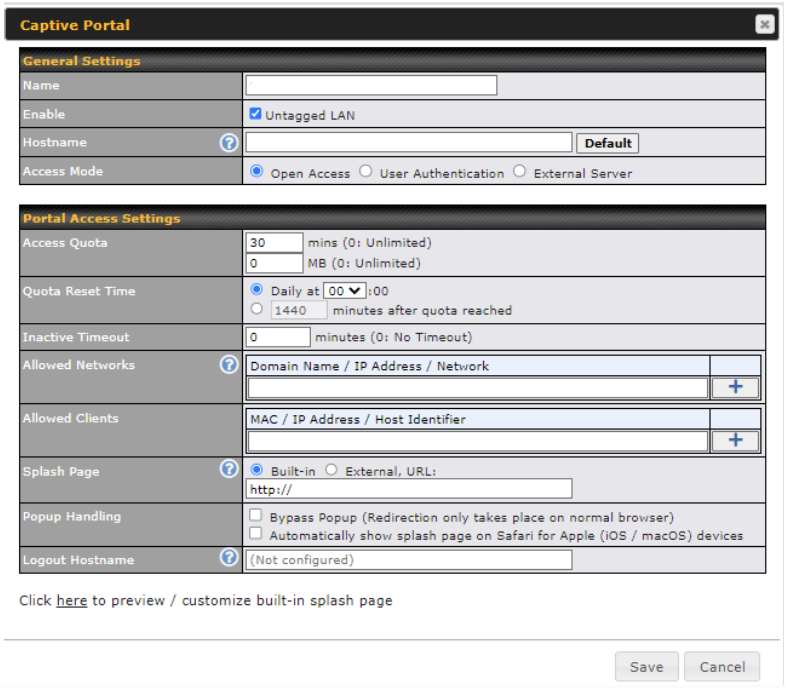
| Captive Portal Settings | |
| Name | Enter the name for the Captive Portal. |
| Enable | Check Enable and then, optionally, select the LANs/VLANs that will use the captive portal. |
| Hostname | To customize the portal’s form submission and redirection URL, enter a new URL in this field. To reset the URL to factory settings, click Default. |
| Access Mode | Click Open Access to allow clients to freely access your router. Click User Authentication to force your clients to authenticate before accessing your router.
Select External Server to use the Captive Portal with a HotSpot system. As described in the following knowledgebase article: https://forum.peplink.com/t/using-hotspotsystem-wi-fi-on-pepwave-max-routers/ |
| Authentication | When selecting the “User Authentication” in the Access Mode field, you will see the available option for the Authentication via drop-down list:
Fill in the necessary information to complete your connection to the server and enable authentication. |
| External Server | When selecting the “External Server” in the Access Mode field, you will see the available option for the Service Type via drop-down list:
Fill in the necessary information to complete your connection to the server and enable authentication. |
| Access Quota | Set a time and data cap to each user’s Internet usage. |
| Quota Reset Time | This menu determines how your usage quota resets. Setting it to Daily will reset it at a specified time every day. Setting a number of minutes after quota reached establish a timer for each user that begins after the quota has been reached. |
| Inactive Timeout | Clients will get disconnected when the inactive the configured time is reached. Default 0: no timeout |
| Allowed Networks | Add networks that can bypass the captive Portal in this field. To whitelist a network, enter the domain name / IP address here and click |
| Allowed Clients | Add MAC address and /or IP addresses for client devices that are allowed to bypass the Captive Portal. Clients accessing these domains and IP addresses will not be redirected to the splash page. |
| Splash Page | Here, you can choose between using the Pepwave router’s built-in captive portal and redirecting clients to a URL you define. |
| Popup Handling | Configurable options for popup handling: – Bypass Popup (Redirection only takes place on normal browser) – Automatically show splash page on Safari for Apple (iOS / macOS) devices |
| Logout Hostname | A hostname that can be used to logout captive portal when being accessed on browser. |
| Customize splash page | Click on the provided link in the Captive portal profile to customize the splash page.
A new browser tab is opened with a WYSIWYG editor of the splash page |
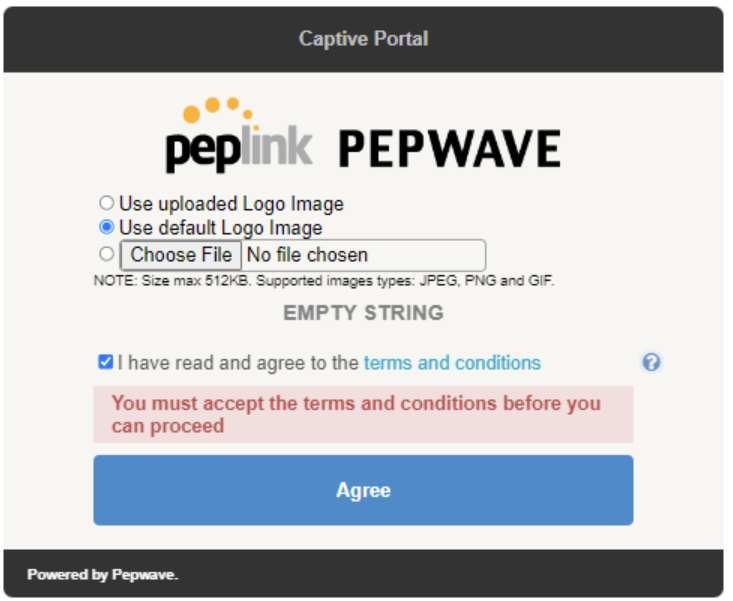
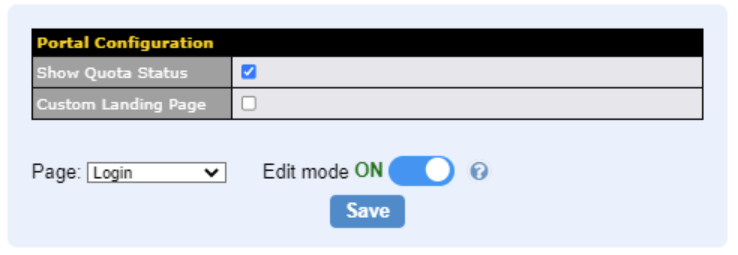
Ch8. Configuring the WAN Interface(s)#
WAN Interface settings are located at Network>WAN. To reorder WAN priority, drag on the appropriate WAN by holding the left mouse button, move it to the desired priority (the first one would be the highest priority, the second one would be lower priority, and so on), and drop it by releasing the mouse button.
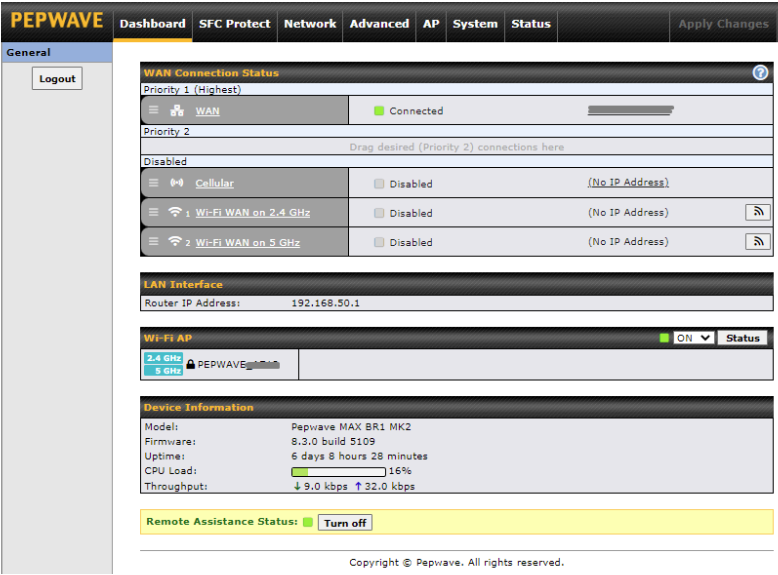
To able a particular WAN connection, drag on the appropriate WAN by holding the left mouse button, move it the Disabled row, and drop it by releasing the mouse button.
You can also set priorities on the Dashboard. Click the WAN button in the corresponding row to modify the connection setting.
| Important Note |
| Connection details will be changed and become effective immediately after clicking the Save and Apply button. |
DNS over HTTPS (DoH)

You can enable DoH (DNS over HTTPS) support in this section.

| DNS over HTTPS | |
| Enable | When this option is enabled, the DNS proxy server will use HTTPS connections to forward DNS requests to the DoH resolver; it will not fallback to traditional UDP DNS options. |
| Server | The options to configure DoH with a predefined server are:
|
Cellular WAN Airplane Mode

You can enable Airplane Mode in this section (Network > WAN). Airplane mode will be turned ON when Cellular WAN Connections are disabled.

WAN Quality Monitoring
This settings advice how WAN Quality information is being gathered.

By default, WAN Quality will always be observed and gathered automatically. With customized choice of WAN connections, the device will always observe WAN Quality of those selected WAN connections. Other WAN connections may stop observing WAN Quality information if it is not necessary for the underlying features.
Synergy Mode
You can enable the Synergy Controller in this section.

You may click this ![]() to enable the Synergy Controller. By default, the setting is disabled.
to enable the Synergy Controller. By default, the setting is disabled.
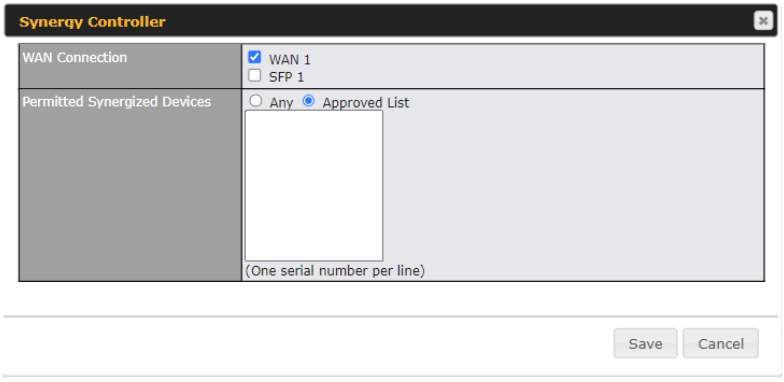
You may select the WAN connection to use as a Synegy Link which will connect to synergized devices.
Starlink WAN
On supported models (refer to Firmware 8.4.0 – Release Notes, #30479), under the WAN settings page, users can see the option for Starlink at the bottom of the page.
To choose the WAN port for connecting to Starlink equipment, click the ‘EDIT’ (![]() ) icon as shown below:
) icon as shown below:

The ‘Starlink – WAN Connection’ selection will pop up, displaying the available options below.
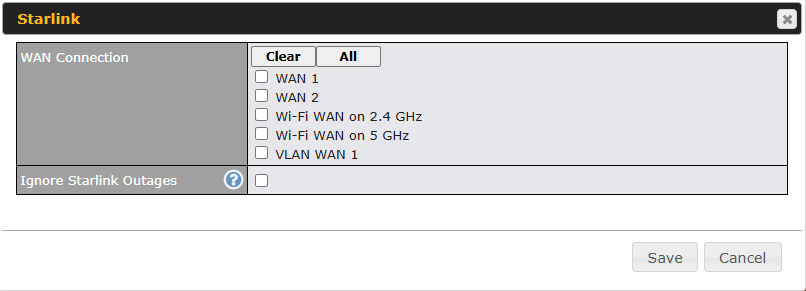
| Starlink | |
| WAN connection | WAN option to enable Starlink management. |
| Ingnore Starlink Outages | Enable the device to ignore all outages (e.g., obstructed, no downlink, no pings).
The WAN will only go down when its health check fails. |
Ethernet WAN#
DHCP Connection#
The DHCP connection method is suitable if the ISP provides an IP address automatically using DHCP (e.g., satellite modem, WiMAX modem, cable, Metro Ethernet, etc.).
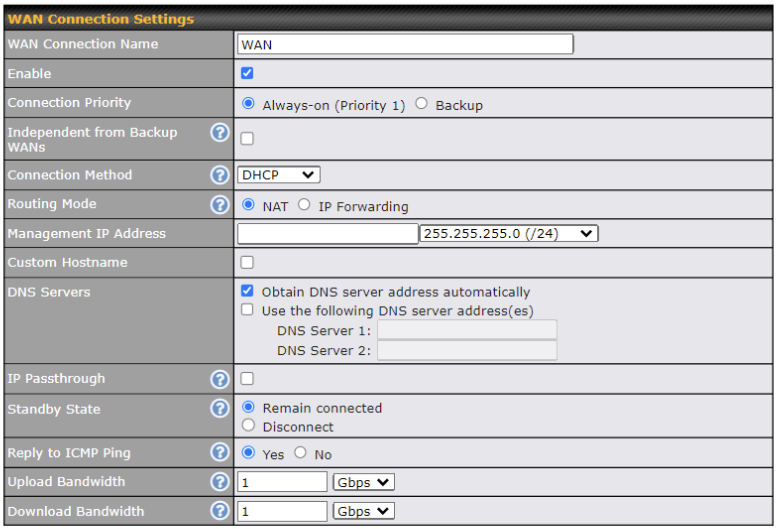
| DHCP Connection Settings | |
| WAN Connection Name | Enter a name to represent this WAN connection. |
| Enable | This setting enables the WAN connection. If schedules have been defined, you will be able to select a schedule to apply to the connection. |
| Connection Priority | This option allows you to configure the WAN connection whether for normal daily usage or as a backup connection only.
If Always-on is chosen, the WAN connection will be kept on continuously, regardless of the priority of other WAN connections. If Backup is chosen, the WAN connection will depend on other WAN connections. It will not be used when one or more higher priority dependent WAN connections are connected. |
| Independent from Backup WANs | If this is checked, the connection will be working independent from other Backup WAN connections. Those in Backup Priority will ignore the status of this WAN connection, and will be used when none of the other higher priority connections are available. |
| Routing Mode | NAT allows substituting the real address in a packet with a mapped address that is routable on the destination network. By clicking the help |
| Management IP Address | Management IP Address is available for configuration when you click here for other DHCP settings.
This option allows you to configure the management IP address for the DHCP WAN connection. |
| Custom Hostname | If your service provider’s DHCP server requires you to supply a hostname value upon acquiring an IP address, you may enter the value here. If your service provider does not provide you with the value, you can safely bypass this option. |
| DNS Servers | Each ISP may provide a set of DNS servers for DNS lookups. This setting specifies the DNS (Domain Name System) servers to be used when a DNS lookup is routed through this connection.
Selecting Obtain DNS server address automatically results in the DNS servers being assigned by the WAN DHCP server to be used for outbound DNS lookups over the connection. (The DNS servers are obtained along with the WAN IP address assigned from the DHCP server.) When Use the following DNS server address(es) is selected, you may enter custom DNS server addresses for this WAN connection into the DNS Server 1 and DNS Server 2 fields. |
| IP Passthrough | When this IP Passthrough option is active, after the ethernet WAN connection is up, the router’s DHCP server will offer the connection’s IP address to one LAN client. All incoming or outgoing traffic will be routed without NAT.
Regardless the WAN connection’s state, the router always binds to the LAN IP address (Default: 192.168.50.1). So when the ethernet WAN is connected, the LAN client could access the router’s web admin by manually configuring its IP address to the same subnet as the router’s LAN IP address (e.g. 192.168.50.10). Note: when this option is firstly enabled, the LAN client may not be able to refresh its IP address to the ethernet WAN IP address in a timely fashion. The LAN client may have to manually renew its IP address from DHCP server. After this option is enabled, the DHCP lease time will be 2 minutes. I.e. the LAN client could refresh its IP address and access the network at most one minute after the ethernet WAN connection goes up. |
| Standby State | This option allows you to choose whether to remain connected when this WAN connection is no longer in the highest priority and has entered the standby state. When Remain connected is chosen, upon bringing up this WAN connection to active, it will be immediately available for use.
If this WAN connection is charged by connection time, you may want to set this option to Disconnect so that connection will be made only when needed. SpeedFusion VPN may use connected standby WAN for failover if link failure detected on the higher priority WAN, you can set this option to Disconnect to avoid data passing through. |
| Reply to ICMP PING | If the checkbox is unticked, this option is disabled and the system will not reply to any ICMP ping echo requests to the WAN IP addresses of this WAN connection.
Default: ticked (Yes) |
| Upload Bandwidth | This field refers to the maximum upload speed.
This value is referenced when default weight is chosen for outbound traffic and traffic prioritization. A correct value can result in effective traffic prioritization and efficient use of upstream bandwidth. |
| Download Bandwidth | This field refers to the maximum download speed.
Default weight control for outbound traffic will be adjusted according to this value. |
Static IP Connection#
The Static IP connection method is suitable if your ISP provides a static IP address to connect directly.

| Static IP Settings | |
| Routing Mode | NAT allows substituting the real address in a packet with a mapped address that is routable on the destination network. By clicking the help icon in this field, you can display the IP Forwarding option, if your network requires it. |
| IP Address / Subnet Mask / Default Gateway | These settings allow you to specify the information required in order to communicate on the Internet via a fixed Internet IP address. The information is typically determined by and can be obtained from the ISP. |
| DNS Servers | Each ISP may provide a set of DNS servers for DNS lookups. This setting specifies the DNS (Domain Name System) servers to be used when a DNS lookup is routed through this connection.
Selecting Obtain DNS server address automatically results in the DNS servers being assigned by the WAN DHCP server to be used for outbound DNS lookups over the connection. (The DNS servers are obtained along with the WAN IP address assigned from the DHCP server. When Use the following DNS server address(es) is selected, you may enter custom DNS server addresses for this WAN connection into the DNS Server 1 and DNS Server 2 fields. |
PPPoE Connection#
The PPPoE connection method is suitable if your ISP provides a login ID/password to connect via PPPoE.
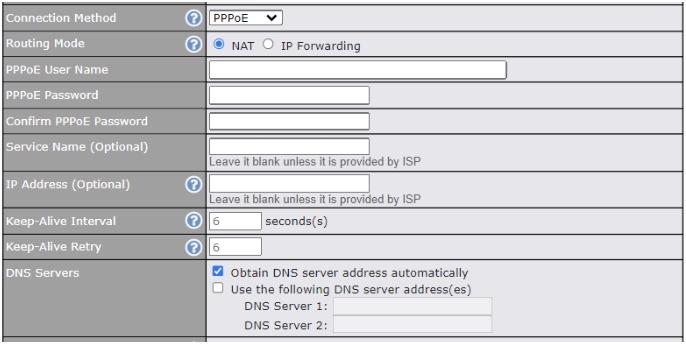
| PPPoE Settings | |
| Routing Mode | NAT allows substituting the real address in a packet with a mapped address that is routable on the destination network. By clicking the help icon in this field, you can display the IP Forwarding option, if your network requires it. |
| PPPoE Username / Password | Enter the required information in these fields in order to connect via PPPoE to the ISP. The parameter values are determined by and can be obtained from the ISP. |
| Confirm PPPoE Password | Verify your password by entering it again in this field. |
| Service Name (Optional) | Service name is provided by the ISP.
Note: Leave this field blank unless it is provided by your ISP. |
| IP Address (Optional) | If your ISP provides a PPPoE IP address, enter it here.
Note: Leave this field blank unless it is provided by your ISP. |
| Keep Alive Interval | This is the time interval between each Keep-Alive packet. |
| Keep-Alive Retry | This is the number of consecutive Keep-Alive check failures before treating PPPoE connection as down. |
| DNS Servers | Each ISP may provide a set of DNS servers for DNS lookups. This setting specifies the DNS (Domain Name System) servers to be used when a DNS lookup is routed through this connection.
Selecting Obtain DNS server address automatically results in the DNS servers being assigned by the WAN DHCP server to be used for outbound DNS lookups over the connection. (The DNS servers are obtained along with the WAN IP address assigned from the DHCP server.) When Use the following DNS server address(es) is selected, you may enter custom DNS server addresses for this WAN connection into the DNS Server 1 and DNS Server 2 fields. |
L2TP Connection#
L2TP has all the compatibility and convenience of PPTP with greater security. Combine this with IPsec for a good balance between ease of use and security.
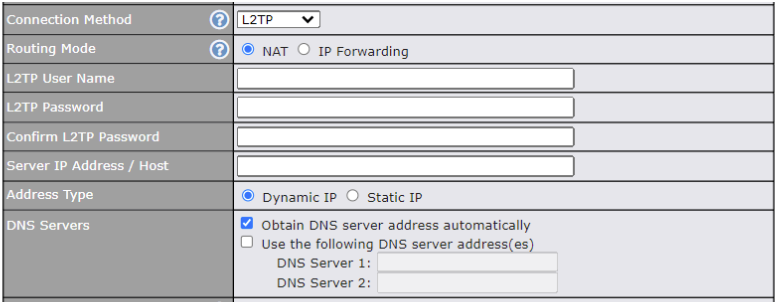
| L2TP Settings | |
| Routing Mode | NAT allows substituting the real address in a packet with a mapped address that is routable on the destination network. By clicking the help icon in this field, you can display the IP Forwarding option, if your network requires it. |
| L2TP Username / Password | Enter the required information in these fields in order to connect via L2TP to your ISP.
The parameter values are determined by and can be obtained from your ISP. |
| Confirm L2TP Password | Verify your password by entering it again in this field. |
| Server IP Address / Host | L2TP server address is a parameter which is provided by your ISP.
Note: Leave this field blank unless it is provided by your ISP. |
| Address Type | Your ISP will also indicate whether the server IP address is Dynamic or Static. Please click the appropriate value. |
| DNS Servers | Each ISP may provide a set of DNS servers for DNS lookups. This setting specifies the DNS (Domain Name System) servers to be used when a DNS lookup is routed through this connection.
Selecting Obtain DNS server address automatically results in the DNS servers assigned by the PPPoE server to be used for outbound DNS lookups over the WAN connection. (The DNS servers are obtained along with the WAN IP address assigned from the PPPoE server.) When Use the following DNS server address(es) is selected, you can enter custom DNS server addresses for this WAN connection into the DNS server 1 and DNS server 2 fields. |
GRE Connection#
This connection method is suitable if your ISP provides a static WAN IP and Tunnel IP via GRE.
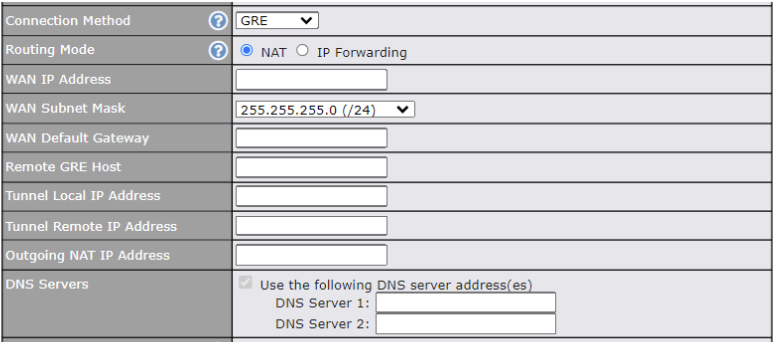
| GRE Settings | |
| Routing Mode | NAT allows substituting the real address in a packet with a mapped address that is routable on the destination network. By clicking the help icon in this field, you can display the IP Forwarding option, if your network requires it. |
| WAN IP Address / Subnet Mask / Default Gateway | These settings allow you to specify the information required in order to communicate on the Internet via a fixed Internet IP address. The information is typically determined by and can be obtained from the ISP. |
| Remote GRE Host | This field allows you to enter the IP address of the remote GRE. |
| Tunnel Local IP Address | This field allows you to enter the IP address of the local tunnel for the GRE tunnel connection. |
| Tunnel Remote IP Address | This field allows you to enter the IP address of the remote tunnel for the GRE tunnel connection. |
| Outgoing NAT IP Address | This field is to enter the NAT IP address for outgoing via GRE tunnel. |
| DNS Servers | Each ISP may provide a set of DNS servers for DNS lookups. This setting specifies the DNS (Domain Name System) servers to be used when a DNS lookup is routed through this connection.
Selecting Obtain DNS server address automatically results in the DNS servers assigned by the PPPoE server to be used for outbound DNS lookups over the WAN connection. (The DNS servers are obtained along with the WAN IP address assigned from the PPPoE server.) When Use the following DNS server address(es) is selected, you can enter custom DNS server addresses for this WAN connection into the DNS server 1 and DNS server 2 fields. |
Cellular WAN#

To access/configure the Cellular WAN settings, click Network > Cellular Name. You may click the “No IP Address“ link to view the Cellular WAN details/status.

| WAN Connection Status | |
| IMSI | This is the International Mobile Subscriber Identity which uniquely identifies the SIM card. This is applicable to 3G modems only. |
| ICCID | This is a unique number assigned to a SIM card used in a cellular device. |
| MTN | Thi field is to display the mobile telephone number of the SIM card. |
| MEID | Some Pepwave routers support both HSPA and EV-DO. For Sprint or Verizon Wireless EV-DO users, a unique MEID identifier code (in hexadecimal format) is used by the carrier to associate the EV-DO device with the user. This information is presented in hex and decimal format. |
| IMEI | This is the unique ID for identifying the modem in GSM/HSPA mode. |
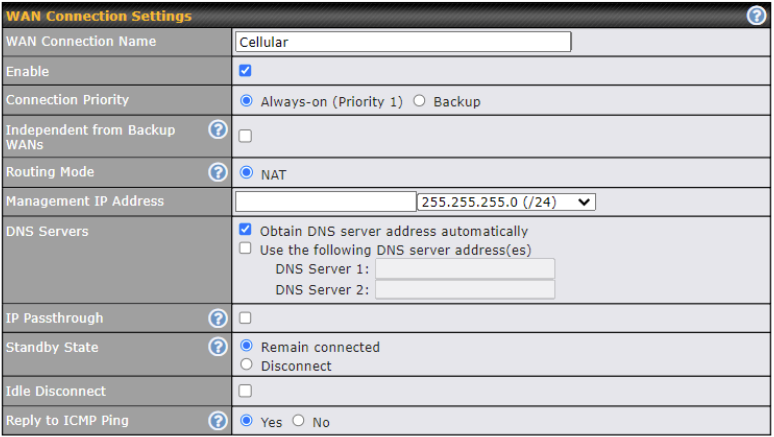
| WAN Connection Settings | |
| WAN Connection Name | Indicate a name you wish to give this Cellular WAN connection |
| Enable | Click the checkbox to toggle the on and off state of this connection. |
| Connection Priority | This option allows you to configure the WAN connection whether for normal daily usage or as a backup connection only.
If Always-on is chosen, the WAN connection will be kept on continuously, regardless of the priority of other WAN connections. If Backup is chosen, the WAN connection will depend on other WAN connections. It will not be used when one or more higher priority dependent WAN connections are connected. |
| Independent from Backup WANs | If this is checked, the connection will be working independent from other Backup WAN connections. Those in Backup Priority will ignore the status of this WAN connection, and will be used when none of the other higher priority connections are available. |
| Routing Mode | This option allows you to select the routing method to be used in routing IP frames via the WAN connection. The mode can be either NAT (Network Address Translation) or IP Forwarding.
In the case if you need to choose IP Forwarding for your scenario. Click the |
| Management IP Address | Management IP Address is available for configuration when you click here for other DHCP settings.
This option allows you to configure the management IP address for the DHCP WAN connection. |
| DNS Servers | Each ISP may provide a set of DNS servers for DNS lookups. This setting specifies the DNS (Domain Name System) servers to be used when a DNS lookup is routed through this connection.
Selecting Obtain DNS server address automatically results in the DNS servers assigned by the WAN DHCP server being used for outbound DNS lookups over the connection. (The DNS servers are obtained along with the WAN IP address assigned by the DHCP server.) When Use the following DNS server address(es) is selected, you may enter custom DNS server addresses for this WAN connection into the DNS server 1 and DNS server 2 fields. |
| IP Passthrough | When this IP Passthrough option is active, after the cellular WAN connection is up, the router’s DHCP server will offer the connection’s IP address to one LAN client. All incoming or outgoing traffic will be routed without NAT.
Regardless the WAN connection’s state, the router always binds to the LAN IP address (Default: 192.168.50.1). So when the cellular WAN is connected, the LAN client could access the router’s web admin by manually configuring its IP address to the same subnet as the router’s LAN IP address (e.g. 192.168.50.10). Note: when this option is firstly enabled, the LAN client may not be able to refresh its IP address to the cellular WAN IP address in a timely fashion. The LAN client may have to manually renew its IP address from DHCP server. After this option is enabled, the DHCP lease time will be 2 minutes. I.e. the LAN client could refresh its IP address and access the network at most one minute after the cellular WAN connection goes up |
| Standby State | This option allows you to choose whether to remain connected or disconnected when this WAN connection is no longer in the highest priority and has entered the standby state. When Remain connected is chosen, bringing up this WAN connection to active makes it immediately available for use. |
| Idle Disconnect | If this is checked, the connection will disconnect when idle after the configured Time value. This option is disabled by default. |
| Reply to ICMP PING | If the checkbox is unticked, this option is disabled and the system will not reply to any ICMP ping echo requests to the WAN IP addresses of this WAN connection.
Default: ticked (Yes) |
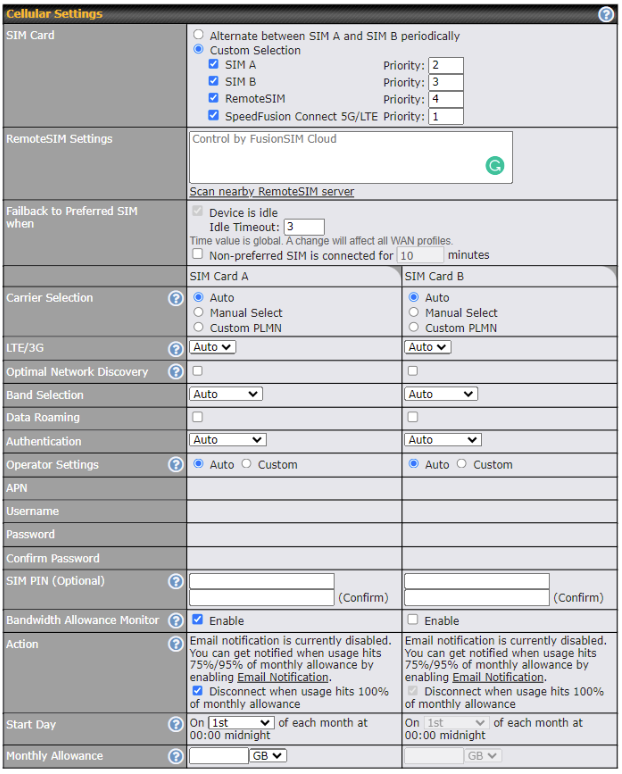
| Cellular Settings | |
| SIM Card | If “Alternate between SIM A and SIM B periodically” is selected, the SIM card will be switching according to the schedule time in the SIM Cards Alternate.
If “Custom Selection” is selected, you can designate the priority of the SIM cards (SIM A/ SIM B/ Remote SIM/ SpeedFusion Connect) and connect to. For routers that support the SIM Injector, you may select the “Remote SIM” to provision a SIM from a SIM Injector. Further details on the SIM Injector found is available here: https://www.peplink.com/products/sim-injector/. |
| Remote SIM Settings | If “Use Remote SIM Only” is selected in the SIM card section, the Remote SIM Settings will be shown.
You may need to enable the remote SIM Host settings in the Remote SIM management, see the section 22.10 or Appendix B for more details on FusionSIM. After that, click on “Scan nearby remote SIM server” to show the serial number(s) of the connected SIM Injector(s). If you want to select a specific SIM, in the Cellular Settings, type “:” and then the number of the SIM slot, eg.1111-2222-3333:7. |
| Fallback to Prefered SIM when | This option is allowing to switch to another SIM cards when the Cellular WAN reached fallback timeout. |
| SIM Cards Alternate | If “Alternate between SIM A and SIM B periodically” is selected in the SIM Card section, the SIM Cards Alternate will be shown:
You may set the schedule time for for switching between SIM A only and SIM B only. |
| 5G/LTE/3G | This drop-down menu allows restricting cellular to particular band. Click the |
| Optimal Network Discovery | Cellular WANs by default will only handover from 3G to LTE network when there is no active data traffic, enable this option will make it run the handover procedures after fallback to 3G for a defined effective period, even this may interrupt the connectivity for a short while. |
| Band Selection | When set to Auto, band selection allows for automatically connecting to available, supported bands (frequencies) . When set to Manual, you can manually select the bands (frequencies) the SIM will connect to. |
| Data Roaming | This checkbox enables data roaming on this particular SIM card. When data roaming is enabled this option allows you to select in which countries the SIM has a data connection. The option is configured by using MMC (country) codes.Please check your service provider’s data roaming policy before proceeding. |
| Authentication | Choose from PAP Only or CHAP Only to use those authentication methods exclusively. Select Auto to automatically choose an authentication method. |
| Operator Settings | This setting allows you to configure the APN settings of your connection. If Auto is selected, the mobile operator should be detected automatically. The connected device will be configured and connection will be made automatically. If there is any difficulty in making connection, you may select Custom to enter your carrier’s APN, Login, Password, and Dial Number settings manually. The correct values can be obtained from your carrier. The default and recommended setting is Auto. |
| APN / Login / Password / SIM PIN | When Auto is selected, the information in these fields will be filled automatically. Select Custom to customize these parameters. The parameter values are determined by and can be obtained from the ISP. |
| Bandwidth Allowance Monitor | Check the box Enable to enable bandwidth usage monitoring on this WAN connection for each billing cycle. When this option is not enabled, bandwidth usage of each month is still being tracked but no action will be taken. |
| Action | If email notification is enabled, you will be notified by email when usage hits 75% and 95% of the monthly allowance. If Disconnect when usage hits 100% of monthly allowance is checked, this WAN connection will be disconnected automatically when the usage hits the monthly allowance. It will not resume connection unless this option has been turned off or the usage has been reset when a new billing cycle starts. |
| Start Day | This option allows you to define which day of the month each billing cycle begins. |
| Monthly Allowance | This field is for defining the maximum bandwidth usage allowed for the WAN connection each month. |
Signal Threshold Settings

If signal threshold is defined, this connection will be treated as down when a weaker than threshold signal is determined.
The following values are used by the threshold scale:

To define the threshold manually using specific signal strength values, please click on the question Mark and the following field will be visible.

Wi-Fi WAN#

To access/configure the Cellular WAN settings, click Network > Wi-Fi WAN Connection Name.
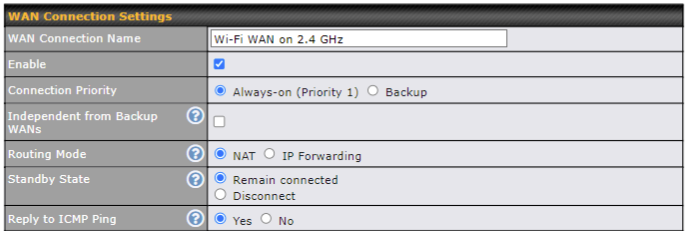
| WAN Connection Settings | |
| WAN Connection Name | Enter a name to represent this Wi-Fi WAN connection. |
| Enable | Click the checkbox to toggle the on and off state of this connection. |
| Connection Priority | This option allows you to configure the WAN connection whether for normal daily usage or as a backup connection only.
If Always-on is chosen, the WAN connection will be kept on continuously, regardless of the priority of other WAN connections. If Backup is chosen, the WAN connection will depend on other WAN connections. It will not be used when one or more higher priority dependent WAN connections are connected. |
| Independent from Backup WANs | If this is checked, the connection will be working independent from other Backup WAN connections. Those in Backup Priority will ignore the status of this WAN connection, and will be used when none of the other higher priority connections are available. |
| Routing Mode | This option allows you to select the routing method to be used in routing IP frames via the WAN connection. The mode can be either NAT (Network Address Translation) or IP Forwarding.
In the case if you need to choose IP Forwarding for your scenario. Click the |
| Standby State | This setting specifies the state of the WAN connection while in standby. The available options are Remain Connected and Disconnect. |
| Reply to ICMP PING | If this setting is disabled, the WAN connection will not respond to ICMP ping requests. By default, this setting is enabled. |
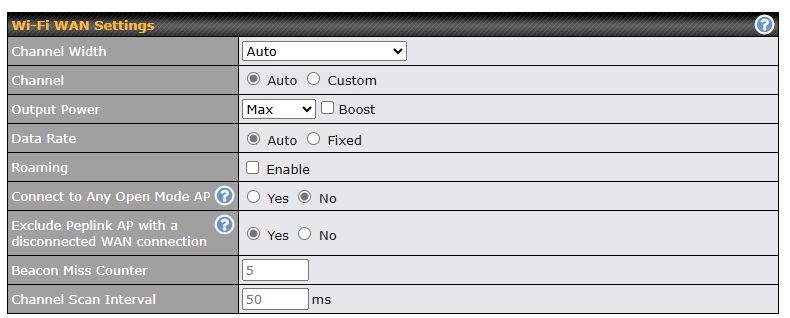
| Wi-Fi WAN Settings | |
| Channel Width | Select the channel width for this Wi-Fi WAN. 20MHz provides better support for older devices using 2.4Ghz, while 40MHz is appropriate for networks with newer devices connecting using 5Ghz. |
| Channel | Select whether to automatically select the channel. If you select Custom, the following table will appea
|
| Output Power | If you are setting up a network with many Wi-Fi devices in close proximity, you can configure the output power here. Click the Boost button for additional power. However, with this option selected, the output power may exceed local regulatory limits. |
| Data Rate | Selecting Auto will allow the router to automatically determine the best data rate, while manually selecting a rate will force devices to connect at the fixed rate. |
| Roaming | Select this check box to enable Wi-Fi roaming. Click the |
| Connect to Any Open Mode AP | This option determines whether the Wi-Fi WAN will connect to any open mode access points it finds. |
| Exclude Peplink AP with a disconnected WAN connection | If Yes is selected, it will perform a WAN connection status check on the Peplink access points it finds. Access points with a broken WAN connection will be ignored. |
| Beacon Miss Counter | This sets the threshold for the number of missed beacons. Click the |
| Channel Scan Interval | Configure Channel Scan Interval in ms. Click the |
Creating Wi-Fi Connection Profiles
You can manually create a profile to connect to a Wi-Fi connection. This is useful for creating a profile for connecting to hidden-SSID access points. Click Network > Wi-Fi WAN > Create Profile… to get started.

This will open a window similar to the one shown below
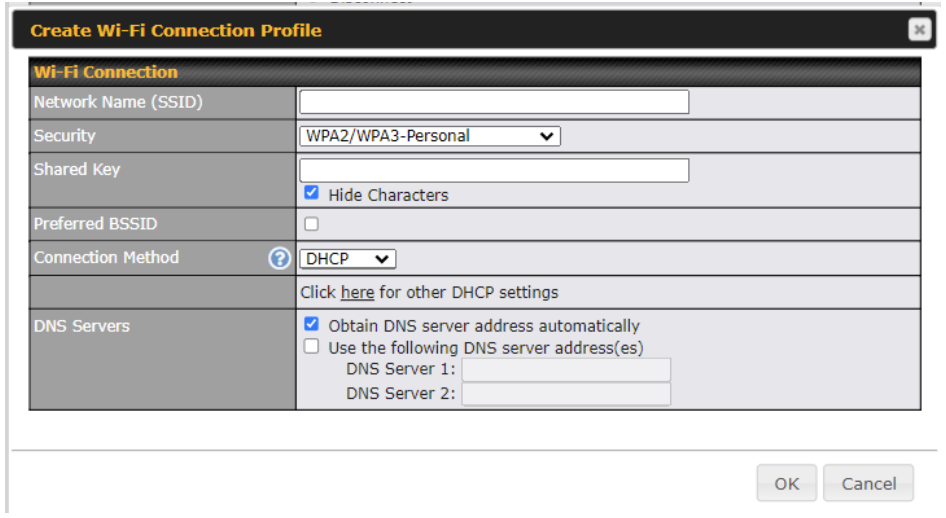
| Wi-Fi Connection Profile Settings | |
| Network Name (SSID) | Enter a name to represent this Wi-Fi connection. |
| Security | This option allows you to select which security policy is used for this wireless network. Available options:
|
| Shared Key | Enter the password for the wireless network. |
| Preffered BSSID | Configure the BSSID. The BSSID is the MAC address of the wireless access point (WAP). |
| Connected Method | Choose DHCP or Static IP for the Wi-Fi WAN connection method. |
| DNS Servers | Configure the DNS servers that this WAN connection should use. |
OpenVPN WAN#
OpenVPN WAN is a standalone “WAN” which will appear in both your router and your InControl2 dashboards. You will be able to configure the priority of the physical WANs to connect to the OpenVPN server (similar to IPsec’s “WAN Connection Priority”). You can also customize OpenVPN’s outbound policy, firewall, etc.
* OpenVPN WAN license is required. Click on the below link for more details.
https://forum.peplink.com/t/introducing-the-openvpn-wan-license-partner-discussion/30291

| WAN Connection Settings | |
| WAN Connection Name | Enter a name to represent this WAN connection. |
| Enable | This setting enables the WAN connection. If schedules have been defined, you will be able to select a schedule to apply to the connection. |
| Connection Method | OpenVPN. |
| Routing Mode | This field shows that NAT (network address translation) will be applied to the traffic routed over this WAN connection. IP Forwarding is available when you click the link in the help |
| OpenVPN Profile | Upload the OpenVPN profile (.ovpn) from the OpenVPN server. |
| Login Credential (Optional) | This field is optional to key in the respective username and password to connect to OpenVPN server if needed. |
| DNS Servers | Each ISP may provide a set of DNS servers for DNS lookups. This setting specifies the
DNS (Domain Name System) servers to be used when a DNS lookup is routed through this connection. Selecting Obtain DNS server address automatically results in the DNS servers assigned by the WAN DHCP server being used for outbound DNS lookups over the connection. (The DNS servers are obtained along with the WAN IP address assigned by the DHCP server.) When the following DNS server address(es) is selected, you may enter custom DNS server addresses for this WAN connection into the DNS server 1 and DNS server 2 fields. |
| Connection Priority | This option allows you to configure the WAN connection whether for normal daily usage or as a backup connection only.
If Always-on is chosen, the WAN connection will be kept on continuously, regardless of the priority of other WAN connections. If Backup is chosen, the WAN connection will depend on other WAN connections. It will not be used when one or more higher priority dependent WAN connections are connected. |
| Standby State | This option allows you to choose whether to remain connected when this WAN connection is no longer in the highest priority and has entered the standby state. When Remain connected is chosen, upon bringing up this WAN connection to active, it will be immediately available for use.
If this WAN connection is charged by connection time, you may want to set this option to Disconnect so that connection will be made only when needed. SpeedFusion VPN may use connected standby WAN for failover if link failure detected on the higher priority WAN, you can set this option to Disconnect to avoid data passing through. |
| Reply to ICMP PING | If the checkbox is unticked, this option is disabled and the system will not reply to any ICMP ping echo requests to the WAN IP addresses of this WAN connection.
Default: ticked (Yes) |
| Upload Bandwidth | This field refers to the maximum upload speed.
This value is referenced when default weight is chosen for outbound traffic and traffic prioritization. A correct value can result in effective traffic prioritization and efficient use of upstream bandwidth. |
| Download Bandwidth | This field refers to the maximum download speed.
Default weight control for outbound traffic will be adjusted according to this value. |

| Physical Interface Settings (OpenVPN) | |
| MTU | This field is for specifying the Maximum Transmission Unit value of the WAN connection. An excessive MTU value can cause file downloads stall shortly after connected. You may consult your ISP for the connection’s MTU value. Default value is 1440. |
| Uplink Connection Priority | Specify the order of WAN connections to be used to establish this OpenVPN connection. The healthy WAN with highest priority will be used. When Failback on Connection Recovery is enabled, once a higher priority WAN is recovered, OpenVPN connection will be disconnected and use that WAN to establish the connection again. |
Physical Interface Settings (Common)#
The remaining WAN-related settings are common to the WAN connection:

| Physical Interface Settings | |
| Speed | This is the port speed of the WAN connection. It should be set to the same speed as the connected device in case of any port negotiation problems.
When a static speed is set, you may choose whether to advertise its speed to the peer device or not. Advertise Speed is selected by default. You can choose not to advertise the port speed if the port has difficulty in negotiating with the peer device. Default: Auto |
| MTU | This field is for specifying the Maximum Transmission Unit value of the WAN connection. An excessive MTU value can cause file downloads stall shortly after connected. You may consult your ISP for the connection’s MTU value. Default value is 1440. |
| MSS | This field is for specifying the Maximum Segment Size of the WAN connection.
When Auto is selected, MSS will be depended on the MTU value. When Custom is selected, you may enter a value for MSS. This value will be announced to remote TCP servers for maximum data that it can receive during the establishment of TCP connections. Some Internet servers are unable to listen to MTU setting if ICMP is filtered by firewall between the connections. Normally, MSS equals to MTU minus 40. You are recommended to reduce the MSS only if changing of the MTU value cannot effectively inform some remote servers to size down data size. Default: Auto |
| MAC Address Clone | Some service providers (e.g. cable network) identify the client’s MAC address and require client to always use the same MAC address to connect to the network. If it is the case, you may change the WAN interface’s MAC address to the client PC’s one by entering the PC’s MAC address to this field. If you are not sure, click the Default button to restore to the default value. |
| VLAN | Check the box to assign a VLAN to the interface. |
WAN Health Check#
To ensure traffic is routed to healthy WAN connections only, the Pepwave router can periodically check the health of each WAN connection. The health check settings for each WAN connection can be independently configured via Network>WAN>Details.
| Health Check Settings | |
| Method | This setting specifies the health check method for the WAN connection. This value can be configured as Disabled, PING, DNS Lookup, or HTTP. The default method is DNS Lookup. For mobile Internet connections, the value of Method can be configured as Disabled or SmartCheck. |
| Health Check Disabled | |
When Disabled is chosen in the Method field, the WAN connection will always be considered as up. The connection will NOT be treated as down in the event of IP routing errors. |
|
| Health Check Method: PING | |

ICMP ping packets will be issued to test the connectivity with a configurable target IP address or hostname. A WAN connection is considered as up if ping responses are received from either one or both of the ping hosts. |
|
| PING Hosts | This setting specifies IP addresses or hostnames with which connectivity is to be tested via ICMP ping. If Use first two DNS servers as Ping Hosts is checked, the target ping host will be the first DNS server for the corresponding WAN connection. Reliable ping hosts with a high uptime should be considered. By default, the first two DNS servers of the WAN connection are used as the ping hosts. |
| Health Check Method: DNS Lookup | |

DNS lookups will be issued to test connectivity with target DNS servers. The connection will be treated as up if DNS responses are received from one or both of the servers, regardless of whether the result was positive or negative. |
|
| Health Check DNS Servers | This field allows you to specify two DNS hosts’ IP addresses with which connectivity is to be tested via DNS lookup.
If Use first two DNS servers as Health Check DNS Servers is checked, the first two DNS servers will be the DNS lookup targets for checking a connection’s health. If the box is not checked, Host 1 must be filled, while a value for Host 2 is optional. If Include public DNS servers is selected and no response is received from all specified DNS servers, DNS lookups will also be issued to some public DNS servers. A WAN connection will be treated as down only if there is also no response received from the public DNS servers. Connections will be considered as up if DNS responses are received from any one of the health check DNS servers, regardless of a positive or negative result. By default, the first two DNS servers of the WAN connection are used as the health check DNS servers. |
| Health Check Method: HTTP | |
| HTTP connections will be issued to test connectivity with configurable URLs and strings to match.
|
|
| URL1 | WAN Settings>WAN Edit>Health Check Settings>URL1
The URL will be retrieved when performing an HTTP health check. When String to Match is left blank, a health check will pass if the HTTP return code is between 200 and 299 (Note: HTTP redirection codes 301 or 302 are treated as failures). When String to Match is filled, a health check will pass if the HTTP return code is between 200 and 299 and if the HTTP response content contains the string. |
| URL 2 | WAN Settings>WAN Edit>Health Check Settings>URL2
If URL2 is also provided, a health check will pass if either one of the tests passed. |

| Other Health Check Settings | |
| Timeout | This setting specifies the timeout in seconds for ping/DNS lookup requests. The default timeout is 5 seconds. |
| Health Check Interval | This setting specifies the time interval in seconds between ping or DNS lookup requests. The default health check interval is 5 seconds. |
| Health Check Retries | This setting specifies the number of consecutive ping/DNS lookup timeouts after which the Pepwave router will treat the corresponding WAN connection as down. Default health retries is set to 3. Using the default Health Retries setting of 3, the corresponding WAN connection will be treated as down after three consecutive timeouts. |
| Recovery Retries | This setting specifies the number of consecutive successful ping/DNS lookup responses that must be received before the Pepwave router treats a previously down WAN connection as up again. By default, Recover Retries is set to 3. Using the default setting, a WAN connection that is treated as down will be considered as up again upon receiving three consecutive successful ping/DNS lookup responses. |
| Automatic Public DNS Server Check on DNS Test Failure |
| When the health check method is set to DNS Lookup and health checks fail, the Pepwave router will automatically perform DNS lookups on public DNS servers. If the tests are successful, the WAN may not be down, but rather the target DNS server malfunctioned. You will see the following warning message on the main page:
|
Bandwidth Allowance Monitoring#

| Bandwidth Allowance Monitor | |
| Action | If Email Notification is enabled, you will be notified by email when usage hits 75% and 95% of the monthly allowance.
If Disconnect when usage hits 100% of monthly allowance is checked, this WAN connection will be disconnected automatically when the usage hits the monthly allowance. It will not resume connection unless this option has been turned off or the usage has been reset when a new billing cycle starts. |
| Start Day | This option allows you to define which day of the month each billing cycle begins. |
| Monthly Allowance | This field is for defining the maximum bandwidth usage allowed for the WAN connection each month. |
| Disclaimer |
| Due to different network protocol overheads and conversions, the amount of data reported by this Peplink device is not representative of actual billable data usage as metered by your network provider. Peplink disclaims any obligation or responsibility for any events arising from the use of the numbers shown here. |
Additional Public IP address#

| Additional Public IP Settings | |
| IP Address List | IP Address List represents the list of fixed Internet IP addresses assigned by the ISP in the event that more than one Internet IP address is assigned to this WAN connection. Enter the fixed Internet IP addresses and the corresponding subnet mask, and then click the Down Arrow button to populate IP address entries to the IP Address List. |
Dynamic DNS Settings#
Pepwave routers are capable of registering the domain name relationships to dynamic DNS service providers. Through registration with dynamic DNS service provider(s), the default public Internet IP address of each WAN connection can be associated with a host name. With dynamic DNS service enabled for a WAN connection, you can connect to your WAN’s IP address from the external, even if its IP address is dynamic. You must register for an account from the listed dynamic DNS service providers before enabling this option.
If the WAN connection’s IP address is a reserved private IP address (i.e., behind a NAT router), the public IP of each WAN will be automatically reported to the DNS service provider.
Either upon a change in IP addresses or every 23 days without link reconnection, the Pepwave router will connect to the dynamic DNS service provider to perform an IP address update within the provider’s records.
The settings for dynamic DNS service provider(s) and the association of hostname(s) are configured via Network>WAN>Details>Dynamic DNS Service Provider/Dynamic DNS Settings.

| Dynamic DNS Settings | |
| Dynamic DNS | This setting specifies the dynamic DNS service provider to be used for the WAN based on supported dynamic DNS service providers:
Support custom Dynamic DNS servers by entering its URL. Works with any service compatible with DynDNS API. Select Disabled to disable this feature. |
| User ID/ Username / Email | This setting specifies the registered user name for the dynamic DNS service. |
| Password | This setting specifies the password for the dynamic DNS service. |
| Hosts | This field allows you to specify a list of host names or domains to be associated with the public Internet IP address of the WAN connection. If you need to enter more than one host, use a carriage return to separate them. |
| Important Note |
| In order to use dynamic DNS services, appropriate host name registration(s) and a valid account with a supported dynamic DNS service provider are required. A dynamic DNS update is performed whenever a WAN’s IP address changes (e.g., the IP is changed after a DHCP IP refresh, reconnection, etc.). Due to dynamic DNS service providers’ policy, a dynamic DNS host will automatically expire if the host record has not been updated for a long time. Therefore the Pepwave router performs an update every 23 days, even if a WAN’s IP address has not changed. |
Ch9. SpeedFusion VPN#
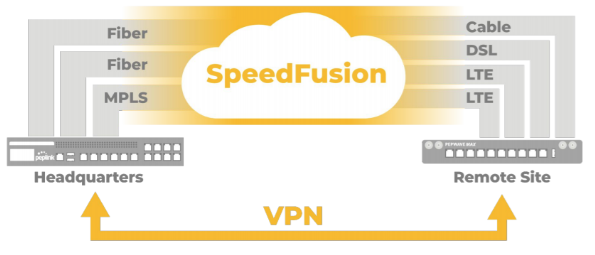
Pepwave bandwidth bonding SpeedFusionTM is our patented technology that enables our SD-WAN routers to bond multiple Internet connections to increase site-to-site bandwidth and reliability. SpeedFusion functionality securely connects your Pepwave router to another Pepwave or Peplink device (Peplink Balance 210/310/380/580/710/1350 only). Data, voice, or video communications between these locations are kept confidential across the public Internet.
Bandwidth bonding SpeedFusionTM is specifically designed for multi-WAN environments. In case of failures and network congestion at one or more WANs, other WANs can be used to continue carrying the network traffic.
Different models of our SD-WAN routers have different numbers of site-to-site connections allowed. End-users who need to have more site-to-site connections can purchase a SpeedFusion license to increase the number of site-to-site connections allowed.
Pepwave routers can aggregate all WAN connections’ bandwidth for routing SpeedFusionTM traffic. Unless all the WAN connections of one site are down, Pepwave routers can keep the VPN up and running.
VPN bandwidth bonding is supported in Firmware 5.1 or above. All available bandwidth will be utilized to establish the VPN tunnel, and all traffic will be load balanced at packet level across all links. VPN bandwidth bonding is enabled by default.
SpeedFusion VPN#
To configure SpeedFusion VPN, navigate to Advanced > SpeedFusion VPN.

The local LAN subnet and subnets behind the LAN (defined under Static Route on the LAN settings page) will be advertised to the VPN. All VPN members (branch offices and headquarters) will be able to route to local subnets.
Note that all LAN subnets and the subnets behind them must be unique. Otherwise, VPN members will not be able to access each other.
All data can be routed over the VPN using the 256-bit AES encryption standard. To configure, navigate to Advanced > SpeedFusion VPN and click the New Profile button to create a new VPN profile (you may have to first save the displayed default profile in order to access the New Profile button). Each profile specifies the settings for making VPN connection with one remote Pepwave or Peplink device. Note that available settings vary by model.
A list of defined SpeedFusion connection profiles and a Link Failure Detection Time option will be shown. Click the New Profile button to create a new VPN connection profile for making a VPN connection to a remote Peplink device via the available WAN connections. Each profile is for making a VPN connection with one remote Peplink Device.

| SpeedFusion VPN Profile | |
| Name | This field is for specifying a name to represent this profile. The name can be any combination of alphanumeric characters (0-9, A-Z, a-z), underscores (_), dashes (-), and/or non-leading/trailing spaces ( ).
Click the |
| Enable | When this box is checked, this VPN connection profile will be enabled. Otherwise, it will be disabled. |
| Encryption | By default, VPN traffic is encrypted with 256-bit AES. If Off is selected on both sides of a VPN connection, no encryption will be applied. |
| Authentication | Select from By Remote ID Only, Preshared Key, or X.509 to specify the method the Peplink device will use to authenticate peers. When selecting By Remote ID Only, be sure to enter a unique peer ID number in the Remote ID field. |
| Remote ID /
Pre-shared Key |
This optional field becomes available when Remote ID / Pre-shared Key is selected as the Peplink device’s VPN Authentication method, as explained above. Pre-shared Key defines the pre-shared key used for this particular VPN connection. The VPN connection’s session key will be further protected by the pre-shared key. The connection will be up only if the pre-shared keys on each side match. When the peer is running firmware 5.0+, this setting will be ignored.
Enter Remote IDs either by typing out each Remote ID and Pre-shared Key, or by pasting a CSV. If you wish to paste a CSV, click the |
| Remote ID/Remote Certificate | These optional fields become available when X.509 is selected as the Peplink device’s VPN authentication method, as explained above. To authenticate VPN connections using X.509 certificates, copy and paste certificate details into these fields. To get more information on a listed X.509 certificate, click the Show Details link below the field. |
| Allow Shared Remote ID | When this option is enabled, the router will allow multiple peers to run using the same remote ID. |
| NAT Mode | Check this box to allow the local DHCP server to assign an IP address to the remote peer. When NAT Mode is enabled, all remote traffic over the VPN will be tagged with the assigned IP address using network address translation. |
| Remote IP Address / Host Names (Optional) | If NAT Mode is not enabled, you can enter a remote peer’s WAN IP address or hostname(s) here. If the remote uses more than one address, enter only one of them here. Multiple hostnames are allowed and can be separated by a space character or carriage return. Dynamic-DNS host names are also accepted.
This field is optional. With this field filled, the Peplink device will initiate connection to each of the remote IP addresses until it succeeds in making a connection. If the field is empty, the Peplink device will wait for connection from the remote peer. Therefore, at least one of the two VPN peers must specify this value. Otherwise, VPN connections cannot be established. Click the |
| Cost | Define path cost for this profile.
OSPF will determine the best route through the network using the assigned cost. Default: 10 |
| Data Port | This field is used to specify a UDP port number for transporting outgoing VPN data. If Default is selected, UDP port 4500 will be used. Port 32015 will be used if the remote unit uses Firmware prior to version 5.4 or if port 4500 is unavailable. If Custom is selected, enter an outgoing port number from 1 to 65535.
Click the |
| Bandwidth Limit | Define maximum download and upload speed to each individual peer. This functionality requires the peer to use PepVPN version 4.0.0 or above. |
| TCP Ramp Up | For every new TCP connection, Normal WAN Smoothing will be applied for a short period of time to prevent packet loss during TCP Slow Start, which in some conditions will ramp up TCP throughput faster. |
| WAN Smoothing | While using PepVPN, utilize multiple WAN links to reduce the impact of packet loss and get the lowest possible latency at the expense of extra bandwidth consumption. This is suitable for streaming applications where the average bitrate requirement is much lower than the WAN’s available bandwidth.
Off – Disable WAN Smoothing. Normal – The total bandwidth consumption will be at most 2x of the original data traffic. Medium – The total bandwidth consumption will be at most 3x of the original data traffic. High – The total bandwidth consumption depends on the number of connected active tunnels. |
| Forward Error Correction | Forward Error Correction (FEC) can help to recover packet loss by using extra bandwidth to send redundant data packets. Higher FEC level will recover packets on a higher loss rate link.
For more information on FEC and Adaptive FEC, refer to this KB article. Require peer using PepVPN version 8.0.0 and above. |
| Receive Buffer | Receive Buffer can help to reduce out-of-order packets and jitter, but will introduce extra latency to the tunnel. Default is 0 ms, which disables the buffer, and maximum buffer size is 2000 ms. |
| Packet Fragmentation | If the packet size is larger than the tunnel’s MTU, it will be fragmented inside the tunnel in order to pass through.
Select Always to fragment any packets that are too large to send, or Use DF Flag to only fragment packets with Don’t Fragment bit cleared. This can be useful if your application does Path MTU Discovery, usually sending large packets with DF bit set, if allowing them to go through by fragmentation, the MTU will not be detected correctly. |
| Use IP ToS^ | If Use IP ToS is enabled, the ToS value of the data packets will be copied to the PepVPN header during encapsulation. |
| Latency Difference Cutoff^ | Traffic will be stopped for links that exceed the specified millisecond value with respect to the lowest latency link. (e.g. Lowest latency is 100ms, a value of 500ms means links with latency 600ms or more will not be used) |
^ Advanced feature, please click the ![]() button on the top right-hand corner to activate.
button on the top right-hand corner to activate.
To enable Layer 2 Bridging between SpeedFusion VPN profiles, navigate to Network > LAN > Basic Settings > *LAN Profile Name* and refer to instructions in section 8.1


| Traffic Distribution | |
| Policy | This option allows you to select the desired out-bound traffic distribution policy:
By default, Bonding is selected as a traffic distribution policy. |
| Congestion Latency Level | For most WANs, especially on cellular networks, the latency will increase when the link becomes more congested.
Setting the Congestion Latency Level to Low will treat the link as congested more aggressively. Setting it to High will allow the latency to increase more before treating it as congested. |
| Ignore Packet Loss Event | By default, when there is packet loss, it is considered as a congestion event. If this is not the case, select this option to ignore the packet loss event. |
| Disable Bufferbloat Handling | Bufferbloat is a phenomenon on the WAN side when it is congested. The latency can become very high due to buffering on the uplink. By default, the Dynamic Weighted Bonding policy will try its best to mitigate bufferbloat by reducing TCP throughput when the WAN is congested. However, as a side effect, the tunnel might not achieve maximum bandwidth.
Selecting this option will disable the bufferbloat handling mentioned above. |
| Disable TCP ACK Optimization | By default, TCP ACK will be forwarded to remote peers as fast as possible. This will consume more bandwidth, but may help to improve TCP performance as well.
Selecting this option will disable the TCP ACK optimization mentioned above. |
| Packet Jitter Buffer | The default jitter buffer is 150ms, and can be modified from 0ms to 500ms. The jitter buffer may increase the tunnel latency. If you want to keep the latency as low as possible, you can set it to 0ms to disable the buffer.
Note: If the Receive Buffer is set, the Packet Jitter Buffer will be automatically disabled. |
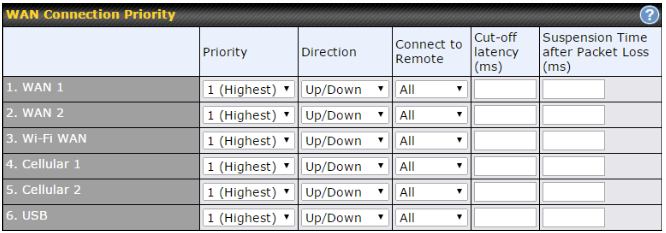
| WAN Connection Priority | |
| WAN Connection Priority | If your device supports it, you can specify the priority of WAN connections to be used for making VPN connections. WAN connections set to OFF will never be used. Only available WAN connections with the highest priority will be used.
To enable asymmetric connections, connection mapping to remote WANs, cut-off latency, and packet loss suspension time, click the |

| Send All Traffic To |
| This feature allows you to redirect all traffic to a specified SpeedFusion VPN connection. Click the
|
| Outbound Policy/SpeedFusion VPN Outbound Custom Rules |
| Some models allow you to set outbound policy and custom outbound rules from Advanced>SpeedFusion VPN. See Section 14 for more information on outbound policy settings.
|

| SpeedFusion VPN Local ID |
| The local ID is a text string to identify this local unit when establishing a VPN connection. When creating a profile on a remote unit, this local ID must be entered in the remote unit’s Remote ID field. Click the |

| Link Failure Detection Settings | |
| Cold Failover Mode | Enabling Cold Failover Mode turns off link failure detection for standby WAN-to-WAN links, helping to lower bandwidth consumption. |
| Link Failure Detection Time | The bonded VPN can detect routing failures on the path between two sites over each WAN connection. Failed WAN connections will not be used to route VPN traffic. Health check packets are sent to the remote unit to detect any failure. The more frequently checks are sent, the shorter the detection time, although more bandwidth will be consumed.
When Recommended (default) is selected, a health check packet is sent every five seconds, and the expected detection time is 15 seconds. When Fast is selected, a health check packet is sent every three seconds, and the expected detection time is six seconds. When Faster is selected, a health check packet is sent every second, and the expected detection time is two seconds. When Extreme is selected, a health check packet is sent every 0.1 second, and the expected detection time is less than one second. |
^ Advanced feature, please click the ![]() button on the top right-hand corner to activate.
button on the top right-hand corner to activate.
| Important Note |
| Peplink proprietary SpeedFusionTM uses TCP port 32015 and UDP port 4500 for establishing VPN connections. If you have a firewall in front of your Pepwave devices, you will need to add firewall rules for these ports and protocols to allow inbound and outbound traffic to pass through the firewall. |
| Tip |
| Want to know more about VPN sub-second session failover? Visit our YouTube Channel for a video tutorial!
|
The Pepwave Router Behind a NAT Router#
Pepwave routers support establishing SpeedFusionTM over WAN connections which are behind a NAT (network address translation) router.
To enable a WAN connection behind a NAT router to accept VPN connections, you can configure the NAT router in front of the WAN connection to inbound port-forward TCP port 32015 to the Pepwave router.
If one or more WAN connections on Unit A can accept VPN connections (by means of port forwarding or not), while none of the WAN connections on the peer Unit B can do so, you should enter all of Unit A’s public IP addresses or hostnames into Unit B’s Remote IP Addresses / Host Names field. Leave the field in Unit A blank. With this setting, a SpeedFusionTM connection can be set up and all WAN connections on both sides will be utilized.
See the following diagram for an example of this setup in use:
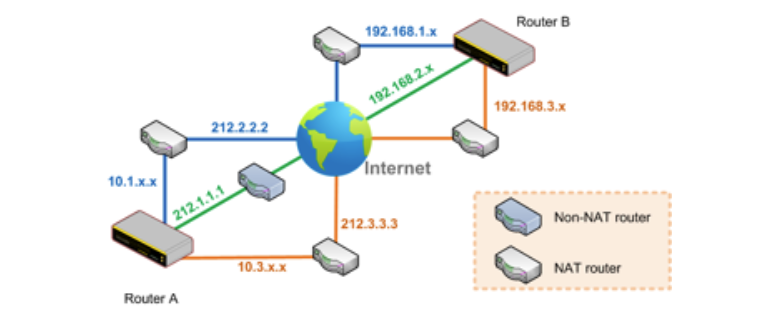
One of the WANs connected to Router A is non-NAT’d (212.1.1.1). The rest of the WANs connected to Router A and all WANs connected to Router B are NAT’d. In this case, the Peer IP Addresses / Host Names field for Router B should be filled with all of Router A’s hostnames or public IP addresses (i.e., 212.1.1.1, 212.2.2.2, and 212.3.3.3), and the field in Router A can be left blank. The two NAT routers on WAN1 and WAN3 connected to Router A should inbound port-forward TCP port 32015 to Router A so that all WANs will be utilized in establishing the VPN.
SpeedFusion VPN Status#
SpeedFusion VPN status is shown in the Dashboard. The connection status of each connection profile is shown as below.

After clicking the Status button at the top right corner of the SpeedFusionTM table, you will be forwarded to Status > SpeedFusion VPN, where you can view subnet and WAN connection information for each VPN peer.
| IP Subnets Must Be Unique Among VPN Peers |
| The entire interconnected SpeedFusionTM network is a single non-NAT IP network. Avoid duplicating subnets in your sites to prevent connectivity problems when accessing those subnets. |
Ch10. IPsec VPN#
IPsec VPN functionality securely connects one or more branch offices to your company’s main headquarters or to other branches. Data, voice, and video communications between these locations are kept safe and confidential across the public Internet.
IPsec VPN on Pepwave routers is specially designed for multi-WAN environments. For instance, if a user sets up multiple IPsec profiles for a multi-WAN environment and WAN1 is connected and healthy, IPsec traffic will go through this link. However, should unforeseen problems (e.g., unplugged cables or ISP problems) cause WAN1 to go down, our IPsec implementation will make use of WAN2 and WAN3 for failover.
IPsec VPN Settings#
Many Pepwave products can make multiple IPsec VPN connections with Peplink, Pepwave, Cisco, and Juniper routers. Note that all LAN subnets and the subnets behind them must be unique. Otherwise, VPN members will not be able to access each other. All data can be routed over the VPN with a selection of encryption standards, such as 3DES, AES-128, and AES-256. To configure IPsec VPN on Pepwave devices that support it, navigate to Advanced>IPsec VPN.

Click the New Profile button to create new IPsec VPN profiles that make VPN connections to remote Pepwave, Cisco, or Juniper routers via available WAN connections. To edit any of the profiles, click on its associated connection name in the leftmost column.
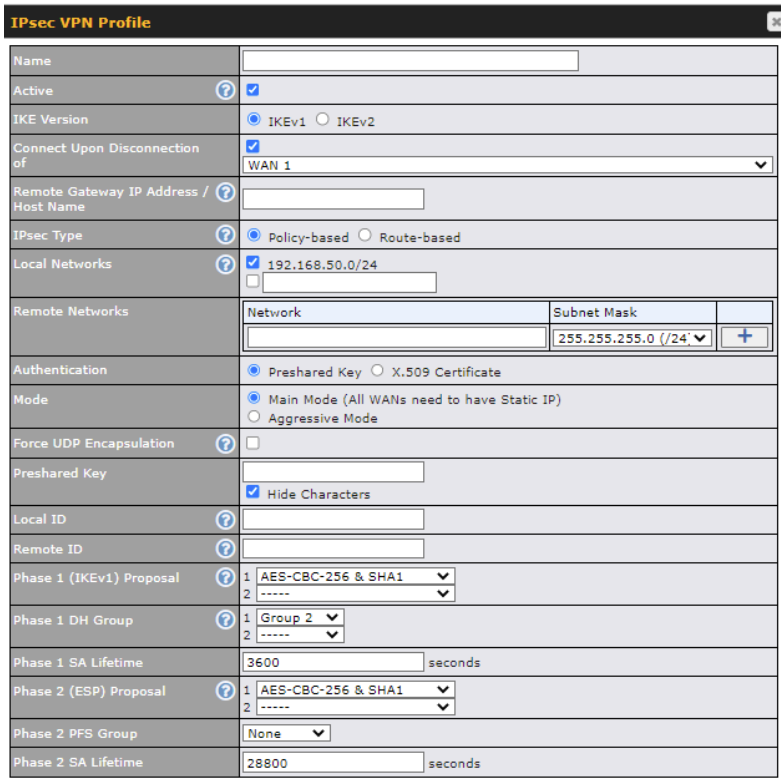
| IPsec VPN Profile Settings | |
| Name | This field is for specifying a local name to represent this connection profile. |
| Active | When this box is checked, this IPsec VPN connection profile will be enabled. Otherwise, it will be disabled. |
| IKE Version | Two versions of the IKE standards are available:
|
| Connect Upon Disconnection of | Check this box and select a WAN to connect to this VPN automatically when the specified WAN is disconnected. |
| Remote Gateway IP Address / Host Name | Enter the remote peer’s public IP address. For Aggressive Mode, this is optional. |
| IPsec Type | Policy-based – (default) All the matched traffic as defined in Local Networks and Remote Networks will be routed to this IPsec connection, this cannot be overridden by other routing methods.
Route-based – Outbound Policy rule is required to route traffic to this tunnel and comes with more flexibility to control how to route traffic compared to Policy-based. If you want to modify the traffic selector instead of using the default (0.0.0.0/0). Note: This option is available for certain following models only:
|
| Local Networks | Enter the local LAN subnets here. If you have defined static routes, they will be shown here.
Using NAT, you can map a specific local network / IP address to another, and the packets received by remote gateway will appear to be coming from the mapped network / IP address. This allow you to establish IPsec connection to a remote site that has one or more subnets overlapped with local site. Two types of NAT policies can be defined: One-to-One NAT policy: if the defined subnet in Local Network and NAT Network has the same size, for example, policy “192.168.50.0/24 > 172.16.1.0/24” will translate the local IP address 192.168.50.10 to 172.16.1.10 and 192.168.50.20 to 172.16.1.20. This is a bidirectional mapping which means clients in remote site can initiate connection to the local clients using the mapped address too. Many-to-One NAT policy: if the defined NAT Network on the right hand side is an IP address (or having a network prefix /32), for example, policy “192.168.1.0/24 > 172.168.50.1/32” will translate all clients in 192.168.1.0/24 network to 172.168.50.1. This is a unidirectional mapping which means clients in remote site will not be able to initiate connection to the local clients. |
| Remote Networks | Enter the LAN and subnets that are located at the remote site here. |
| Authentication | To access your VPN, clients will need to authenticate by your choice of methods. Choose between the Preshared Key and X.509 Certificate methods of authentication. |
| Mode | Choose Main Mode if both IPsec peers use static IP addresses. Choose Aggressive Mode if one of the IPsec peers uses dynamic IP addresses. |
| Force UDP Encapsulation | For forced UDP encapsulation regardless of NAT-traversal, tick this checkbox. |
| Pre-shared Key | This defines the peer authentication pre-shared key used to authenticate this VPN connection. The connection will be up only if the pre-shared keys on each side match. |
| Remote Certificate (pem encoded) | Available only when X.509 Certificate is chosen as the Authentication method, this field allows you to paste a valid X.509 certificate. |
| Local ID | In Main Mode, this field can be left blank. In Aggressive Mode, if Remote Gateway IP Address is filled on this end and the peer end, this field can be left blank. Otherwise, this field is typically a U-FQDN. |
| Remote ID | In Main Mode, this field can be left blank. In Aggressive Mode, if Remote Gateway IP Address is filled on this end and the peer end, this field can be left blank. Otherwise, this field is typically a U-FQDN. |
| Phase 1 (IKE) Proposal | In Main Mode, this allows setting up to six encryption standards, in descending order of priority, to be used in initial connection key negotiations. In Aggressive Mode, only one selection is permitted. |
| Phase 1 DH Group | This is the Diffie-Hellman group used within IKE. This allows two parties to establish a shared secret over an insecure communications channel. The larger the group number, the higher the security.
Group 2: 1024-bit is the default value. Group 5: 1536-bit is the alternative option. |
| Phase 1 SA Lifetime | This setting specifies the lifetime limit of this Phase 1 Security Association. By default, it is set at 3600 seconds. |
| Phase 2 (ESP) Proposal | In Main Mode, this allows setting up to six encryption standards, in descending order of priority, to be used for the IP data that is being transferred. In Aggressive Mode, only one selection is permitted. |
| Phase 2 PFS Group | Perfect forward secrecy (PFS) ensures that if a key was compromised, the attacker will be able to access only the data protected by that key.
None – Do not request for PFS when initiating connection. However, since there is no valid reason to refuse PFS, the system will allow the connection to use PFS if requested by the remote peer. This is the default value. Group 2: 1024-bit Diffie-Hellman group. The larger the group number, the higher the security. Group 5: 1536-bit is the third option. |
| Phase 2 SA Lifetime | This setting specifies the lifetime limit of this Phase 2 Security Association. By default, it is set at 28800 seconds. |

| WAN Connection Priority | |
| WAN Connection | Select the appropriate WAN connection from the drop-down menu. |
Ch11. GRE Tunnel#
Generic Routing Encapsulation (GRE) is a tunneling protocol that can encapsulate a wide variety of network layer protocols inside virtual point-to-point links over an Internet Protocol network. A GRE tunnel is similar to IPSec or SpeedFusion VPN.
To configure a GRE Tunnel, navigate to Advanced > GRE Tunnel.

Click the New Profile button to create new GRE tunnel profiles that establish tunnel connections to remote tunnel endpoints via available WAN connections. To edit the profiles, click on its associated connection name in the leftmost column.
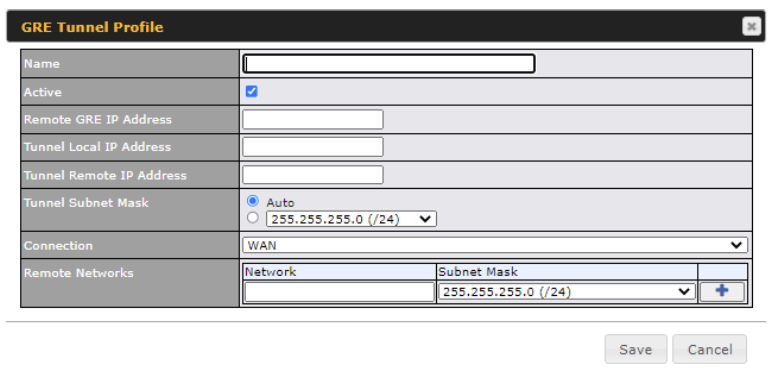
| GRE Tunnel Profile Settings | |
| Name | This field is for specifying a name to represent this GRE Tunnel connection profile. |
| Active | When this box is checked, this GRE Tunnel connection profile will be enabled. Otherwise, it will be disabled. |
| Remote GRE IP Address | This field is for entering the remote GRE’s IP address |
| Tunnel Local IP Address | This field is for specifying the tunnel source IP address. |
| Tunnel Remote IP Address | This field is for specifying the tunnel destination IP address |
| Tunnel Subnet Mask | This field is to select the subnet mask that is to be used for the GRE tunnel. |
| Connection | Select the appropriate WAN connection from the drop-down menu. |
| Remote Networks | Input the LAN and subnets that are located at the remote site here. |
Ch12. OpenVPN#
OpenVPN is a site to site VPN mode that can encapsulate a wide variety of network layer protocols inside virtual point-to-point links over an Internet Protocol network.
To configure a OpenVPN, navigate to Advanced > OpenVPN and click the New Profile.
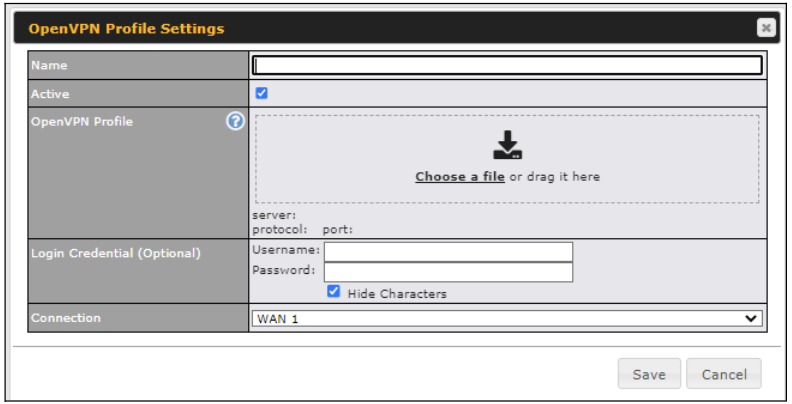
| OpenVPN Profile Settings | |
| Name | This field is for specifying a name to represent this OpenVPN profile. |
| Active | When this box is checked, this OpenVPN connection profile will be enabled. Otherwise, it will be disabled. |
| OpenVPN Profile | Upload the OpenVPN configuration (.ovpn) file from your service provider. |
| Login Credential (Optional) | This option is an optional for you to enter the username and password to login for the OpenVPN connection if the profile need to login. |
| Connection | Select the appropriate WAN connection from the drop-down menu. |
Ch13. Outbound Policy#
Pepwave routers can flexibly manage and load balance outbound traffic among WAN connections.

The settings for managing and load balancing outbound traffic are located at
Advanced > Outbound Policy.

Adding Rules for Outbound Policy#
The menu underneath enables you to define Outbound policy rules:

The bottom-most rule is Default. Edit this rule to change the device’s default manner of controlling outbound traffic for all connections that do not match any of the rules above it. Under the Service heading, click Default to change these settings.
To rearrange the priority of outbound rules, drag and drop them into the desired sequence.
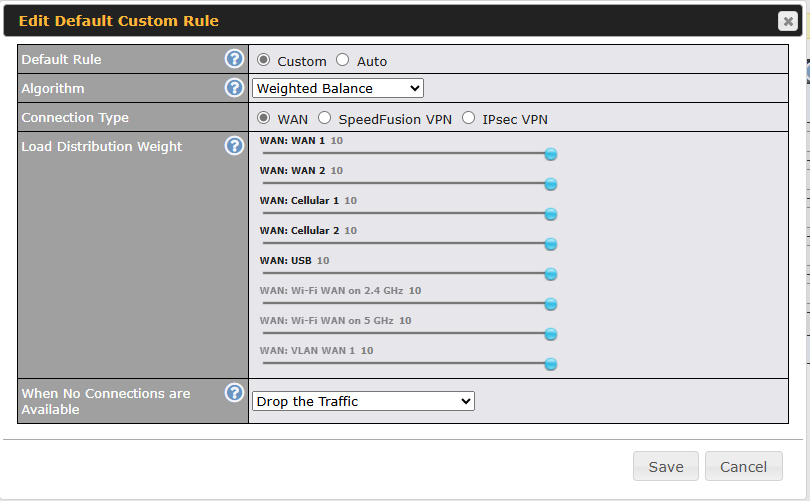
By default, Auto is selected as the Default Rule. You can select Custom to change the algorithm to be used. Please refer to the upcoming sections for the details on the available algorithms.
(Connection Type option available only when Weighted Balance is chosen and Speed Fusion or Route-based IPsec has been configured.)
To create a custom rule, click Add Rule at the bottom of the table.
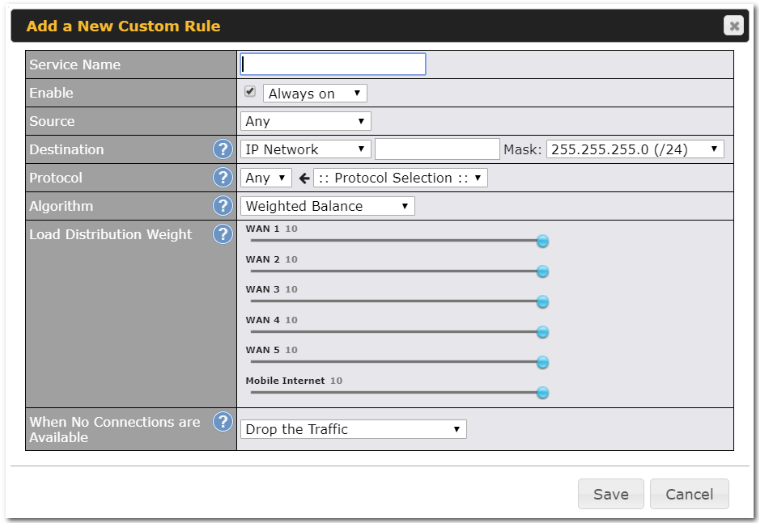
| New Custom Rule Settings | |
| Service Name | This setting specifies the name of the outbound traffic rule. |
| Enable | This setting specifies whether the outbound traffic rule takes effect. When Enable is checked, the rule takes effect: traffic is matched and actions are taken by the Pepwave router based on the other parameters of the rule. When Enable is unchecked, the rule does not take effect: the Pepwave router disregards the other parameters of the rule.
Click the drop-down menu next to the checkbox to apply a time schedule to this custom rule. |
| Source | This specifies the source IP address(es) and port number(s) to be matched for the firewall rule. Any, IP Address, IP Network, MAC Address, Client Type (for Outbound and Internal Firewall only), and Client’s Associated SSID can be specified as the Source setting, as indicated in the following screenshots:
When you select Client Type as the Source, a drop-down list will appear for you to choose the different types of client devices.
In addition, a single port, or a range of ports, can be specified for the Source settings. |
| Destination | This specifies the destination IP address(es) and port number(s) to be matched for the firewall rule. Any, IP Address, IP Network, Domain Name, SpeedFusion Connect, and SpeedFusion VPN Profile can be specified as the Destination setting, as indicated in the following screenshots:
In addition, a single port or a range of ports can be specified for the settings. |
| Protocol and Port | This setting specifies the IP protocol and port of traffic that matches this rule. Via a drop-down menu, the following protocols can be specified:
Alternatively, the Protocol Selection Tool drop-down menu can be used to automatically fill in the protocol and port number of common Internet services (e.g., HTTP, HTTPS, etc.) After selecting an item from the Protocol Selection Tool drop-down menu, the protocol and port number remain manually modifiable. |
| Algorithm | This setting specifies the behavior of the Pepwave router for the custom rule.
One of the following values can be selected (Note that some Pepwave routers provide only some of these options):
For a full explanation of each Algorithm, please see the following article: https://forum.peplink.com/t/exactly-how-do-peplinks-load-balancing-algorithmns-work/8059 |
| Connection Type | This is to define which connection to forward the traffic.
|
| Load Distribution Weight | This is to define the outbound traffic weight ratio for each WAN connection. |
| When No connections are available | This field allows you to configure the default action when all the selected Connections are not available.
Drop the Traffic – Traffic will be discarded. Use Any Available Connections – Traffic will be routed to any available Connection, even if it is not selected in the list. Fall-through to Next Rule – Traffic will continue to match the next Outbound Policy rule just like this rule is inactive. |
| Terminate Sessions on Connection Recovery | This setting specifies whether to terminate existing IP sessions on a less preferred WAN connection in the event that a more preferred WAN connection is recovered. This setting is applicable to the Priority algorithms. By default, this setting is disabled. In this case, existing IP sessions will not be terminated or affected when any other WAN connection is recovered. When this setting is enabled, existing IP sessions may be terminated when another WAN connection is recovered, such that only the preferred healthy WAN connection(s) is used at any point in time. |

Algorithm: Weighted Balance#
This setting specifies the ratio of WAN connection usage to be applied on the specified IP protocol and port. This setting is applicable only when Algorithm is set to Weighted Balance.

The amount of matching traffic that is distributed to a WAN connection is proportional to the weight of the WAN connection relative to the total weight. Use the sliders to change each WAN’s weight.
For example, with the following weight settings:
- Ethernet WAN1: 10
- Ethernet WAN2: 10
- Wi-Fi WAN: 10
- Cellular 1: 10
- Cellular 2: 10
- USB: 10
Total weight is 60 = (10 +10 + 10 + 10 + 10 + 10).
Matching traffic distributed to Ethernet WAN1 is 16.7% = (10 / 60 x 100%.
Matching traffic distributed to Ethernet WAN2 is 16.7% = (10 / 60) x 100%.
Matching traffic distributed to Wi-Fi WAN is 16.7% = (10 / 60) x 100%.
Matching traffic distributed to Cellular 1 is 16.7% = (10 / 60) x 100%.
Matching traffic distributed to Cellular 2 is 16.7% = (10 / 60) x 100%.
Matching traffic distributed to USB is 16.7% = (10 / 60) x 100%.
Algorithm: Persistence#
The configuration of persistent services is the solution to the few situations where link load distribution for Internet services is undesirable. For example, for security reasons, many e-banking and other secure websites terminate the session when the client computer’s Internet IP address changes mid-session.
In general, different Internet IP addresses represent different computers. The security concern is that an IP address change during a session may be the result of an unauthorized intrusion attempt. Therefore, to prevent damages from the potential intrusion, the session is terminated upon the detection of an IP address change.
Pepwave routers can be configured to distribute data traffic across multiple WAN connections. Also, the Internet IP depends on the WAN connections over which communication actually takes place. As a result, a LAN client computer behind the Pepwave router may communicate using multiple Internet IP addresses. For example, a LAN client computer behind a Pepwave router with three WAN connections may communicate on the Internet using three different IP addresses.
With the persistence feature, rules can be configured to enable client computers to persistently utilize the same WAN connections for e-banking and other secure websites. As a result, a client computer will communicate using one IP address, eliminating the issues mentioned above.
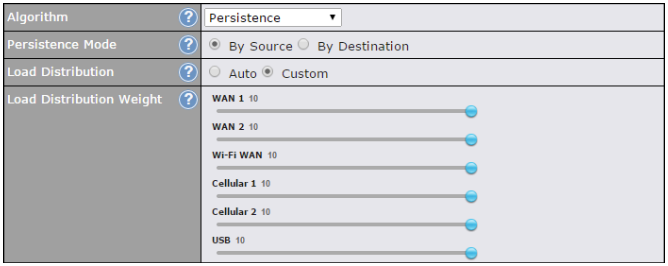
There are two persistent modes: By Source and By Destination.
| By Source: | The same WAN connection will be used for traffic matching the rule and originating from the same machine, regardless of its destination. This option will provide the highest level of application compatibility. |
| By Destination: | The same WAN connection will be used for traffic matching the rule, originating from the same machine, and going to the same destination. This option can better distribute loads to WAN connections when there are only a few client machines. |
The default mode is By Source. When there are multiple client requests, they can be distributed (persistently) to WAN connections with a weight. If you choose Auto in Load Distribution, the weights will be automatically adjusted according to each WAN’s Downstream Bandwidth which is specified in the WAN settings page). If you choose Custom, you can customize the weight of each WAN manually by using the sliders.
Algorithm: Enforced#
This setting specifies the WAN connection usage to be applied on the specified IP protocol and port. This setting is applicable only when Algorithm is set to Enforced.

Matching traffic will be routed through the specified WAN connection, regardless of the health check status of the WAN connection. Starting from Firmware 5.2, outbound traffic can be enforced to go through a specified SpeedFusionTM connection.
Algorithm: Priority#
This setting specifies the priority of the WAN connections used to route the specified network service. The highest priority WAN connection available will always be used for routing the specified type of traffic. A lower priority WAN connection will be used only when all higher priority connections have become unavailable.
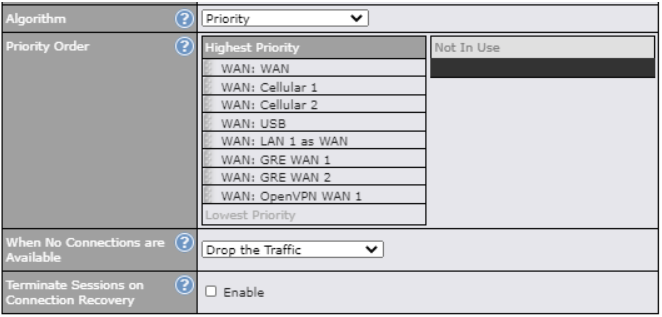
Starting from Firmware 5.2, outbound traffic can be prioritized to go through SpeedFusionTM connection(s). By default, VPN connections are not included in the priority list.
| Tip |
| Configure multiple distribution rules to accommodate different kinds of services. |
Algorithm: Overflow#
The traffic matching this rule will be routed through the healthy WAN connection that has the highest priority and is not in full load. When this connection gets saturated, new sessions will be routed to the next healthy WAN connection that is not in full load.

Drag and drop to specify the order of WAN connections to be used for routing traffic. Only the highest priority healthy connection that is not in full load will be used.
Algorithm: Least Used#

The traffic matching this rule will be routed through the healthy WAN connection that is selected in Connection and has the most available download bandwidth. The available download bandwidth of a WAN connection is calculated from the total download bandwidth specified on the WAN settings page and the current download usage. The available bandwidth and WAN selection is determined every time an IP session is made.
Algorithm: Lowest Latency#

The traffic matching this rule will be routed through the healthy WAN connection that is selected in Connection and has the lowest latency. Latency checking packets are issued periodically to a nearby router of each WAN connection to determine its latency value. The latency of a WAN is the packet round trip time of the WAN connection. Additional network usage may be incurred as a result.
| Tip |
The roundtrip time of a 6M down/640k uplink can be higher than that of a 2M down/2M up link because the overall round trip time is lengthened by its slower upload bandwidth, despite its higher downlink speed. Therefore, this algorithm is good for two scenarios:
|
Expert Mode#
Expert Mode is available on some Pepwave routers for use by advanced users. To enable the feature, click on the help icon and click turn on Expert Mode.
In Expert Mode, a new special rule, SpeedFusionTM Routes, is displayed in the Custom Rules table. This rule represents all SpeedFusionTM routes learned from remote VPN peers. By default, this bar is on the top of all custom rules. This position means that traffic for remote VPN subnets will be routed to the corresponding VPN peer. You can create custom Priority or Enforced rules and move them
above the bar to override the SpeedFusionTM routes.
Upon disabling Expert Mode, all rules above the bar will be removed.
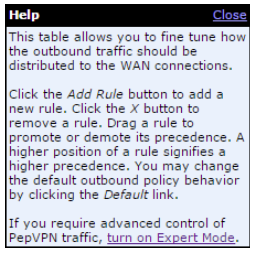
Ch14. Port Forwarding#
Pepwave routers can act as a firewall that blocks, by default, all inbound access from the Internet. By using port forwarding, Internet users can access servers behind the Pepwave router. Inbound port forwarding rules can be defined at Advanced > Port Forwarding.

To define a new service, click Add Service.
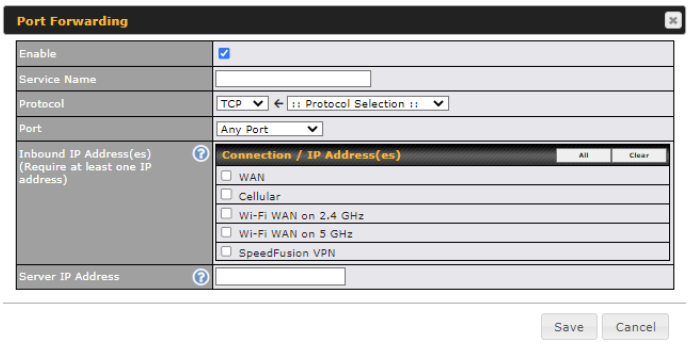
| Port Forwarding Settings | |
| Enable | This setting specifies whether the inbound service takes effect. When Enable is checked, the inbound service takes effect: traffic is matched and actions are taken by the Pepwave router based on the other parameters of the rule. When this setting is disabled, the inbound service does not take effect: the Pepwave router disregards the other parameters of the rule. |
| Service Name | This setting identifies the service to the system administrator. Valid values for this setting consist of only alphanumeric and underscore “_” characters. |
| Protocol | The IP Protocol setting, along with the Port setting, specifies the protocol of the service as TCP, UDP, ICMP, or IP. Traffic that is received by the Pepwave router via the specified protocol at the specified port(s) is forwarded to the LAN hosts specified by the Servers setting. Please see below for details on the Port and Servers settings. Alternatively, the Protocol Selection Tool drop-down menu can be used to automatically fill in the protocol and a single port number of common Internet services (e.g. HTTP, HTTPS, etc.). After selecting an item from the Protocol Selection Tool drop-down menu, the protocol and port number remain manually modifiable. |
| Port | The Port setting specifies the port(s) that correspond to the service, and can be configured to behave in one of the following manners:
Any Port, Single Port, Port Range, Port Map, and Range Mapping
For example, with IP Protocol set to TCP, and Port set to Port Mapping, Service Port 80, and Map to Port 88, TCP traffic on port 80 is forwarded to the configured servers via port 88. (Please see below for details on the Servers setting.)
|
| Inbound IP Address(es) | This setting specifies the WAN connections and Internet IP address(es) from which the service can be accessed. |
| Server IP Address | This setting specifies the LAN IP address of the server that handles the requests for the service. |
UPnP / NAT-PMP Settings#
UPnP and NAT-PMP are network protocols which allow a computer connected to the LAN port to automatically configure the router to allow parties on the WAN port to connect to itself. That way, the process of inbound port forwarding becomes automated.
When a computer creates a rule using these protocols, the specified TCP/UDP port of all WAN connections’ default IP address will be forwarded.
Check the corresponding box(es) to enable UPnP and/or NAT-PMP. Enable these features only if you trust the computers connected to the LAN ports.

When the options are enabled, a table listing all the forwarded ports under these two protocols can be found at Status > UPnP / NAT-PMP.
Ch15. NAT Mappings#
NAT mappings allow IP address mapping of all inbound and outbound NAT’d traffic to and from an internal client IP address. Settings to configure NAT mappings are located at Advanced > NAT Mappings.

To add a rule for NAT mappings, click Add NAT Rule.
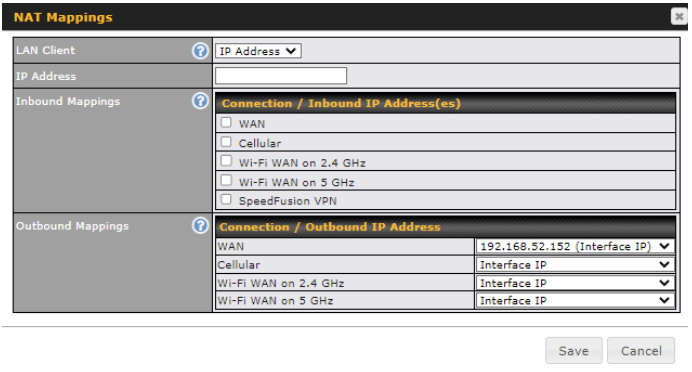
| NAT Mapping Settings | |
| LAN Client | NAT mapping rules can be defined for a single LAN IP Address, an IP Range, or an IP Network. |
| IP Address | This refers to the LAN host’s private IP address. The system maps this address to a number of public IP addresses (specified below) in order to facilitate inbound and outbound traffic. This option is only available when IP Address is selected. |
| IP Range | The IP range is a contiguous group of private IP addresses used by the LAN host. The system maps these addresses to a number of public IP addresses (specified below) to facilitate outbound traffic. This option is only available when IP Range is selected. |
| IP Network | The IP network refers to all private IP addresses and ranges managed by the LAN host. The system maps these addresses to a number of public IP addresses (specified below) to facilitate outbound traffic. This option is only available when IP Network is selected. |
| Inbound Mappings | This setting specifies the WAN connections and corresponding WAN-specific Internet IP addresses on which the system should bind. Any access to the specified WAN connection(s) and IP address(es) will be forwarded to the LAN host. This option is only available when IP Address is selected in the LAN Client(s) field.
Note that: inbound mapping is not needed for WAN connections in drop-in mode or IP forwarding mode. Also note that each WAN IP address can be associated to one NAT mapping only. |
| Outbound Mappings | This setting specifies the WAN IP addresses that should be used when an IP connection is made from a LAN host to the Internet. Each LAN host in an IP range or IP network will be evenly mapped to one of each selected WAN’s IP addresses (for better IP address utilization) in a persistent manner (for better application compatibility).
Note that: if you do not want to use a specific WAN for outgoing accesses, you should still choose default here, then customize the outbound access rule in the Outbound Policy section. Also note that WAN connections in drop-in mode or IP forwarding mode are not shown here. |
Click Save to save the settings when configuration has been completed.
| Important Note |
| Inbound firewall rules override the Inbound Mappings settings. |
Ch16. Docker#
* License acquire for this feature on B One series.
For non-MFA/Edge Computing devices, you can plug in a USB as storage for installing or running Docker Containers on your device. After plugging in the device, under “System → Tools → External Storage” you will be able to see the USB details you plug in.

You might need to format your USB to the supported format to be able to use by the device. To format your USB, click “Format” button and type in the encryption key as following. The encryption key is used everytime for the USB to mount in the device.

After a while, the status will change to “In use” as below.

Ch17. QoS#
User Groups#
Other than the three default user groups, you can add more user groups by entering the group name into the column and clicking the ‘+‘ button. The user group limit is up to 10.
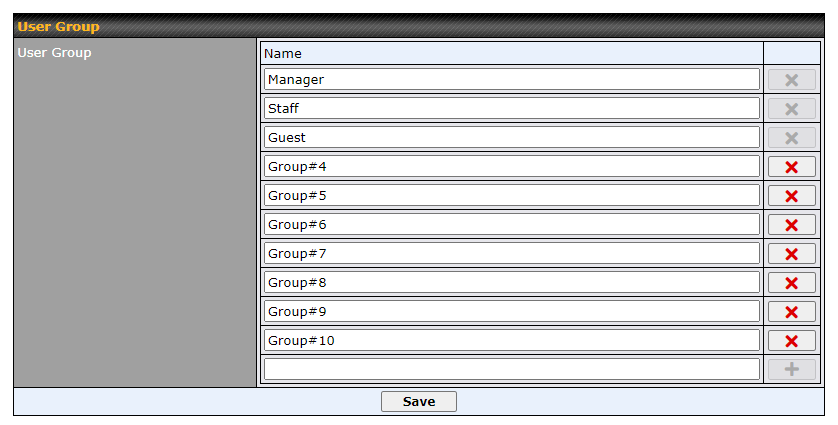
Bandwidth Control#
This section is to define how much minimum bandwidth will be reserved to each user group when a WAN connection is in full load. When this feature is enabled, a slider with two indicators will be shown. You can move the indicators to adjust each group’s weighting. The lower part of the table shows the corresponding reserved download and uploads bandwidth value of each connection.
By default, 50% of bandwidth has been reserved for Manager, 30% for Staff, and 20% for Guest.

You can define a maximum download speed (over all WAN connections) and upload speed (for each WAN connection) that each individual Staff and Guest member can consume. No limit can be imposed on individual Managers. By default, download and upload bandwidth limits are set to unlimited (set as 0).

Application Queue#
This section is to define the QoS Application Queue. You can set guaranteed bandwidth for a queue and assign it to applications.

Click the Add button to create the QoS Application Queue.

| Add Queue | |
| Name | This setting specifies a name for the QoS Application Queue. |
| Bandwidth | Bandwidth to be reserved (for each WAN connection) for this queue. When WAN is congested, this bandwidth will remain available for applications assigned to this queue. |
| Borrow Spare Bandwidth | Enable this option if you want this queue to utilize WAN’s unused bandwidth. |
Application#
Application Prioritization#
On many Pepwave routers, you can choose whether to apply the same prioritization settings to all user groups or customize the settings for each group.

Three application priority levels can be set: ↑High,━ Normal, and↓Low. Pepwave routers can detect various application traffic types by inspecting the packet content. Select an application by choosing a supported application, or by defining a custom application manually. The priority preference of supported applications is placed at the top of the table. Custom applications are at the bottom.

Prioritization for Custom Applications#
Click the Add button to define a custom application. Click the button ![]() in the Action column to delete the custom application in the corresponding row.
in the Action column to delete the custom application in the corresponding row.
When Supported Applications is selected, the Pepwave router will inspect network traffic and prioritize the selected applications. Alternatively, you can select Custom Applications and define the application by providing the protocol, scope, port number, and DSCP value.

DSL/Cable Optimization#
DSL/cable-based WAN connections have lower upload bandwidth and higher download bandwidth. When a DSL/cable circuit’s uplink is congested, the download bandwidth will be affected. Users will not be able to download data at full speed until the uplink becomes less congested. DSL/Cable Optimization can relieve such an issue. When it is enabled, the download speed will become less affected by the upload traffic. By default, this feature is disabled.

SpeedFusion VPN Traffic Optimization#
To enable this option to allow SpeedFusion VPN traffic has highest priority when WAN is congested.

Ch18. Firewall#
A firewall is a mechanism that selectively filters data traffic between the WAN side (the Internet) and the LAN side of the network. It can protect the local network from potential hacker attacks, access to offensive websites, and/or other inappropriate uses.
The firewall functionality of Pepwave routers supports the selective filtering of data traffic in both directions:
- Outbound (LAN to WAN)
- Inbound (WAN to LAN)
- Internal Network (VLAN to VLAN)
- Local Service
The firewall also supports the following functionality:
- Intrusion detection and DoS prevention
- Web blocking
With SpeedFusionTM enabled, the firewall rules also apply to VPN tunneled traffic.
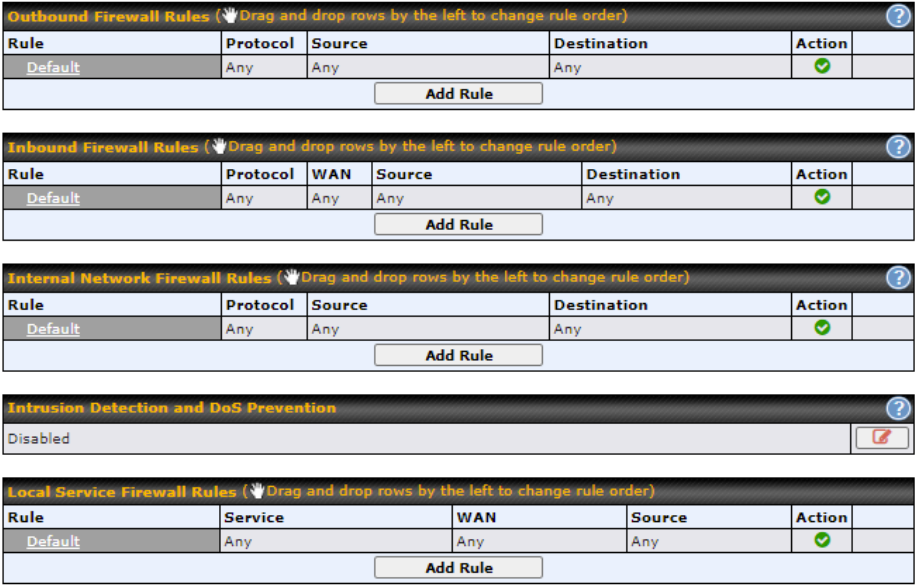
Access Rules#
Outbound Firewall Rules
The outbound firewall settings are located at Advanced > Firewall > Access Rules.

To enable or disable the Outbound Firewall to manage device local network traffic, click on the help icon ![]() and click here, the screen will show below.
and click here, the screen will show below.

| Note |
| To utilize the Outbound Firewall Rule to block the Peplink device from contacting InControl 2. may refer to the link below:
https://forum.peplink.com/t/faq-prevent-device-reaching-incontrol-2./63f48fdfd466df34ab475f55/ |
Click Add Rule to display the following screen:
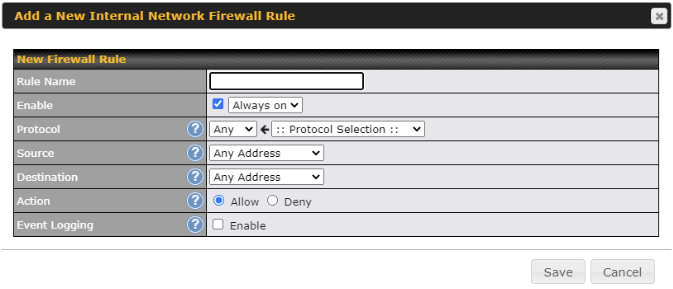
Inbound Firewall Rules
Inbound firewall settings are located at Advanced > Firewall > Access Rules.

Click Add Rule to display the following screen:
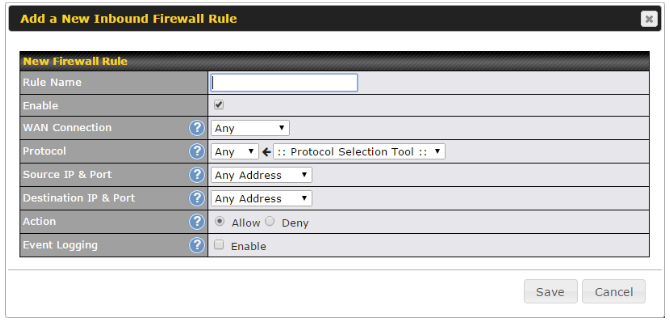
Internal Network Firewall Rules
Internal Network firewall settings are located at Advanced > Firewall > Access Rules.

Click Add Rule to display the following window:
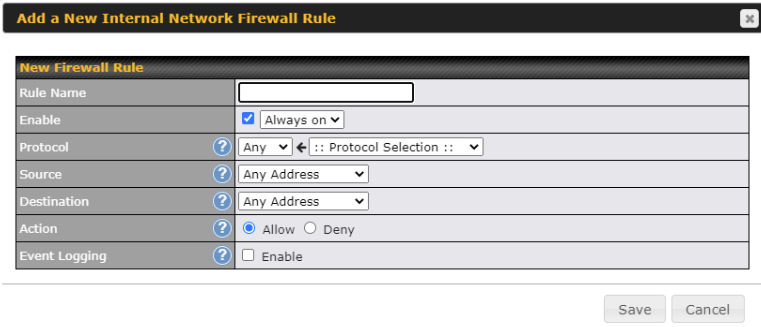
| Inbound / Outbound / Internal Network Firewall Settings | |
| Rule Name | This setting specifies a name for the firewall rule. |
| Enable | This setting specifies whether the firewall rule should take effect. If the box is checked, the firewall rule takes effect. If the traffic matches the specified protocol/IP/port, actions will be taken by the Pepwave router based on the other parameters of the rule. If the box is not checked, the firewall rule does not take effect. The Pepwave router will disregard the other parameters of the rule.
Click the dropdown menu next to the checkbox to place this firewall rule on a time schedule. |
| WAN Connection (Inbound) | Select the WAN connection that this firewall rule should apply to. |
| Protocol | This setting specifies the protocol to be matched. Via a drop-down menu, the following protocols can be specified:
Alternatively, the Protocol Selection Tool drop-down menu can be used to automatically fill in the protocol and port number of common Internet services (e.g., HTTP, HTTPS, etc.) After selecting an item from the Protocol Selection Tool drop-down menu, the protocol and port number remains manually modifiable. |
| Source IP & Port | This specifies the source IP address(es) and port number(s) to be matched for the firewall rule. A single address, or a network, can be specified as the Source IP & Port setting, as indicated by the following screenshot:
In addition, a single port, or a range of ports, can be specified for the Source IP & Port settings. |
| Destination IP & Port | This specifies the destination IP address(es) and port number(s) to be matched for the firewall rule. A single address, or a network, can be specified as the Destination IP & Port setting, as indicated by the following screenshot:
In addition, a single port, or a range of ports, can be specified for the Destination IP & Port settings. |
| Action | This setting specifies the action to be taken by the router upon encountering traffic that matches the both of the following:
With the value of Allow for the Action setting, the matching traffic passes through the router (to be routed to the destination). If the value of the Action setting is set to Deny, the matching traffic does not pass through the router (and is discarded). |
| Event Logging | This setting specifies whether or not to log matched firewall events. The logged messages are shown on the page Status>Event Log. A sample message is as follows:
Aug 13 23:47:44 Denied CONN=Ethernet WAN SRC=20.3.2.1 DST=192.168.1.20 LEN=48 PROTO=TCP SPT=2260 DPT=80
|
Click Save to store your changes. To create an additional firewall rule, click Add Rule and repeat the above steps.
To change a rule’s priority, simply drag and drop the rule:
- Hold the left mouse button on the rule.
- Move it to the desired position.
- Drop it by releasing the mouse button.

To remove a rule, click the ![]() button.
button.
Rules are matched from top to bottom. If a connection matches any one of the upper rules, the matching process will stop. If none of the rules match, the Default rule will be applied. By default, the Default rule is set as Allow for Outbound, Inbound and Internal Network access.
| Tip |
| If the default inbound rule is set to Allow for NAT-enabled WANs, no inbound Allow firewall rules will be required for inbound port forwarding and inbound NAT mapping rules. However, if the default inbound rule is set as Deny, a corresponding Allow firewall rule will be required. |
Intrusion Detection and DoS Prevention
![]()
Pepwave routers can detect and prevent intrusions and denial-of-service (DoS) attacks from the Internet. To turn on this feature, click ![]() , check the Enable check box, and press the Save button.
, check the Enable check box, and press the Save button.
When this feature is enabled, the Pepwave router will detect and prevent the following kinds of intrusions and denial-of-service attacks.
- Port scan
- NMAP FIN/URG/PSH
- Xmas tree
- Another Xmas tree
- Null scan
- SYN/RST
- SYN/FIN
- SYN flood prevention
- Ping flood attack prevention
Local Service Firewall Rules
For every WAN inbound traffic to local service, rules will be matched to take the defined action. The Local Service firewall settings are located at Advanced > Firewall > Access Rules.

Click Add Rule to display the following window:
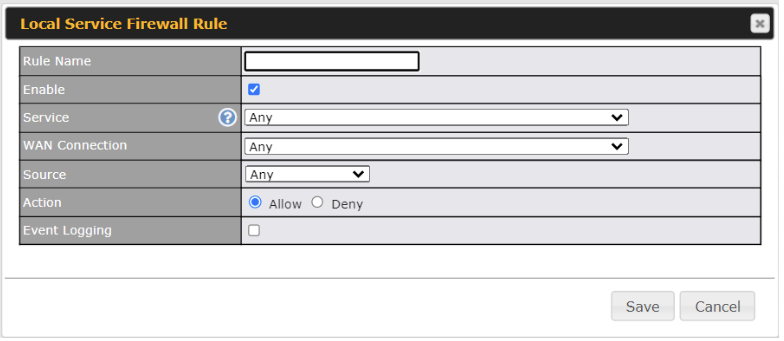
| Local Service Firewall Settings | |
| Rule Name | This setting specifies a name for the firewall rule. |
| Enable | This setting specifies whether the firewall rule should take effect.
If the box is checked, the firewall rule takes effect. If the traffic matches the specified protocol/IP/port, actions will be taken by Peplink Balance based on the other parameters of the rule. If the box is not checked, the firewall rule does not take effect. The Peplink Balance will disregard the other parameters of the rule. Click the dropdown menu next to the checkbox to place this firewall rule on a time schedule. |
| Service | This option allows you to define the supported local service to be matched.
If Any is chosen, the firewall rule will match to all supported local services from the list. Via a drop-down menu, the following services can be specified:
|
| WAN Connection | Select the WAN connection that this firewall rule should apply to. |
| Source | This specifies the source IP address and IP Network to be matched for the firewall rule. |
| Action | With the value of Allow for the Action setting, the matching traffic passes through the router (to be routed to the destination). If the value of the Action setting is set to Deny, the matching traffic does not pass through the router (and is discarded). |
| Event Logging | This setting specifies whether or not to log matched firewall events. The logged messages are shown on the page Status>Event Log. A sample message is as follows:
Aug 13 23:47:44 Denied CONN=Ethernet WAN SRC=20.3.2.1 DST=192.168.1.20 LEN=48 PROTO=TCP SPT=2260 DPT=80
|
Content Blocking#

Application Blocking
Choose applications to be blocked from LAN/PPTP/SpeedFusion VPN peer clients’ access, except for those on the Exempted User Groups or Exempted Subnets defined below.
Web Blocking
Defines website domain names to be blocked from LAN/PPTP/SpeedFusion VPN peer clients’ access except for those on the Exempted User Groups or Exempted Subnets defined below.
If “foobar.com” is entered, any web site with a host name ending in foobar.com will be blocked, e.g. www.foobar.com, foobar.com, etc. However, “myfoobar.com” will not be blocked.
You may enter the wild card “.*” at the end of a domain name to block any web site with a host name having the domain name in the middle. If you enter “foobar.*”, then “www.foobar.com”, “www.foobar.co.jp”, or “foobar.co.uk” will be blocked. Placing the wild card in any other position is not supported.
The device will inspect and look for blocked domain names on all HTTP and HTTPS traffic.
Customized Domains
Enter an appropriate website address, and the Pepwave MAX will block and disallow LAN/PPTP/SpeedFusionTM peer clients to access these websites. Exceptions can be added using the instructions in Sections 20.1.3.2 and 20.1.3.3.
You may enter the wild card “.*” at the end of a domain name to block any web site with a host name having the domain name in the middle. For example, If you enter “foobar.*,” then “www.foobar.com,” “www.foobar.co.jp,” or “foobar.co.uk” will be blocked. Placing the wild card in any other position is not supported.
The Pepwave MAX will inspect and look for blocked domain names on all HTTP traffic. Secure web (HTTPS) traffic is not supported.
Exempted User Groups
Check and select pre-defined user group(s) who can be exempted from the access blocking rules. User groups can be defined at QoS>User Groups section. Please refer to Section 17.1 for details.
Exempted Subnets
With the subnet defined in the field, clients on the particular subnet(s) can be exempted from the access blocking rules.
Ch19. Routing Protocols#
OSPF & RIPv2#
The Pepwave supports OSPF and RIPv2 dynamic routing protocols.
Click the Advanced tab from the top bar, and then click the Routing Protocols > OSPF & RIPv2 item on the sidebar to reach the following menu:
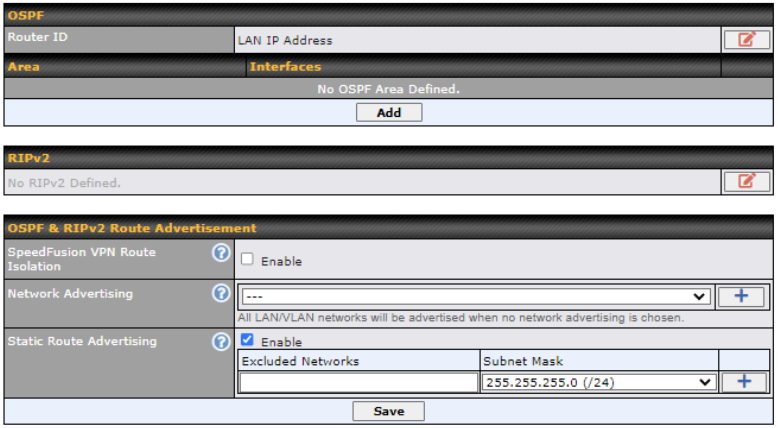
| OSPF | |
| Router ID | This field determines the ID of the router. By default, this is specified as the WAN IP address. If you want to specify your own ID, enter it into the Custom field. |
| Area | This is an overview of the OSPF areas that you have defined. Clicking on the name under Area allows you to configure the connection. To define a new area, click Add. To delete an existing area, click on the |
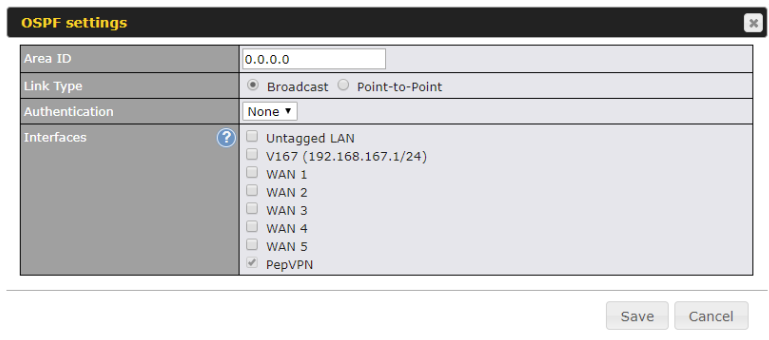
| OSPF Settings | |
| Area ID | Assign a name to be applied to this group. Machines linked to this group will send and receive related OSPF packets, while unlinked machines will ignore them. |
| Link Type | Choose the type of network that this area will use. |
| Authentication | If an authentication method is used, select one from this drop-down menu. Available options are MD5 and Text. Authentication key(s) may be input next to the drop-down menu after selecting an authentication method. |
| Interfaces | Select the interface(s) that this area will use to listen to and deliver OSPF packets. |
To access RIPv2 settings, click on ![]() .
.
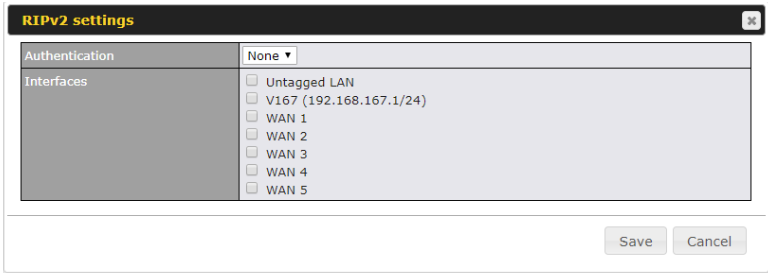
| RIPv2 Settings | |
| Authentication | If an authentication method is used, select one from this drop-down menu. Available options are MD5 and Text. Authentication key(s) may be input next to the drop-down menu after selecting an authentication method. |
| Interfaces | Select the interface(s) that this area will use to listen to and deliver RIPv2 packets. |

| OSPF & RIPv2 Route Advertisement | |
| SpeedFusion VPN Route Isolation | Isolate SpeedFusion VPN peers from each other. Received SpeedFusion VPN routes will not be forwarded to other SpeedFusion VPN peers to reduce bandwidth consumption.. |
| Network Advertising | Networks to be advertised over OSPF & RIPv2. If no network is selected, all LAN / VLAN networks will be advertised by default. |
| Static Route Advertising | Enabling OSPF & RIPv2 Route Advertising allows it to advertise LAN static routes over OSPF & RIPv2. Static routes on the Excluded Networks table will not be advertised. |
BGP#
Click the Advanced tab along the top bar, and then click the BGP item on the sidebar to configure BGP.

Click the “x” to delete a BGP profile.
Click “Add” to create a new BGP profile.

| BGP Profile | |
| Name | This field specifies the name that represents this profile. |
| Enable | When this box is checked, this BGP profile will be enabled. If it is left unchecked, it will be disabled. |
| Interface | The interface in which the BGP neighbor is located. |
| Router ID | This field specifies the unique IP as the identifier of the local device running BGP. |
| Autonomous System | The Autonomous System Number (ASN) assigned to this profile. |
| Neighbor | BGP Neighbors and their details. |
| IP address | The IP address of the Neighbor. |
| Autonomous System | The Neighbor’s ASN. |
| Multihop/TTL | This field determines the Time-to-live (TTL) of BGP packets. Leave this field blank if the BGP neighbor is directly connected, otherwise you must specify a TTL value. This option should be used if the configured Neighbor’s IP address does not match the selected Interface’s network subnets. The TTL value must be between 2 to 255. |
| Password | (Optional) Assign a password for MD5 authentication of BGP sessions. |
| AS-Path Prepending: | AS path to be prepended to the routes received from this Neighbor. Values must be ASN and separated by commas. For example: inputting “64530,64531” will prepend “64530, 64531” to received routes. |
| Hold Time | Wait time in seconds for a keepalive message from a Neighbor before considering the BGP connection as stalled.
The value must be either 0 (infinite hold time) or between 3 and 65535 inclusively. Default: 240 |
| Next Hop Self | Enable this option to advertise your own source address as the next hop when propagating routes. |
| iBGP Local Preference | This is the metric advertised to iBGP Neighbors to indicate the preference for external routes. The value must be between 0 to 4294967295 inclusively.
Default: 100 |
| BFD | Enable this option to add Bidirectional Forwarding Detection for path failure. All directly connected Neighbors that use the same physical interface share the same BFD settings. All mulithop Neighbors share the same multihop BFD settings. You can configure BFD settings in the BGP profile listing page after this option is enabled. |
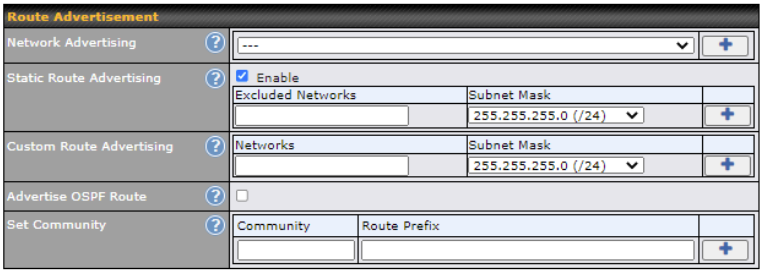
| Network Advertising | Select the Networks that will be advertised to the BGP Neighbor. |
| Static Route Advertising | Enable this option to advertise static LAN routes. Static routes that match the Excluded Networks table will not be advertised. |
| Custom Route Advertising | Additional routes to be advertised to the BGP Neighbor. |
| Advertise OSPF Route | When this box is checked, every learnt OSPF route will be advertised. |
| Set Community | Assign a prefix to a Community.
Community: Two numbers in new-format. e.g. 65000:21344 Well-known communities: no-export 65535:65281 no-advertise 65535:65282 no-export-subconfed 65535:65283 no-peer 65535:65284 Route Prefix: Comma separated networks. e.g. 172.168.1.0/24,192.168.1.0/28 |

| Filter Mode | This field allows for the selection of the filter mode for route import.
None: All BGP routes will be accepted. Accept: Routes in “Restricted Networks” will be accepted, routes not in the list will be rejected. Reject: Routes in “Blocked Networks” will be rejected, routes not in the list will be accepted. |
| Restricted Networks / Blocked Networks | This field specifies the network(s) in the “route import” entry.
Exact Match: When this box is checked, only routes with the same Network and Subnet Mask will be filtered. |

| Filter Mode | This field allows for the selection of the filter mode for route export.
None: All BGP routes will be accepted. Accept: Routes in “Restricted Networks” will be accepted, routes not in the list will be rejected. Reject: Routes in “Blocked Networks” will be rejected, routes not in the list will be accepted. |
| Restricted Networks / Blocked Networks | This field specifies the network(s) in the “route export” entry.
Exact Match: When this box is checked, only routes with the same Network and Subnet Mask will be filtered. |
| Export to other BGP Profile | When this box is checked, routes learnt from this BGP profile will be exported to other BGP profiles. |
| Export to OSPF | When this box is checked, routes learnt from this BGP profile will be exported to the OSPF routing protocol. |
Ch20. Remote User Access#
A remote-access VPN connection allows an individual user to connect to a private business network from a remote location using a laptop or desktop computer connected to the Internet. Networks routed by a Pepwave router can be remotely accessed via OpenVPN, L2TP with IPsec or PPTP. To configure this feature, navigate to Advanced > Remote User Access and choose the required VPN type.

| Remote User Access Settings | |
| Enable | When this box is checked, this Remote User Access profile will be enabled. If it is left unchecked, it will be disabled. |
| VPN Type | This field allows you to select the VPN type for the remote user access connection. The available options are:
If L2TP with IPsec is selected, it may need to enter the pre-shared key for the remote user access.
If PPTP selected, there is no additional configuration required. The Point-to-Point Tunneling Protocol (PPTP) is an obsolete method for implementing virtual private networks. PPTP has many well known security issues
If the OpenVPN is selected, the OpenVPN Client profile can be downloaded from the Status > Device page after the configuration has been saved.
You have a choice between 2 different OpenVPN Client profiles:
|
| Pre-shared Key | If L2TP with IPsec is selected in the VPN Type, enter the pre shared key in the text field. Please note that remote devices will need this preshared key to access the Balance. |
| Disabled Weak Ciphers | You may click the When checked, weak ciphers such as 3DES will be disabled. Please note: Legacy and Android devices may not able to connect. |
| Connection Security Refresh | If OpenVPN is selected in the VPN Type, this settings is for specifying the interval for refreshing the connection. |
| Listen On | This setting is for specifying the WAN IP addresses that allow remote user access. |
| Port | If OpenVPN is selected in the VPN Type, the Port setting specifies the port(s) that correspond to the service. |
| Authentication | Determine the method of authenticating remote users:
This setting allows you to define the Remote User Accounts. Click Add Note: The username must contain lowercase letters, numerics, underscore(_), dash(-), at sign(@), and period(.) only. |
Ch21. Miscellaneous Settings#
The miscellaneous settings include configuration for High Availability, Certificate Manager, service forwarding, service passthrough, GPS forwarding, GPIO, Groupe Networks and SIM Toolkit (depending the feature is supported on the model of Peplink router that is being used).
High Availability#
Many Pepwave routers support high availability (HA) configurations via an open standard virtual router redundancy protocol (VRRP, RFC 3768). In an HA configuration, two Pepwave routers provide redundancy and failover in a master-slave arrangement. In the event that the master unit is down, the slave unit becomes active. High availability will be disabled automatically where there is a drop-in connection configured on a LAN bypass port.
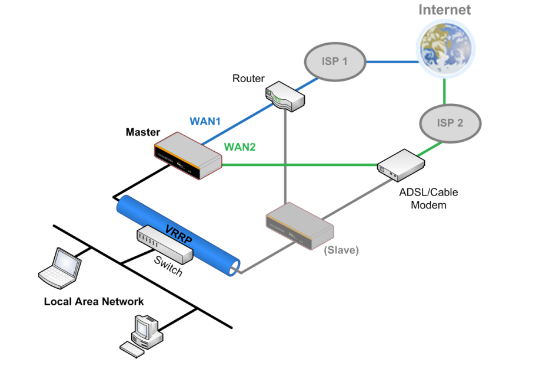
In the diagram, the WAN ports of each Pepwave router connect to the router and to the modem. Both Pepwave routers connect to the same LAN switch via a LAN port.
An elaboration on the technical details of the implementation of the virtual router redundancy protocol (VRRP, RFC 3768) by Pepwave routers follows:
- In an HA configuration, the two Pepwave routers communicate with each other using VRRP over the LAN.
- The two Pepwave routers broadcast heartbeat signals to the LAN at a frequency of one heartbeat signal per second.
- In the event that no heartbeat signal from the master Pepwave router is received in 3 seconds (or longer) since the last heartbeat signal, the slave Pepwave router becomes active.
- The slave Pepwave router initiates the WAN connections and binds to a previously configured LAN IP address.
- At a subsequent point when the master Pepwave router recovers, it will once again become active.
You can configure high availability at Advanced > Misc. Settings > High Availability.

| High Availability | |
| Enable | Checking this box specifies that the Pepwave router is part of a high availability configuration. |
| Group Number | This number identifies a pair of Pepwave routers operating in a high availability configuration. The two Pepwave routers in the pair must have the same Group Number value. |
| Preferred Role | This setting specifies whether the Pepwave router operates in master or slave mode. Click the corresponding radio button to set the role of the unit. One of the units in the pair must be configured as the master, and the other unit must be configured as the slave. |
| Resume Master Role Upon Recovery | This option is displayed when Master mode is selected in Preferred Role. If this option is enabled, once the device has recovered from an outage, it will take over and resume its Master role from the slave unit. |
| Configuration Sync. | This option is displayed when Slave mode is selected in Preferred Role. If this option is enabled and the Master Serial Number entered matches with the actual master unit’s, the master unit will automatically transfer the configuration to this unit. Please make sure the LAN IP Address and the Subnet Mask fields are set correctly in the LAN settings page. You can refer to the Event Log for the configuration synchronization status. |
| Master Serial Number | If Configuration Sync. is checked, the serial number of the master unit is required here for the feature to work properly. |
| Virtual IP | The HA pair must share the same Virtual IP. The Virtual IP and the LAN Administration IP must be under the same network. |
| LAN Administration IP | This setting specifies a LAN IP address to be used for accessing administration functionality. This address should be unique within the LAN. |
| Subnet Mask | This setting specifies the subnet mask of the LAN. |
| Important Note |
| For Pepwave routers in NAT mode, the virtual IP (VIP) should be set as the default gateway for all hosts on the LAN segment. For example, a firewall sitting behind the Pepwave router should set its default gateway as the virtual IP instead of the IP of the master router.
|
RADIUS Server#
RADIUS Server settings are located at Advanced > Misc. Settings > RADIUS Server.

To configure the Authentication Server and Accounting Server, click New Profile to display the following screen:
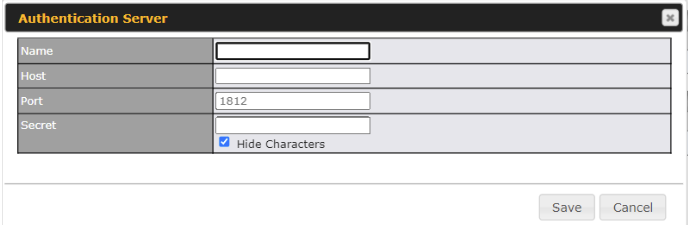
| Authentication Server | |
| Name | This field is for specifying a name to represent this profile. |
| Host | Specifies the IP address or hostname of the RADIUS server host. |
| Port | This setting specifies the UDP destination port for authentication requests. By default, the port number is 1812. |
| Secret | This field is for entering the secret key for communicating to the RADIUS server. |
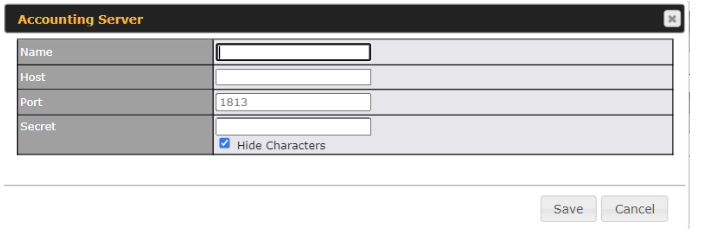
| Accounting Server | |
| Name | This field is for specifying a name to represent this profile. |
| Host | Specifies the IP address or hostname of the RADIUS server host. |
| Port | This setting specifies the UDP destination port for accounting requests. By default, the port number is 1813. |
| Secret | This field is for entering the secret key for communicating to the RADIUS server. |
Certificate Manager#
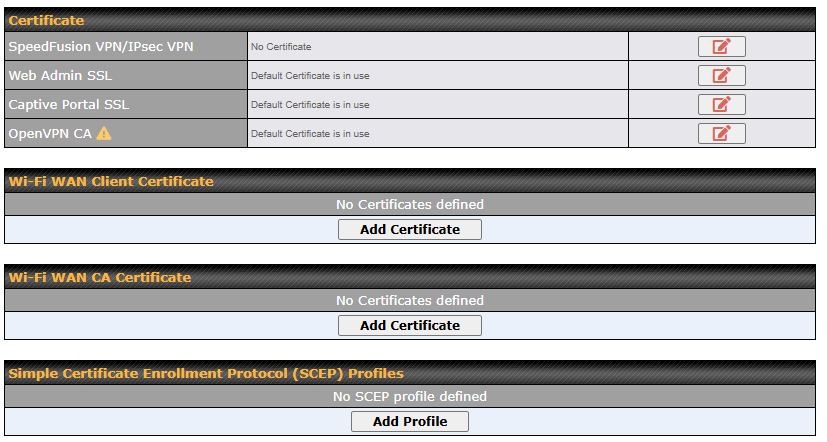
This section allows you to assign certificates to the Local VPN, Web Admin SSL, Captive Portal SSL, OpenVPN CA, Wi-Fi WAN Client Certificate, and Wi-Fi WAN CA Certificate.
The following knowledge base article describes how to create self-signed certificates and import them into a Peplink product.
https://forum.peplink.com/t/how-to-create-a-self-signed-certificate-and-import-it-to-a-peplink-product/
You may also set up SCEP profiles to enable automated certificate issuance and management.
| General Settings | ||
| Name | Profile Name | |
| Issuer | ||
| Enrollment Server URL | SCEP endpoint to obtain an enrollment certificate. For example, enter something like https://ndes.contoso.com/certsrv/mscep/mscep.dll. | |
| Password | SCEP server password. | |
| Certificate Renewal Interval | Days to renew/obtain an enrollment certificate. | |
| Certificate Subject | ||
| Common Name (CN) | Hostname for certificate is issued. (Required) | |
| Organization Unit (OU) | Department, section, trademark (Optional) | |
| Organization (O) | Organization name for certificated is issued. (Required) | |
| Locality (L) | City name (Optional) | |
| State (S) | State for certificated is issued. (Required) | |
| Country (C) | Country Code in two letter (eg. US) (Required) | |
| E-mail (E) | Email address (Optional) | |
| Configured Certificate | ||
| Certificates | Option to choose which service(s) to apply. | |
Service Forwarding#
Service forwarding settings are located at Advanced > Misc. Settings > Service Forwarding.

| Service Forwarding | |
| SMTP Forwarding | When this option is enabled, all outgoing SMTP connections destined for any host at TCP port 25 will be intercepted. These connections will be redirected to a specified SMTP server and port number. SMTP server settings for each WAN can be specified after selecting Enable. |
| Web Proxy Forwarding | When this option is enabled, all outgoing connections destined for the proxy server specified in Web Proxy Interception Settings will be intercepted. These connections will be redirected to a specified web proxy server and port number. Web proxy interception settings and proxy server settings for each WAN can be specified after selecting Enable. |
| DNS Forwarding | When this option is enabled, all outgoing DNS lookups will be intercepted and redirected to the built-in DNS name server. If any LAN device is using the DNS name servers of a WAN connection, you may want to enable this option to enhance the DNS availability without modifying the DNS server setting of the clients. The built-in DNS name server will distribute DNS lookups to corresponding DNS servers of all available WAN connections. In this case, DNS service will not be interrupted, even if any WAN connection is down. |
| Custom Service Forwarding | When custom service forwarding is enabled, outgoing traffic with the specified TCP port will be forwarded to a local or remote server by defining its IP address and port number. |
SMTP Forwarding#
Some ISPs require their users to send e-mails via the ISP’s SMTP server. All outgoing SMTP connections are blocked except those connecting to the ISP’s. Pepwave routers support intercepting and redirecting all outgoing SMTP connections (destined for TCP port 25) via a WAN connection to the WAN’s corresponding SMTP server.

To enable the feature, select Enable under SMTP Forwarding Setup. Check Enable Forwarding for the WAN connection(s) that needs forwarding. Under SMTP Server, enter the ISP’s e-mail server host name or IP address. Under SMTP Port, enter the TCP port number for each WAN.
The Pepwave router will intercept SMTP connections. Choose a WAN port according to the outbound policy, and then forward the connection to the SMTP server if the chosen WAN has enabled forwarding. If the forwarding is disabled for a WAN connection, SMTP connections for the WAN will be simply be forwarded to the connection’s original destination.
| Note |
| If you want to route all SMTP connections only to particular WAN connection(s), you should create a custom rule in outbound policy (see Section 14.2). |
Web Proxy Forwarding#
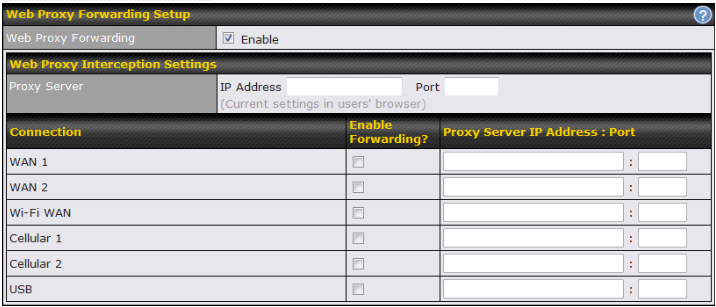
When this feature is enabled, the Pepwave router will intercept all outgoing connections destined for the proxy server specified in Web Proxy Interception Settings, choose a WAN connection with reference to the outbound policy, and then forward them to the specified web proxy server and port number. Redirected server settings for each WAN can be set here. If forwarding is disabled for a WAN, web proxy connections for the WAN will be simply forwarded to the connection’s original destination.
DNS Forwarding#

When DNS forwarding is enabled, all clients’ outgoing DNS requests will also be intercepted and forwarded to the built-in DNS proxy server.
Custom Service Forwarding#

After clicking the enable checkbox, enter your TCP port for traffic heading to the router, and then specify the IP Address and Port of the server you wish to forward to the service to.
Service Passthrough#
Service passthrough settings can be found at Advanced>Misc. Settings>Service Passthrough.
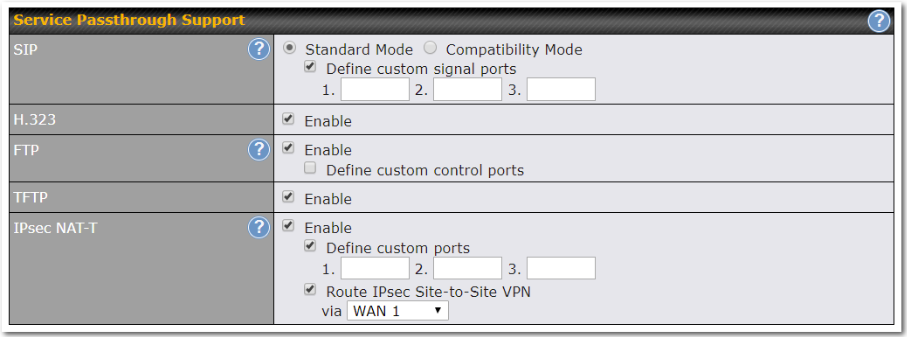
Some Internet services need to be specially handled in a multi-WAN environment. Pepwave routers can handle these services such that Internet applications do not notice being behind a multi-WAN router. Settings for service passthrough support are available here.
| Service Passthrough Support | |
| SIP | Session initiation protocol, aka SIP, is a voice-over-IP protocol. The Pepwave router can act as a SIP application layer gateway (ALG) which binds connections for the same SIP session to the same WAN connection and translate IP address in the SIP packets correctly in NAT mode. Such passthrough support is always enabled, and there are two modes for selection: Standard Mode and Compatibility Mode. If your SIP server’s signal port number is non-standard, you can check the box Define custom signal ports and input the port numbers to the text boxes. |
| H.323 | With this option enabled, protocols that provide audio-visual communication sessions will be defined on any packet network and pass through the Pepwave router. |
| FTP | FTP sessions consist of two TCP connections; one for control and one for data. In a multi-WAN situation, they must be routed to the same WAN connection. Otherwise, problems will arise in transferring files. By default, the Pepwave router monitors TCP control connections on port 21 for any FTP connections and binds TCP connections of the same FTP session to the same WAN. If you have an FTP server listening on a port number other than 21, you can check Define custom control ports and enter the port numbers in the text boxes. |
| TFTP | The Pepwave router monitors outgoing TFTP connections and routes any incoming TFTP data packets back to the client. Select Enable if you want to enable TFTP passthrough support. |
| IPsec NAT-T | This field is for enabling the support of IPsec NAT-T passthrough. UDP ports 500, 4500, and 10000 are monitored by default. You may add more custom data ports that your IPsec system uses by checking Define custom ports. If the VPN contains IPsec site-to-site VPN traffic, check Route IPsec Site-to-Site VPN and choose the WAN connection to route the traffic to. |
Ignition Sensing#
Ignition Sensing detects the ignition signal status of a vehicle it is installed in.
This feature allows the cellular router to start up or shut down when the engine of that vehicle is started or turned off.
The time delay setting between ignition off and power down of the router is a configurable setting, which allows the router to stay on for a period of time after the engine of a vehicle is turned off.
Ignition Sensing installation
| Function | Colour Wire | ||
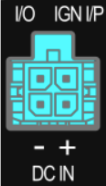 |
I/O | Digital Input / Digital Output / Analog Input | Brown |
| IGN I/P | Digital Input / Ignition Sensing | Orange | |
| DC IN – |
connected to permanent negative feed (ground) | Black | |
|
DC IN + |
connected to permanent positive feed (power) | Red | |
Connectivity diagram for devices with 4-pin connector
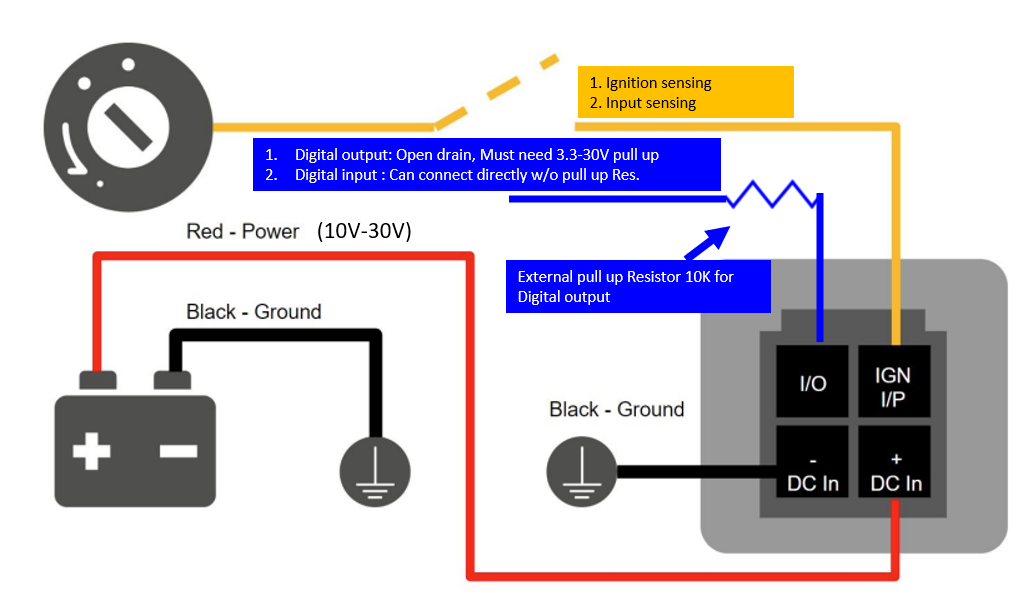
Connectivity diagram for devices with terminal block connection
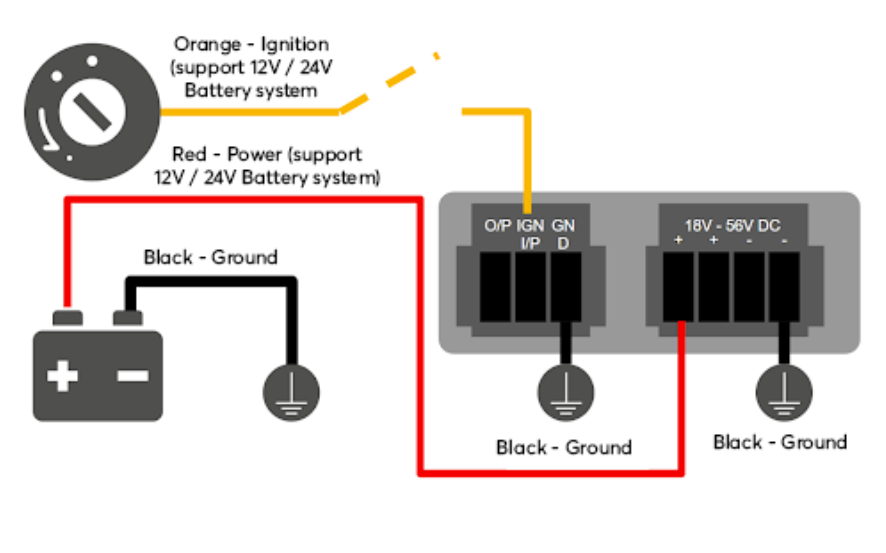
GPIO Menu
Note: This feature is applicable for certain models that come with a GPIO interface.
Ignition Sensing options can be found in Advanced > GPIO.
The configurable option for Ignition Input is Delay; the time in seconds that the router stays powered on after the ignition is turned off.
a.) Ignition sensing: 9-30V active high for IGN purpose
b.) Input Sensing: I/O input

The O/P (connected to the I/O pin on a 4 pin connector) can be configured as a digital input, a digital output, or an analog input.
Digital Input – the connection supports input sensing; it reads the external input and determines if the settings should be ‘High’ (on) or ‘Low’ (off).
State Name – This field is to custom names shows on event log when digital input is high or low.
Digital Output – when there is a healthy WAN connection, the output pin is marked as ‘High’ (on). Otherwise, it will be marked as ‘Low’ (off).
a.) Digital output:
Open drain for IO output. It is required to add an external pull up resistor of 10K for 3.3-30V pull up voltage.
(DO NOT exceed 250mA)
3.3-30V active high, 0.05-0.5V active low(mapping to 3.3-30V pull up voltage)
b.) Digital input: I/O input

Note: The Digital Output state (on/off) upon rebooting the device may vary depending on the model, eg. MAX BR1 MK2 = Persistent; MAX Transit Mini with ContentHub = Reset to default, etc.
Analog Input – to be confirmed. In most cases, it should read the external input and determine the voltage level.
NTP Server#
Pepwave routers can now serve as a local NTP server. Upon start up, it is now able to provide connected devices with the accurate time, precise UTC from either an external NTP server or via GPS and ensuring that connected devices always receive the correct time.
Compatible with: BR1 ENT, BR1 Pro CAT-20/5G, 700 HW3, HD2/4, Transit
NTP Server setting can be found via: Advanced>Misc. Settings>NTP Server

Time Settings can be found at System>Time>Time Settings

Grouped Networks#
Advanced > Grouped Networks allows you to configure destination networks in a grouped format.

Select Add Group to create a new group with single IP addresses, subnets from different VLANs, or domain names.


The created network groups can be used in outbound policies and firewall rules.
SIM Toolkit#
The SIM Toolkit, accessible via Advanced > Misc Settings > SIM Toolkit, supports two functionalities, USSD and SMS.
USSD
Unstructured Supplementary Service Data (USSD) is a protocol used by mobile phones to communicate with their service provider’s computers. One of the most common uses is to query the available balance.

Enter your USSD code under the USSD Code text field and click Submit.

You will receive a confirmation. To check the SMS response, click Get.

After a few minutes you will receive a response to your USSD code

SMS
The SMS option allows you to read SMS (text) messages that have been sent to the SIM in your Pepwave router.
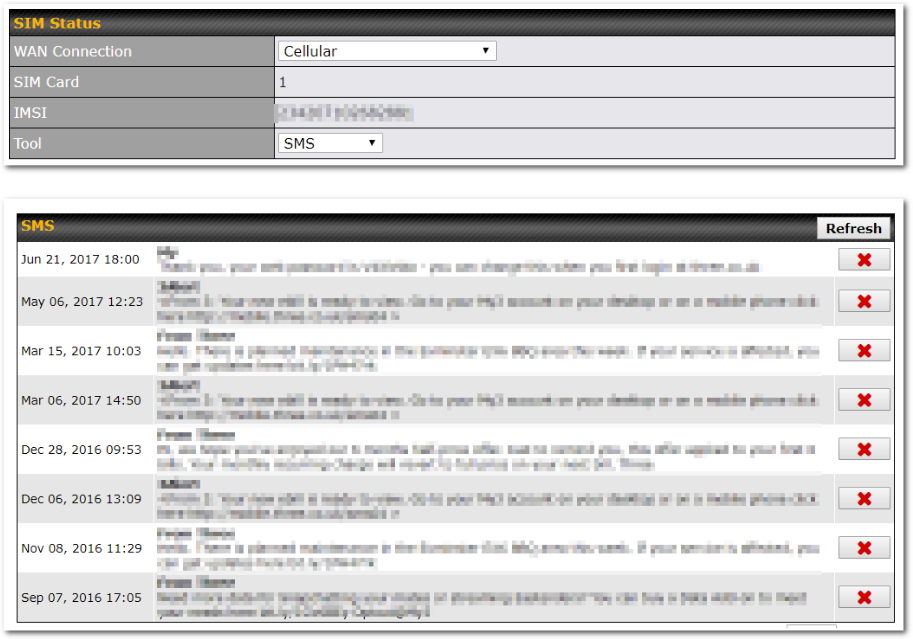
UDP Relay#
You may define the UDP relay by clicking the Advanced > Misc Settings > UDP Relay. You can click ![]() to enable the UDP relay to relay UDP Broadcast or Multicast traffic for LAN/VLAN/SpeedFusion VPN.
to enable the UDP relay to relay UDP Broadcast or Multicast traffic for LAN/VLAN/SpeedFusion VPN.
![]()
Click “New UDP Relay Rule” to define the relay rule.


| UDP Relay | |
| Name | This field is for specifying a name to represent this profile. |
| Port | This feid is to enter the specific port number for the UDP relay |
| Multicast | If Multicast is not selected, it will broadcast relay rule. If Multicast is selected, you may need to enter a valid multicast address. |
| Secure Network | Select the specific connection as a source network to where the device is to relay UDP Broadcast packets. |
| Destination Network | You may select the specific connection from the drop-down list or may custom combination network as a destination network that receives the UDP packet relays. |
Ch22. AP#
AP Controller#
The AP controller acts as a centralized controller of Pepwave Access Points.
With this feature, users can customize and manage up to 1500 Access Points from a single Pepwave router interface.
To configure, navigate to the AP tab. and the following screen appears.

| AP Controller | |
| AP Management | The AP controller for managing Pepwave APs can be enabled by checking this box. When this option is enabled, the AP controller will wait for management connections originating from APs over the LAN on TCP and UDP port 11753. It will also wait for captive portal connections on TCP port 443. An extended DHCP option, CAPWAP Access Controller addresses (field 138), will be added to the DHCP server. A local DNS record, AP Controller, will be added to the local DNS proxy. |
| Sync Method |
|
| Permitted AP | Access points to manage can be specified here. If Any is selected, the AP controller will manage any AP that reports to it. If Approved List is selected, only APs with serial numbers listed in the provided text box will be managed. |
Wireless SSID#

Current SSID information appears in the SSID section. To edit an existing SSID, click its name in the list. To add a new SSID, click Add. Note that the following settings vary by model.
The below settings ishows a new SSID window with Advanced Settings enabled (these are available by selecting the question mark in the top right corner).
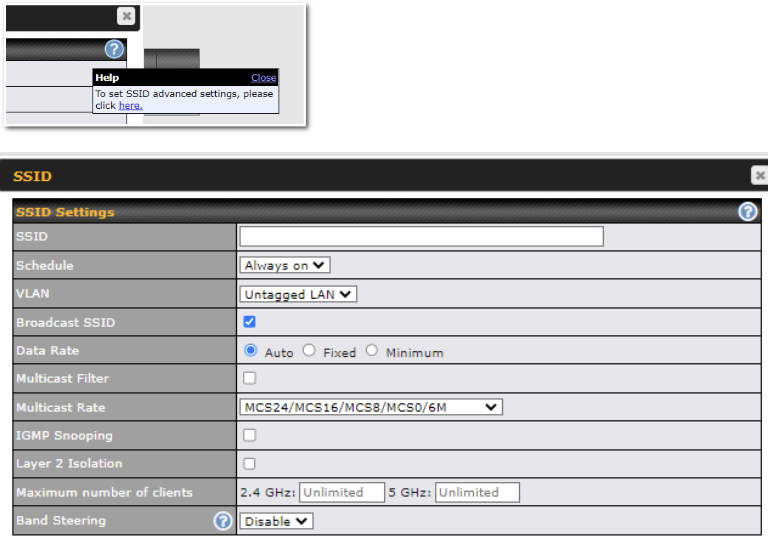
| SSID Settings | |
| SSID | This setting specifies the SSID of the virtual AP to be scanned by Wi-Fi clients. |
| Enable | Click the drop-down menu to apply a time schedule to this interface |
| VLAN | This setting specifies the VLAN ID to be tagged on all outgoing packets generated from this wireless network (i.e., packets that travel from the Wi-Fi segment through the Pepwave AP One unit to the Ethernet segment via the LAN port). The default value of this setting is 0, which means VLAN tagging is disabled (instead of tagged with zero). |
| Broadcast SSID | This setting specifies whether or not Wi-Fi clients can scan the SSID of this wireless network. Broadcast SSID is enabled by default. |
| Data Rate^ | Select Auto to allow the Pepwave router to set the data rate automatically, or select Fixed and choose a rate from the displayed drop-down menu. |
| Multicast Filter^ | This setting enables the filtering of multicast network traffic to the wireless SSID. |
| Multicast Rate^ | This setting specifies the transmit rate to be used for sending multicast network traffic. The selected Protocol and Channel Bonding settings will affect the rate options and values available here. |
| IGMP Snooping^ | To allow the Pepwave router to listen to internet group management protocol (IGMP) network traffic, select this option. |
| DHCP Option 82^ | If you use a distributed DHCP server/relay environment, you can enable this option to provide additional information on the manner in which clients are physically connected to the network. |
| Layer 2 Isolation^ | Layer 2 refers to the second layer in the ISO Open System Interconnect model.
When this option is enabled, clients on the same VLAN, SSID, or subnet are isolated to that VLAN, SSID, or subnet, which can enhance security. Traffic is passed to the upper communication layer(s). By default, the setting is disabled. |
| Maximum Number of Clients | Indicate the maximum number of clients that should be able to connect to each frequency. |
^ Advanced feature. Click the ![]() button on the top right-hand corner to activate.
button on the top right-hand corner to activate.

| Security Settings | |
| Security Policy | This setting configures the wireless authentication and encryption methods. Available options are:
To allow any Wi-Fi client to access your AP without authentication, select Open (No Encryption). Details of each available authentication method follow. |

| Enhanced Open (OWE) | |
| Transition Mode | With the option enabled, legacy clients will be able to connect in Open mode. With the option disabled, legacy clients will not be able to connect. OWE-supported clients will always connect in OWE mode. |

| WPA3 – Personal | |
| Shared Key | Enter a passphrase of between 8 and 63 alphanumeric characters to create a passphrase used for data encryption and authentication. Click Hide / Show Characters to toggle visibility. |
| Fast Transition | Fast Transition
[802.11r] When this option is ticked, the transition process for a mobile client is improved as it moves between access points. |

| WPA3 – Enterprise | |
| 802.1X Version | Choose v1 or v2 of the 802.1x EAPOL. When v1 is selected, both v1 and v2 clients can associate with the access point. When v2 is selected, only v2 clients can associate with the access point. Most modern wireless clients support v2. For stations that do not support v2, select v1. The default is v2. |
| Fast Transition | Fast Transition
[802.11r] When this option is ticked, the transition process of a mobile client is improved as it moves between access points. |

| WPA2/WPA3 – Personal | |
| Shared Key | Enter a passphrase of between 8 and 63 alphanumeric characters to create a passphrase used for data encryption and authentication. Click Hide / Show Characters to toggle visibility. |
| Management Frame Protection | This feature protects stations against forged management frames spoofed from other devices. Frames that are protected include Disassociation, Deauthentication, and QoS Action. |
| Fast Transition | Fast Transition
[802.11r] When this option is ticked, the transition process of a mobile client is improved as it moves between access points. |

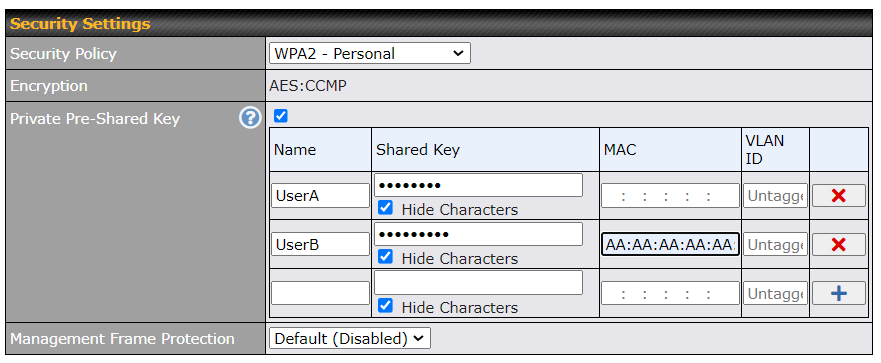
| WPA2 – Personal | |||||||||
| Private Shared Key | Enable the Private Pre-Shared Key (PPSK) option to set unique pre-shared keys for individual users or groups on the same SSID. Please provide the following information for each user or group:
*Each “Shared Key + MAC” combination must be unique in a different profile. |
||||||||
| Shared Key | Enter a passphrase of between 8 and 63 alphanumeric characters to create a passphrase used for data encryption and authentication. Click Hide / Show Characters to toggle visibility. | ||||||||
| Management Frame Protection | This feature protects stations against forged management frames spoofed from other devices. Frames that are protected include Disassociation, Deauthentication, and QoS Action. | ||||||||
| Fast Transition | Fast Transition
[802.11r] When this option is ticked, the transition process of a mobile client is improved as it moves between access points. |
||||||||

| WPA2 – Enterprise | |
| 802.1X Version | Choose v1 or v2 of the 802.1x EAPOL. When v1 is selected, both v1 and v2 clients can associate with the access point. When v2 is selected, only v2 clients can associate with the access point. Most modern wireless clients support v2. For stations that do not support v2, select v1. The default is v2. |
| Management Frame Protection | This feature protects stations against forged management frames spoofed from other devices. Frames that are protected include Disassociation, Deauthentication, and QoS Action. |
| Fast Transition | Fast Transition
[802.11r] When this option is ticked, the transition process of a mobile client is improved as it moves between access points. |

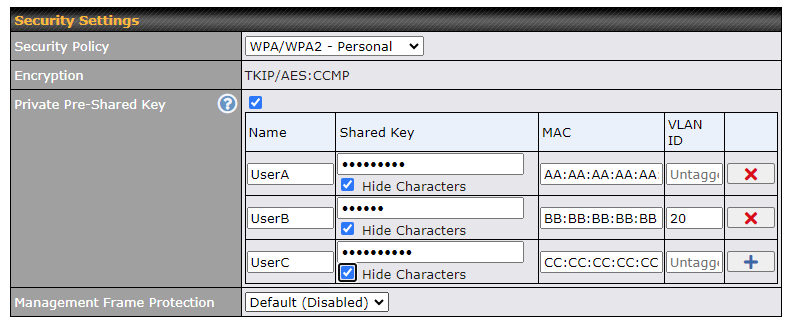
| WPA/WPA2 – Personal | |||||||||
| Private Shared Key | Enable the Private Pre-Shared Key (PPSK) option to set unique pre-shared keys for individual users or groups on the same SSID. Please provide the following information for each user or group:
*Each “Shared Key + MAC” combination must be unique in a different profile. |
||||||||
| Shared Key | Enter a passphrase of between 8 and 63 alphanumeric characters to create a passphrase used for data encryption and authentication. Click Hide / Show Characters to toggle visibility. | ||||||||
| Management Frame Protection | This feature protects stations against forged management frames spoofed from other devices. Frames that are protected include Disassociation, Deauthentication and QoS Action. | ||||||||

| WPA/WPA2 – Enterprise | |
| 802.1X Version | Choose v1 or v2 of the 802.1x EAPOL. When v1 is selected, both v1 and v2 clients can associate with the access point. When v2 is selected, only v2 clients can associate with the access point. Most modern wireless clients support v2. For stations that do not support v2, select v1. The default is v2. |
| Management Frame Protection | This feature protects stations against forged management frames spoofed from other devices. Frames that are protected include Disassociation, Deauthentication and QoS Action. |

| Access Control | |
| Restricted Mode | The settings allow the administrator to control access using MAC address filtering. Available options are None, Deny all except listed, Accept all except listed and Radius MAC Authentication. |
| MAC Address List | Connection coming from the MAC addresses in this list will be either denied or accepted based on the option selected in the previous field.
If more than one MAC address needs to be entered, you can use a carriage return to separate them. |
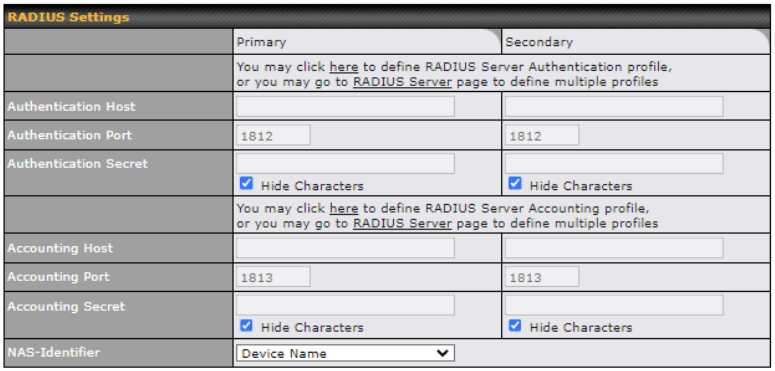
| RADIUS Settings | |
| Authentication Host | This field is for specifying the IP address of the primary RADIUS server for Authentication and, if applicable, the secondary RADIUS server. |
| Authentication Port | In the field, the UDP authentication port(s) used by your RADIUS server(s) or click the Default is 1812. |
| Authentication Secret | This settings is enter the RADIUS shared secret for the primary server and, if applicable, the secondary RADIUS server. |
| Accounting Host | This field is for specifying the IP address of the primary RADIUS server for Accounting and, if applicable, the secondary RADIUS server. |
| Accounting Port | In the field, enter the UDP accounting port(s) used by your RADIUS server(s) or click the Default is 1813. |
| Accounting Secret | This settings is enter the RADIUS shared secret for the primary server and, if applicable, the secondary RADIUS server. |
| NAS-Identifier | Choose between Device Name, LAN MAC address, Device Serial Number and Custom Value |

| Guest Protect | |
| Block All Private IP | Check this box to deny all connection attempts by private IP addresses. |
| Custom Subnet | To create a custom subnet for guest access, enter the IP address and choose a subnet mask from the drop-down menu. |
| Block Exception | To block access from a particular subnet, enter the IP address and choose a subnet mask from the drop-down menu. |

| Firewall Settings | |
| Firewall Mode | The settings allow administrators to control access to the SSID based on Firewall Rules.
Available options are Disable, Lockdown – Block all except… and Flexible -Allow all except… |
| Firewall Exceptions | Create Firewall Rules based on Port, IP Network, MAC address or Domain Name |
Wireless Mesh#

Wireless Mesh Support is available on devices running 802.11ac (Wi-Fi 5) and above. Along with the AP Controller, mesh network extensions can be established, which can expand network coverage. Note that the Wireless Mesh settings need to match the Mesh ID and Shared Key of the other devices on the same selected frequency band.
To create a new Wireless Mesh profile, go to AP > Wireless Mesh, and click Add.

| Wireless Mesh Settings | |
| Mesh ID | Enter a name to represent the Mesh profile. |
| Frequency | Select the 2.4GHz or 5GHz frequency to be used. |
| Shared Key | Enter the shared key in the text field. Please note that it needs to match the shared keys of the other APs in the Wireless Mesh settings.
Click Hide / Show Characters to toggle visibility. |
Settings#
To configure the AP settings, navigating to AP > Settings :
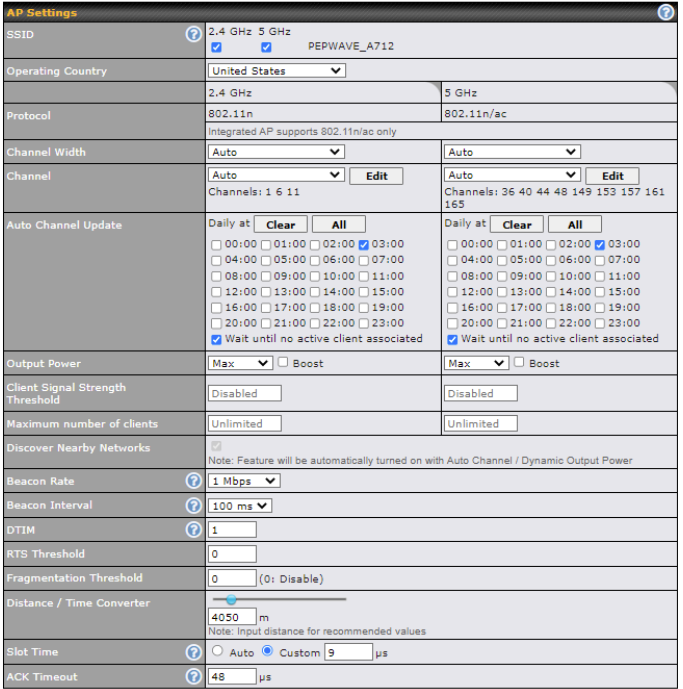
| AP Settings | |
| SSID | These buttons specify which wireless networks will use this AP profile. You can also select the frequencies at which each network will transmit. Please note that the Pepwave MAX does not detect whether the AP is capable of transmitting at both frequencies. Instructions to transmit at unsupported frequencies will be ignored by the AP. |
| Operating Country | This drop-down menu specifies the national / regional regulations which the AP should follow.
Note: Users are required to choose an option suitable to local laws and regulations. Per FCC regulation, the country selection is not available on all models marketed in the US. All US models are fixed to US channels only. |
| Preferred Frequency | These buttons determine the frequency at which access points will attempt to broadcast. This feature will only work for APs that can transmit at both 5.4GHz and 5GHz frequencies. |
| Protocol | This option allows you to specify whether 802.11b and/or 802.11g client association requests will be accepted. Available options are 802.11ng and 802.11na. By default, 802.11ng is selected. |
| Channel Width | There are three options: 20 MHz, 20/40 MHz, and 40 MHz. With this feature enabled, the Wi-Fi system can use two channels at once. Using two channels improves the performance of the Wi-Fi connection. |
| Channel | This drop-down menu selects the 802.11 channel to be utilized. Available options are from 1 to 11 and from 1 to 13 for the North America region and Europe region, respectively. (Channel 14 is only available when the country is selected as Japan with protocol 802.11b.) If Auto is set, the system will perform channel scanning based on the scheduled time set and choose the most suitable channel automatically. |
| Auto Channel Update | Indicate the time of day at which update automatic channel selection. |
| Output Power | This drop-down menu determines the power at which the AP under this profile will broadcast. When fixed settings are selected, the AP will broadcast at the specified power level, regardless of context. When Dynamic settings are selected, the AP will adjust its power level based on its surrounding APs in order to maximize performance.
The Dynamic: Auto setting will set the AP to do this automatically. Otherwise, the Dynamic: Manual setting will set the AP to dynamically adjust only if instructed to do so. If you have set Dynamic:Manual, you can go to AP>Toolbox>Auto Power Adj. to give your AP further instructions. If you click the Boost checkbox, the AP under this profile will transmit using additional power. Please note that using this option with several APs in close proximity will lead to increased interference. |
| Client Signal Strength Threshold | This field determines that maximum signal strength each individual client will receive. The measurement unit is megawatts. |
| Max number of Clients | This field determines the maximum clients that can be connected to APs under this profile. |
| Management VLAN ID | This field specifies the VLAN ID to tag to management traffic, such as AP to AP controller communication traffic. The value is 0 by default, meaning that no VLAN tagging will be applied.
Note: change this value with caution as alterations may result in loss of connection to the AP controller. |
| Discover Nearby NetworksA | This option is to turn on and off to scan the nearby the AP.
Note: Feature will be automatically turned on with Auto Channel / Dynamic Output Power |
| Beacon RateA | This drop-down menu provides the option to send beacons in different transmit bit rates. The bit rates are 1Mbps, 2Mbps, 5.5Mbps, 6Mbps, and 11Mbps. |
| Beacon IntervalA | This drop-down menu provides the option to set the time between each beacon send. Available options are 100ms, 250ms, and 500ms. |
| DTIMA | This field provides the option to set the frequency for beacon to include delivery traffic indication message (DTIM). The interval unit is measured in milliseconds. |
| RTS ThresholdA | This field provides the option to set the minimum packet size for the unit to send an RTS using the RTS/CTS handshake. Setting 0 disables this feature. |
| Fragmentation ThresholdA | Determines the maximum size (in bytes) that each packet fragment will be broken down into. Set 0 to disable fragmentation. |
| Distance/Time ConverterA | Select the distance you want your Wi-Fi to cover in order to adjust the below parameters. Default values are recommended. |
| Slot TimeA | This field provides the option to modify the unit wait time before it transmits. The default value is 9μs. |
| ACK TimeoutA | This field provides the option to set the wait time to receive acknowledgement packet before doing retransmission. The default value is 48μs. |
A – Advanced feature. Click the ![]() button on the top right-hand corner to activate.
button on the top right-hand corner to activate.
| Important Note |
| Per FCC regulation, the country selection is not available on all models marketed in the US. All US models are fixed to US channels only. |
![]()
The device with integrated AP can operate under the Wi-Fi Operating Mode, and the default setting is WAN + AP mode:
Note: This option is available for selected devices only (HD2/HD4 and HD2/HD4 MBX).
| Integrated AP | |
| WAN | In this mode, all Wi-Fi will operate as Wi-Fi WAN and no integrated Wi-Fi AP will be operated on this device.
If Wi-Fi Operating mode is choosing WAN, The status indicated by the front panel LED is as follows:
|
| WAN + AP | In this mode, some Wi-Fi will operate as Wi-Fi WAN. Some other Wi-Fi WANs will be forced offline and their Wi-Fi resources will be reserved for integrated Wi-Fi AP operations.
If Wi-Fi Operating mode is choosing WAN + AP, The status indicated by the front panel LED is as follows:
|
| AP | In this mode, all Wi-Fi functions as integrated Wi-Fi AP. All Wi-Fi WANs will be forced to go offline.
If Wi-Fi Operating mode is choosing AP, The status indicated by the front panel LED is as follows:
|

| Web Administration Settings (on External AP) | |
| Enable | Check the box to allow the Pepwave router to manage the web admin access information of the AP. |
| Web Access Protocol | These buttons specify the web access protocol used for accessing the web admin of the AP. The two available options are HTTP and HTTPS. |
| Management Port | This field specifies the management port used for accessing the device. |
| HTTP to HTTPS Redirection | This option will be available if you have chosen HTTPS as the Web Access Protocol. With this enabled, any HTTP access to the web admin will redirect to HTTPS automatically. |
| Admin User Name | This field specifies the administrator username of the web admin. It is set as admin by default. |
| Admin Password | This field allows you to specify a new administrator password. You may also click the Generate button and let the system generate a random password automatically. |

This allows users to configure AP Time Settings (both Timezone and NTP) in AP Controller.
| AP Time Settings | |
| Time Zone | This field is to select the time zone for the AP controller. |
| Time Server | This field is to select the time server for the AP controller. |

This settings is to allow user to manage external AP’s controller unreachable action. When Manage Unreachable Action is checked, there will have 2 options which are “None” and “Radio Off“.

This is an option to enable client load balancing for AP Controller. When the option is enabled, it is trying to balance the station count on APs within the same profile.
Some Pepwave models displays a screen similar to the one shown below, navigating to AP > Settings:

| Wi-Fi Radio Settings | |
| Operating Country | This option sets the country whose regulations the Pepwave router follows. |
| Wi-Fi Antenna | Wi-Fi Antenna Choose from the router’s internal or optional external antennas, if so equipped. |
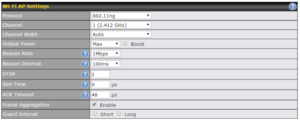
| Wi-Fi AP Settings | |
| Protocol | This option allows you to specify whether 802.11b and/or 802.11g client association requests will be accepted. Available options are 802.11ng and 802.11na. By default, 802.11ng is selected. |
| Channel | This option allows you to select which 802.11 RF channel will be used. Channel 1 (2.412 GHz) is selected by default. |
| Channel Width | Auto (20/40 MHz) and 20 MHz are available. The default setting is Auto (20/40 MHz), which allows both widths to be used simultaneously. |
| Output Power | This option is for specifying the transmission output power for the Wi-Fi AP. There are 4 relative power levels available – Max, High, Mid, and Low. The actual output power will be bound by the regulatory limits of the selected country. |
| Beacon RateA | This option is for setting the transmit bit rate for sending a beacon. By default, 1Mbps is selected. |
| Beacon IntervalA | This option is for setting the time interval between each beacon. By default, 100ms is selected. |
| DITMA | This field allows you to set the frequency for the beacon to include a delivery traffic indication message. The interval is measured in milliseconds. The default value is set to 1 ms. |
| Slot TimeA | This field is for specifying the wait time before the Router transmits a packet. By default, this field is set to 9 µs. |
| ACK TimeA | This field is for setting the wait time to receive an acknowledgement packet before performing a retransmission. By default, this field is set to 48 µs. |
| Frame AggreagtionA | This option allows you to enable frame aggregation to increase transmission throughput. |
| Guard IntervalA | This setting allows choosing a short or long guard period interval for your transmissions. |
Ch23. AP Controller Status#
Info#
A comprehensive overview of your AP can be accessed by navigating to AP > Controller Status > Info.
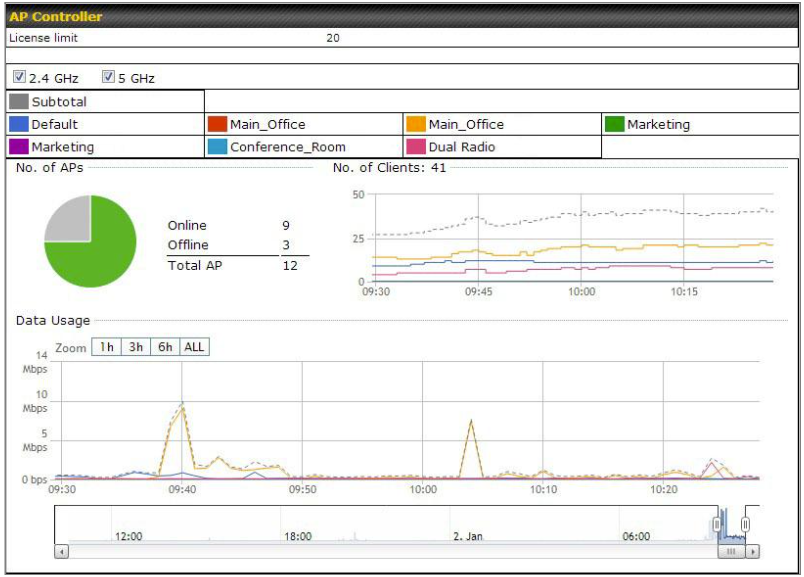
| AP Controller | |
| License Limit | This field displays the maximum number of AP your Balance router can control. You can purchase licenses to increase the number of AP you can manage. |
| Frequency | Underneath, there are two check boxes labeled 2.4 Ghz and 5 Ghz. Clicking either box will toggle the display of information for that frequency. By default, the graphs display the number of clients and data usage for both 2.4GHz and 5 GHz frequencies. |
| SSID | The colored boxes indicate the SSID to display information for. Clicking any colored box will toggle the display of information for that SSID. By default, all the graphs show information for all SSIDs. |
| No. of APs | This pie chart and table indicates how many APs are online and how many are offline. |
| No.of Clients | This graph displays the number of clients connected to each network at any given time. Mouse over any line on the graph to see how many clients connected to a specific SSID for that point in time. |
| Data Usage | This graph enables you to see the data usage of any SSID for any given time period. Mouse over any line on the graph to see the data usage by each SSID for that point in time. Use the buttons next to Zoom to select the time scale you wish to view. In addition, you could use the sliders at the bottom to further refine your timescale. |
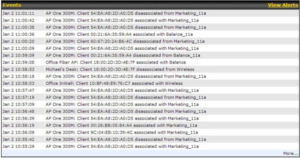 0
0
| Events |
| This event log displays all activity on your AP network, down to the client level. Click View Alerts to see only alerts, and click the More… link for additional records. |

This allow user to configure AP Time Settings (both Timezone and NTP) in AP Controller.
| AP Time Settings | |
| Time Zone | Ths field is to select the time zone for the AP controller. |
| Time Server | Ths field is to select the time server for the AP controller. |

This settings is to allow user to manage external AP’s controller unreachable action. When Manage Unreachable Action is checked, there will have 2 options which are “None” and “Radio Off“.

This is an option to enable client load balancing for AP Controller. When the option is enabled, it is trying to balance the station count on APs within the same profile.
Access Point#
A detailed breakdown of data usage for each AP is available at AP > Controller Status > Access Point.

| Managed APs | |
| Managed APs | This table shows the detailed information on each AP, including channel, number of clients, upload traffic, and download traffic. Click the blue arrows at the left of the table to expand and collapse information on each device group.
On the right of the table, you will see the following icons: Click the
For easier network management, you can give each client a name and designate its location. You can also designate which firmware pack (if any) this client will follow, as well as the channels on which the client will broadcast. Click the
Click the Event tab next to Wireless Usage to view a detailed event log for that particular device:
|
Wireless SSID#
In-depth SSID reports are available under AP > Controller Status > Wireless SSID.
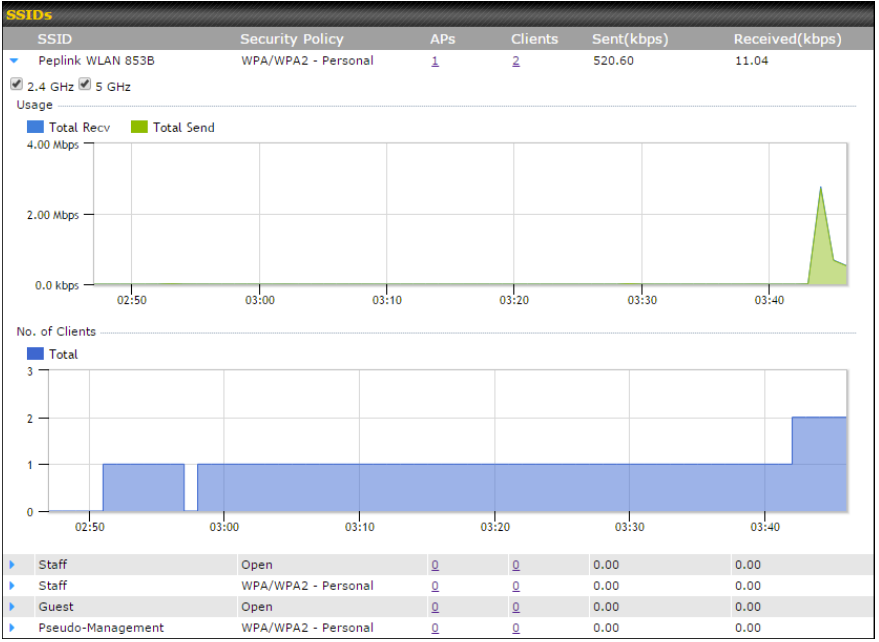
Click the blue arrow on any SSID to obtain more detailed usage information on each SSID.
Wireless Client#
You can search for specific Wi-Fi users by navigating to AP > Controller Status > Wireless Client.
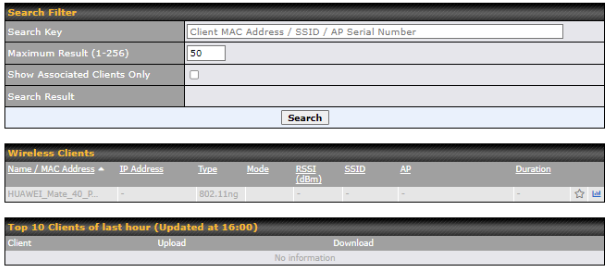
Here, you will be able to see your network’s heaviest users as well as search for specific users. Click the ![]() icon to bookmark specific users, and click the
icon to bookmark specific users, and click the ![]() icon for additional details about each user:
icon for additional details about each user:
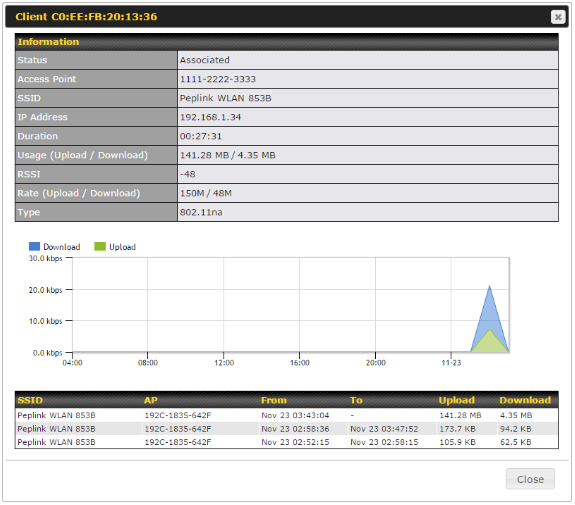
Mesh / WDS#
Mesh / WDS allows you to monitor the status of your wireless distribution system (WDS) or Mesh, and track activity by MAC address by navigating to AP > Controller Status > Mesh / WDS. This table shows the detailed information of each AP, including protocol, transmit rate (sent / received), signal strength, and duration.
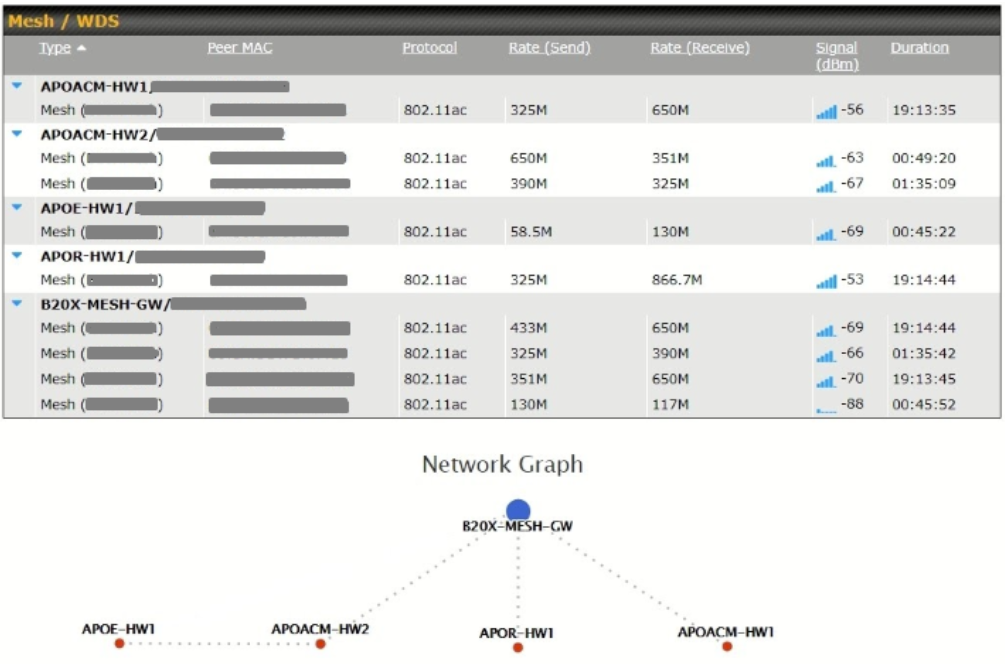
Nearby Device#
A listing of near devices can be accessed by navigating to AP > Controller Status > Nearby Device.
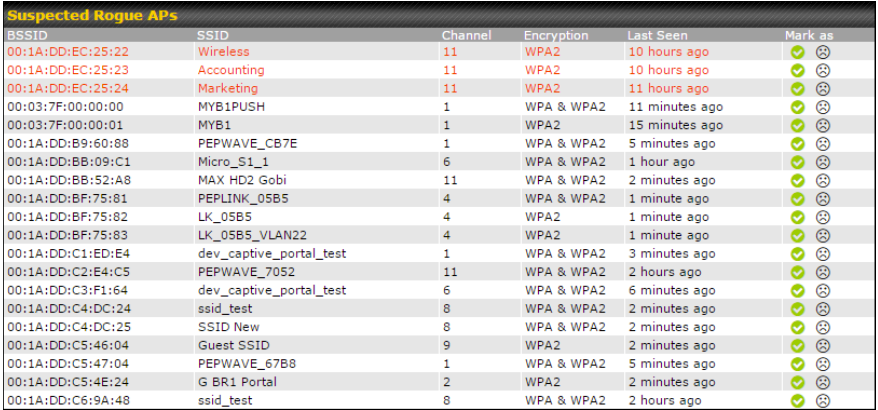
| Suspected Rogue Devices |
| Hovering over the device MAC address will result in a popup with information on how this device was detected. Click the |
Event Log#
You can access the AP Controller Event log by navigating to AP > Controller Status > Event Log.

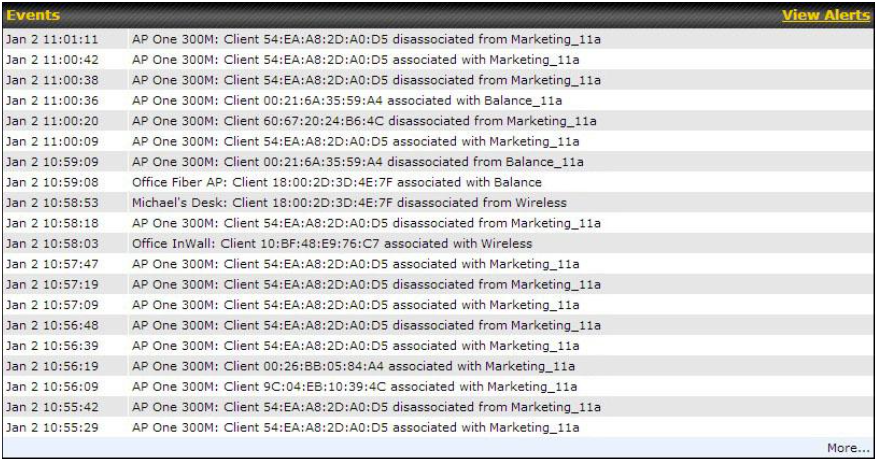
| Events |
| This event log displays all activity on your AP network, down to the client level. Use to filter box to search by MAC address, SSID, AP Serial Number, or AP Profile name. Click View Alerts to see only alerts, and click the More… link for additional records. |
Ch24. Toolbox#
Tools for managing firmware packs can be found at AP>Toolbox.

| Firmware Packs |
| Here, you can manage the firmware of your AP. Clicking on |
Ch25. Switch#
Switch Controller
Navigate to Switch Tab > Switch Controller > Controller.
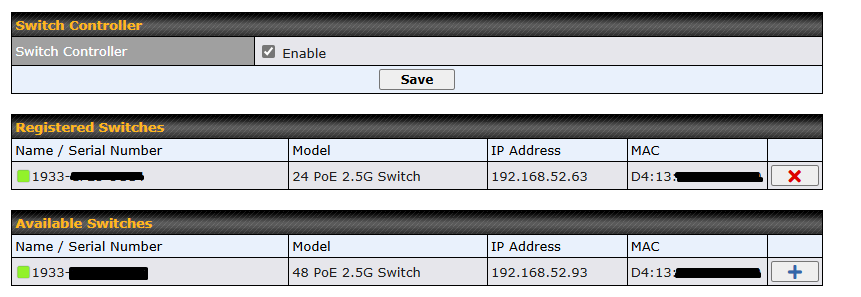
| Switch Controller | |
| Registered Switches | List of registered switches. Press “X” to remove the selected switch from the list. |
| Available Switches | List of available switches connected to the device. Press “+” to register the selected switch to the Registered Switches list. |
NOTE: PoE 2.5G Switch will only be managed by either InControl or Device switch controller. Do not enable the Switch Controller if the switch needs to be managed by InControl.
Admin Security
Navigate to Switch Tab > Switch Controller > Admin Security.
There are two types of user accounts available for accessing the Web Admin: admin and user. The admin login has full administrative access, while the user login is read-only. The user level can access only the device’s status information; users cannot make any changes on the device.
A web login session will be logged out automatically when it has been idle longer than the Web Session Timeout. Before the session expires, you may click the Logout button in the web admin to exit the session.
0 hours 0 minutes signifies an unlimited session time. This setting should be used only in special situations, as it will lower the system security level if users do not log out before closing the browser. The default is 4 hours, 0 minutes.
For security reasons, after logging in to the web admin Interface for the first time, it is recommended to change the administrator password. Configuring the administration interface to be accessible only from the LAN can further improve system security. Administrative settings configuration is located at System>Admin Security.
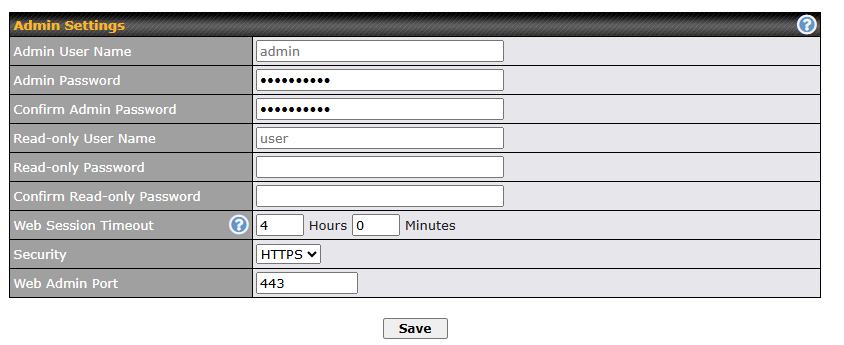
| Admin Settings | |
| Admin User Name | Admin User Name is set as admin by default, but can be changed, if desired. |
| Admin Password | This field allows you to specify a new administrator password. |
| Confirm Admin Password | This field allows you to verify and confirm the new administrator password. |
| Read-only User Name | Read-only User Name is set as user by default, but can be changed, if desired. |
| Read-only Password | This field allows you to specify a new user password. Once the user password is set, the read-only user feature will be enabled. |
| Confirm Read-only Password | This field allows you to verify and confirm the new user password. |
| Web Session Timeout | This field specifies the number of hours and minutes that a web session can remain idle before the Pepwave router terminates its access to the web admin interface. By default, it is set to 4 hours. |
| Security | This option is for specifying the protocol(s) through which the web admin interface can be accessed:
Default will be HTTPS. |
| Web Admin Port | This field is for specifying the port number on which the web admin interface can be accessed. |
Switch Information

| Switch Information | |
| Device | Drop down list to select Switch to be configured. |
| Name | Name of the switch.(not sure where to define) |
| Serial Number | Selected switch serial number. |
| Model | Selected switch model. |
| IP Address | Uplink IP address of the selected switch. |
| MAC Address | Selected switch MAC address. |
STP
Navigate to Switch Tab > STP.
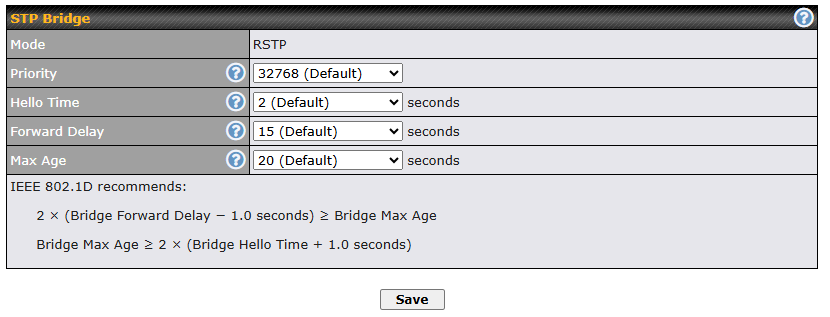
(A) – Advanced feature. Click the |
|||||||||||||
Switch Ports
Navigate to Switch Tab > Interfaces > Switch Ports.
For each port, you can set PoE scheduling, port type (Trunk and Access), as well as the VLAN which they belong to.

To configure port, you may click on the port icon or the pen icon from the Port Settings table to show the Port parameters.

| Port Settings | |
| Name | Set a name for the port |
| Enable checkbox | Enables / Disables the Port |
| PoE Enable checkbox | Enables / Disables PoE on the Port |
| Speed^ | Set the port speed to Auto, 10 Mbps half/full duplex or 100 Mbps half/full duplex, or 1GB full duplex. |
| Port Type | Set as Trunk or Access |
| VLAN Networks | Designate one or more VLANs to be used on this port. |
| PVID** | Untagged frames received by the port are classified to a VLAN indicated by Port VLAN Identifier (PVID). All frames from the VLAN are untagged on egress.** |
| RSTP checkbox | Enables or Disables Rapid Spanning Tree Protocol |
** PVID option is only configurable when Port Type is set to “Trunk”.
^ Configuration options on certain ports are configurable port speeds to 2.5 Gbps. May refer to the datasheet or label below switch ports.
^ Configurable options on SFP+ ports are similar as above, but configurable port speeds are between 100 Mbps Full Duplex up to 10 Gbps Full Duplex.
LACP (802.3ad) Configuration
LACP is part of the IEEE specification 802.3ad and allows you to bundle several physical ports to form a single logical channel.
Bundling multiple physical ports into a single logical link allows you to increase throughput beyond the limitations of a single connection and provides redundancy in case one link goes down.
Select multiple ports by clicking on them and selecting the Link Aggregation checkbox to enable link aggregation for the selected ports.
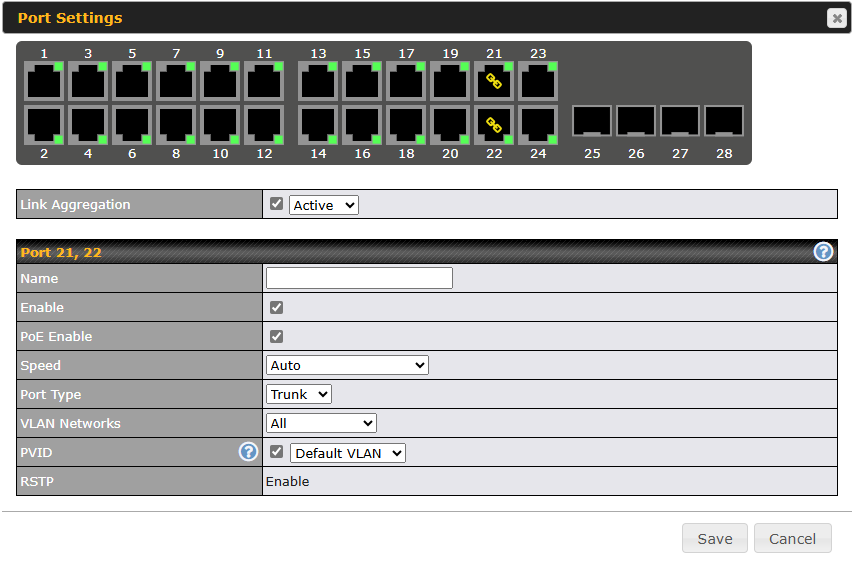
Ch26. System Settings#
Admin Security#
There are two types of user accounts available for accessing the web admin: admin and user. They represent two user levels: the admin level has full administrative access, while the user level is read-only. The user level can access only the device’s status information; users cannot make any changes on the device.
A web login session will be logged out automatically when it has been idle longer than the Web Session Timeout. Before the session expires, you may click the Logout button in the web admin to exit the session.
0 hours 0 minutes signifies an unlimited session time. This setting should be used only in special situations, as it will lower the system security level if users do not log out before closing the browser. The default is 4 hours, 0 minutes.
For security reasons, after logging in to the web admin Interface for the first time, it is recommended to change the administrator password. Configuring the administration interface to be accessible only from the LAN can further improve system security. Administrative settings configuration is located at System>Admin Security.
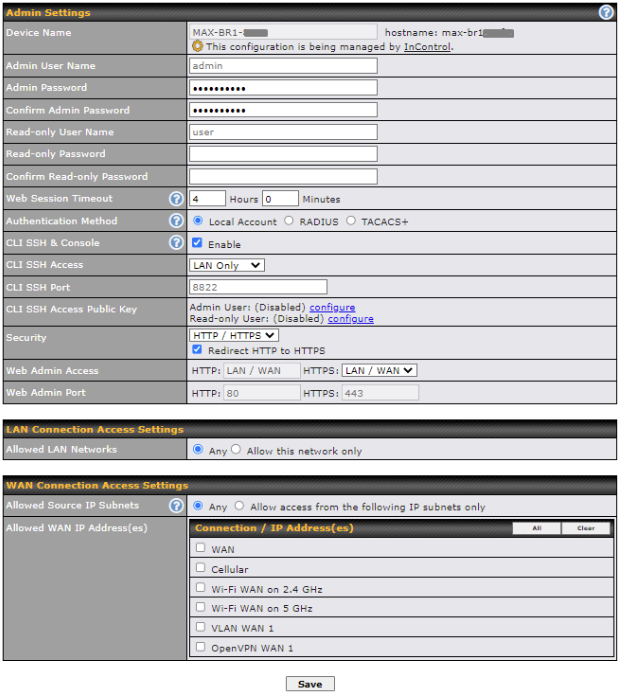
| Admin Settings | |||||||||||||||||||||||||
| Device Name | This field allows you to define a name for this Pepwave router. By default, Device Name is set as MAX_XXXX, where XXXX refers to the last 4 digits of the unit’s serial number. | ||||||||||||||||||||||||
| Admin User Name | Admin User Name is set as admin by default, but can be changed, if desired. | ||||||||||||||||||||||||
| Admin Password | This field allows you to specify a new administrator password. | ||||||||||||||||||||||||
| Confirm Admin Password | This field allows you to verify and confirm the new administrator password. | ||||||||||||||||||||||||
| Read-only User Name | Read-only User Name is set as user by default, but can be changed, if desired. | ||||||||||||||||||||||||
| Read-only Password | This field allows you to specify a new user password. Once the user password is set, the read-only user feature will be enabled. | ||||||||||||||||||||||||
| Confirm Read-only Password | This field allows you to verify and confirm the new user password. | ||||||||||||||||||||||||
| Web Session Timeout | This field specifies the number of hours and minutes that a web session can remain idle before the Pepwave router terminates its access to the web admin interface. By default, it is set to 4 hours. | ||||||||||||||||||||||||
| Authentication Method | With this box is checked, the web admin will authenticate using an external RADIUS server. Authenticated users are treated as either “admin” with full read-write permission or “user” with read-only access. Local admin and user accounts will be disabled. When the device is not able to communicate with the external RADIUS server, local accounts will be enabled again for emergency access. Additional authentication options will be available once this box is checked.
Available options:
|
||||||||||||||||||||||||
| CLI SSH & Console | The CLI (command line interface) can be accessed via SSH. This field enables CLI support. For additional information regarding CLI, please refer to Section 30.5. | ||||||||||||||||||||||||
| CLI SSH Access | This menu allows you to choose between granting access to LAN and WAN clients, or to LAN clients only. | ||||||||||||||||||||||||
| CLI SSH Port | This field determines the port on which clients can access CLI SSH. | ||||||||||||||||||||||||
| CLI SSH Access Public Key | This field is for entering the Public Key for Admin Users and Read-only Users to access CLI SSH. | ||||||||||||||||||||||||
| Security | This option is for specifying the protocol(s) through which the web admin interface can be accessed:
HTTP to HTTPS redirection is enabled by default to force HTTPS access to the web admin interface. |
||||||||||||||||||||||||
| Web Admin Access | This option is for specifying the network interfaces through which the web admin interface can be accessed:
If LAN/WAN is chosen, the WAN Connection Access Settings form will be displayed. |
||||||||||||||||||||||||
| Web Admin Port | This field is for specifying the port number on which the web admin interface can be accessed. | ||||||||||||||||||||||||
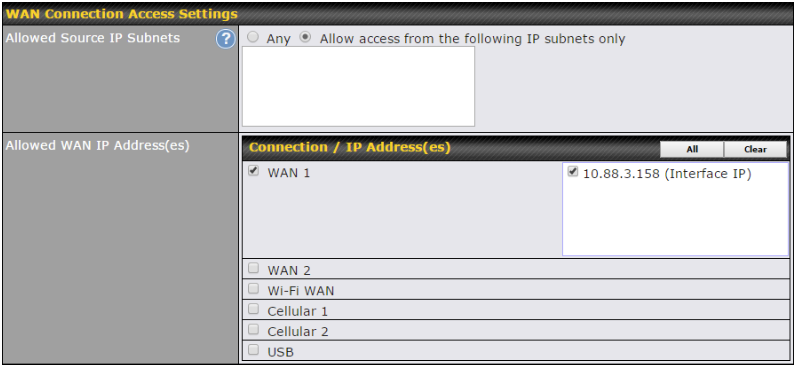
| WAN Connection Access Settings | |
| Allowed Source IP Subnets | This field allows you to restrict web admin access only from defined IP subnets.
The allowed IP subnet addresses should be entered into this text area. Each IP subnet must be in form of w.x.y.z/m, where w.x.y.z is an IP address (e.g., 192.168.0.0), and m is the subnet mask in CIDR format, which is between 0 and 32 inclusively (For example, 192.168.0.0/24). To define multiple subnets, separate each IP subnet one in a line. For example:
|
| Allowed WAN IP Address(es) | This is to choose which WAN IP address(es) the web server should listen on. |
Firmware#
Web admin interface : automatically check for updates
Upgrading firmware can be done in one of three ways.
Using the router’s interface to automatically check for an update, using the router’s interface to manually upgrade the firmware, or using InControl2 to push an upgrade to a router.
The automatic upgrade can be done from System > Firmware.

If an update is found the buttons will change to allow you to Download and Update the firmware.

Click on the Download and Upgrade button. A prompt will be displayed advising to download the Current Active Configuration. Please click on the underlined download text. After downloading the current config click the Ok button to start the upgrade process.
The router will download and then apply the firmware. The time that this process takes will depend on your internet connection’s speed.

The firmware will now be applied to the router*. The amount of time it takes for the firmware to upgrade will also depend on the router that’s being upgraded.

*Upgrading the firmware will cause the router to reboot.
Web admin interface : install updates manually
In some cases, a special build may be provided via a ticket or it may be found in the forum. Upgrading to the special build can be done using this method, or using IC2 if you are using that to manage your firmware upgrades. A manual upgrade using the GA firmware posted on the site may also be recommended or required for a couple of reasons.
All of the Peplink/Pepwave GA firmware can be found here Navigate to the relevant product line (ie. Balance, Max, FusionHub, SOHO, etc). Some product lines may have a dropdown that lists all of the products in that product line. Here is a screenshot from the Balance line.

If the device has more than one firmware version the current hardware revision will be required to know what firmware to download.
Navigate to System > Firmware and click the Choose File button under the Manual Firmware Upgrade section. Navigate to the location that the firmware was downloaded to select the “.img” file and click the Open button.
Click on the Manual Upgrade button to start the upgrade process.

A prompt will be displayed advising to download the Current Active Configuration. Please click on the underlined download text. After downloading the current config click the Ok button to start the upgrade process. The firmware will now be applied to the router*. The amount of time it takes for the firmware to upgrade will depend on the router that’s being upgraded.

*Upgrading the firmware will cause the router to reboot.
The InControl method
Described in this knowledgebase article on our forum.
Time#
Time Settings enables the system clock of the Pepwave router to be synchronized with a specified time server. Time settings are located at System>Time.

| Time Settings | |
| Time Zone | This specifies the time zone (along with the corresponding Daylight Savings Time scheme). The Time Zone value affects the time stamps in the Pepwave router’s event log and e-mail notifications. Check Show all to show all time zone options. |
| Time Sync | This field allows to select your time sync mode, the available options are:
|
| Time Server | This setting specifies the NTP network time server to be utilized by the Pepwave router. |
Schedule#
Enable and disable different functions (such as WAN connections, outbound policy, and firewalls at different times, based on a user-scheduled configuration profile. The settings for this are located at System > Schedule

Enable scheduling, and then click on your schedule name or on the New Schedule button to begin.
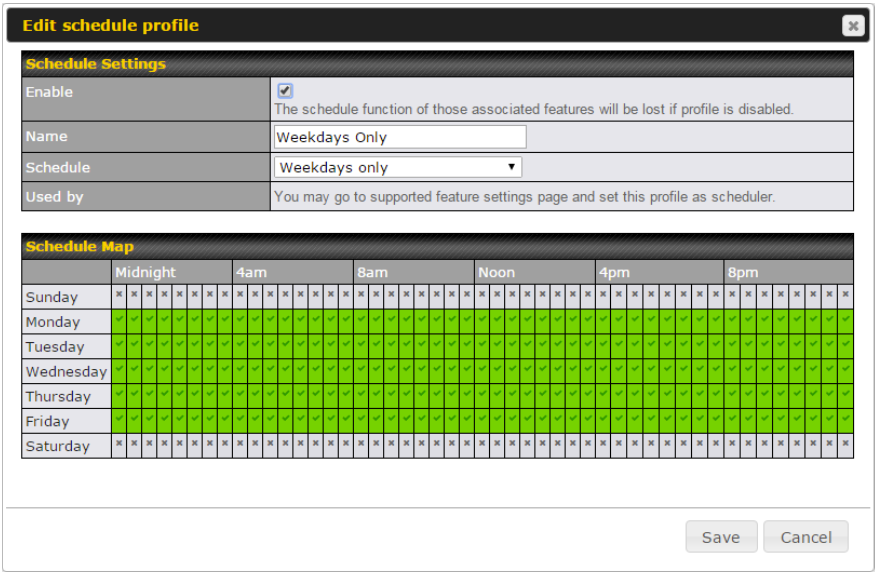
| Edit Schedule Profile | |
| Enabling | Click this checkbox to enable this schedule profile. Note that if this is disabled, then any associated features will also have their scheduling disabled. |
| Name | Enter your desired name for this particular schedule profile. |
| Schedule | Click the drop-down menu to choose pre-defined schedules as your starting point. Please note that upon selection, previous changes on the schedule map will be deleted. |
| Schedule Map | Click on the desired times to enable features at that time period. You can hold your mouse for faster entry. |
Email Notification#
Email notification functionality provides a system administrator with up-to-date information on network status. The settings for configuring email notifications are found at System>Email Notification.
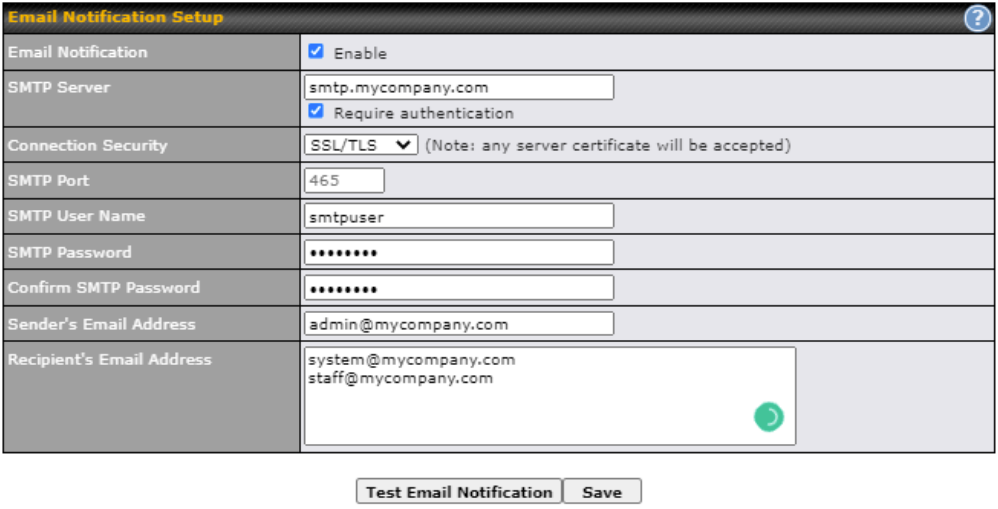
| Email Notification Settings | |
| Email Notification | This setting specifies whether or not to enable email notification. If Enable is checked, the Pepwave router will send email messages to system administrators when the WAN status changes or when new firmware is available. If Enable is not checked, email notification is disabled and the Pepwave router will not send email messages. |
| SMTP Server | This setting specifies the SMTP server to be used for sending email. If the server requires authentication, check Require authentication. |
| Connection Security | This setting specifies via a drop-down menu one of the following valid Connection Security:
|
| SMTP Port | This field is for specifying the SMTP port number. By default, this is set to 25. If Connection Security is selected “STARTTLS”, the default port number will be set to 587. If Connection Security is selected “SSL/TLS”, the default port number will be set to 465.
You may customize the port number by editing this field. |
| SMTP User Name / Password | This setting specifies the SMTP username and password while sending email. These options are shown only if Require authentication is checked in the SMTP Server setting. |
| Confirm SMTP Password | This field allows you to verify and confirm the new administrator password. |
| Sender’s Email Address | This setting specifies the email address the Pepwave router will use to send reports. |
| Recipient’s Email Address | This setting specifies the email address(es) to which the Pepwave router will send email notifications. For multiple recipients, separate each email addresses using the enter key. |
After you have finished setting up email notifications, you can click the Test Email Notification button to test the settings before saving. After Test Email Notification is clicked, you will see this screen to confirm the settings:

Click Send Test Notification to confirm. In a few seconds, you will see a message with detailed test results.
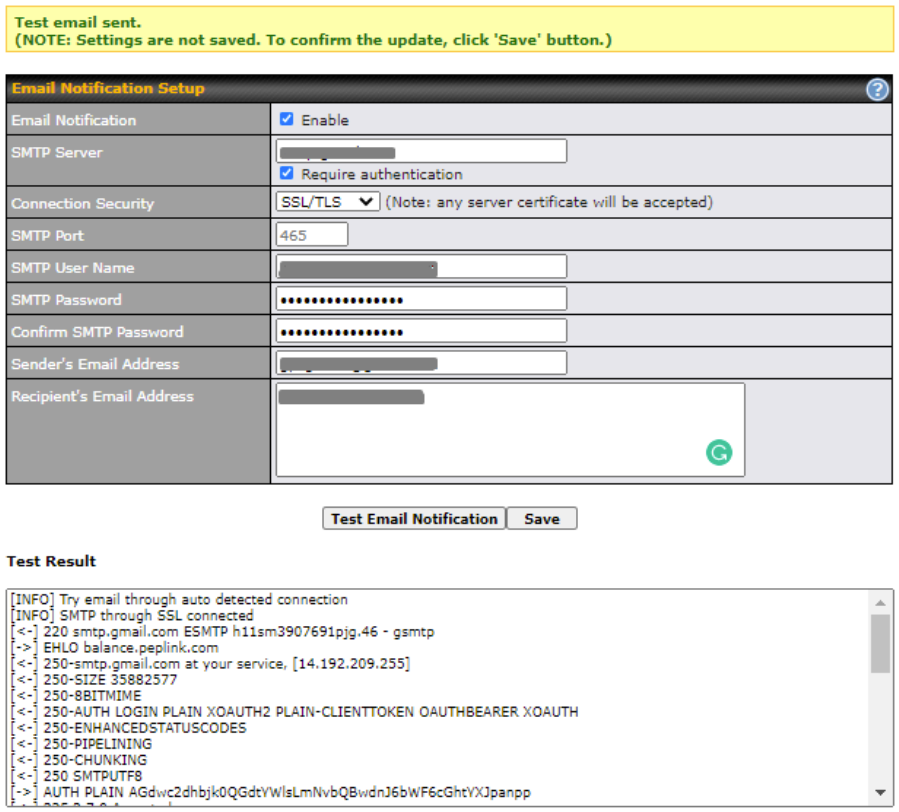
Event Log#
Event log functionality enables event logging at a specified remote syslog server. The settings for configuring the remote system log can be found at System > Event Log.

| Event Log Settings | |
| Remote Syslog | This setting specifies whether or not to log events at the specified remote syslog server. |
| Remote Syslog Host | This setting specifies the IP address or hostname of the remote syslog server. |
| Push Events | The Pepwave router can also send push notifications to mobile devices that have our Mobile Router Utility installed. Check the box to activate this feature. |
| URL Logging | This setting is to enable event logging at the specified log server. |
| URL Logging Host | This setting specifies the IP address or hostname of the URL log server. |
| Session Logging | This setting is to enable event logging at the specified log server. |
| Session Logging Host | This setting specifies the IP address or hostname of the Session log server. |
 |
For more information on the Router Utility, go to: www.peplink.com/products/router-utility |
SNMP#
SNMP or simple network management protocol is an open standard that can be used to collect information about the Pepwave router. SNMP configuration is located at System>SNMP.
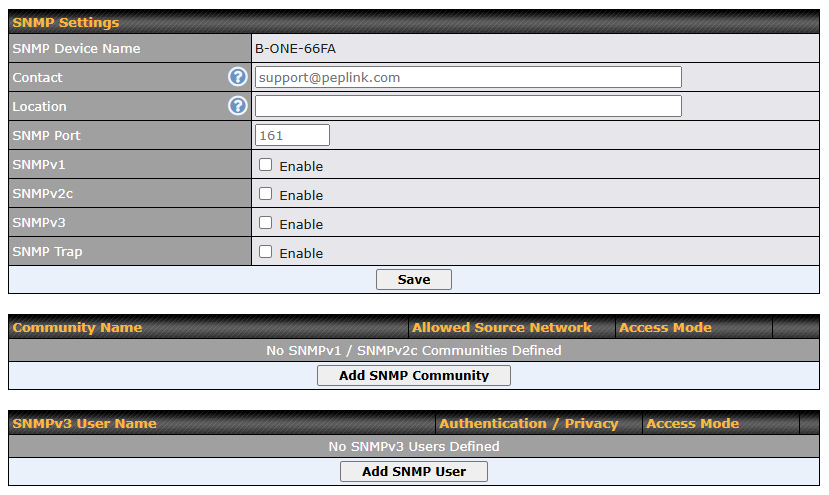
| SNMP Settings | |
| SNMP Device Name | This field shows the router name defined at System>Admin Security. |
| Contact | This field to input sysContact. The default contact is [email protected] |
| Location | This field to input sysLocation. |
| SNMP Port | This option specifies the port which SNMP will use. The default port is 161. |
| SNMPv1 | This option allows you to enable SNMP version 1. |
| SNMPv2 | This option allows you to enable SNMP version 2. |
| SNMPv3 | This option allows you to enable SNMP version 3. |
| SNMP Trap | This option allows you to enable SNMP Trap. If enabled, the following entry fields will appear. |
| SNMP Trap Community | This setting specifies the SNMP Trap community name. |
| SNMP Trap Server | Enter the IP address of the SNMP Trap server |
| SNMP Trap Port | This option specifies the port which the SNMP Trap server will use. The default port is 162. |
| SNMP Trap Server Heartbeat | This option allows you to enable and configure the heartbeat interval for the SNMP Trap server. |
To add a community for either SNMPv1 or SNMPv2, click the Add SNMP Community button in the Community Name table, upon which the following screen is displayed:

| SNMP Community Settings | |
| Community Name | This setting specifies the SNMP community name. |
| Allowed Source Subnet Address | This setting specifies a subnet from which access to the SNMP server is allowed. Enter subnet address here (e.g., 192.168.1.0) and select the appropriate subnet mask. |
To define a user name for SNMPv3, click Add SNMP User in the SNMPv3 User Name table, upon which the following screen is displayed:

| SNMPv3 User Settings | |
| User Name | This setting specifies a user name to be used in SNMPv3. |
| Authentication Protocol | This setting specifies via a drop-down menu one of the following valid authentication protocols:
When MD5 or SHA is selected, an entry field will appear for the password. |
| Privacy Protocol | This setting specifies via a drop-down menu one of the following valid privacy protocols:
When DES is selected, an entry field will appear for the password. |
SMS Control#
SMS Control allows the user to control the device using SMS even if the modem does not have a data connection. The settings for configuring the SMS Control can be found at System>SMS Control.
Supported Models
- Balance/MAX: *-LTE-E, *-LTEA-W, *-LTEA-P, *-LTE-MX
- EPX: *-LW*, *-LP*

When this box is checked, the device will be allowed to take actions according to received commands via SMS.
Make sure your mobile plan supports SMS, and note that some plans may incur additional charges for this.
SMS Control can reboot devices and configure cellular settings over signalling channels, even if the modem does not have a data connection.
For details of supported SMS command sets, please refer to our knowledge base.

| SMS Control Settings | |
| Enable | Click the checkbox to enable the SMS Control. |
| Password | This setting sets the password for authentication – maximum of 32 characters, which cannot include semicolon (;). |
| White List | Optionally, you can add phone number(s) to the whitelist. Only matching phone numbers are allowed to issue SMS commands. Phone numbers must be in the E.164 International Phone Numbers format. |
InControl#

InControl is a cloud-based service which allows you to manage all of your Peplink and Pepwave devices with one unified system. With it, you can generate reports, gather statistics, and configure your devices automatically. All of this is now possible with InControl.
When this check box is checked, the device’s status information will be sent to the Peplink InControl system. This device’s usage data and configuration will be sent to the system if you enable the features in the system.
Alternatively, you can also privately host InControl. Simply check the “Privately Host InControl” box and enter the IP Address of your InControl Host. If you have multiple hosts, you may enter the primary and backup IP addresses for the InControl Host and tick the “Fail over to InControl in the cloud” box. The device will connect to either the primary InControl Host or the secondary/backup ICA/IC2.
You can sign up for an InControl account at https://incontrol2.peplink.com/. You can register your devices under the account, monitor their status, see their usage reports, and receive offline notifications.
Configuration#
Backing up Pepwave router settings immediately after successful completion of initial setup is strongly recommended. The functionality to download and upload Pepwave router settings is found at System>Configuration. Note that available options vary by model.
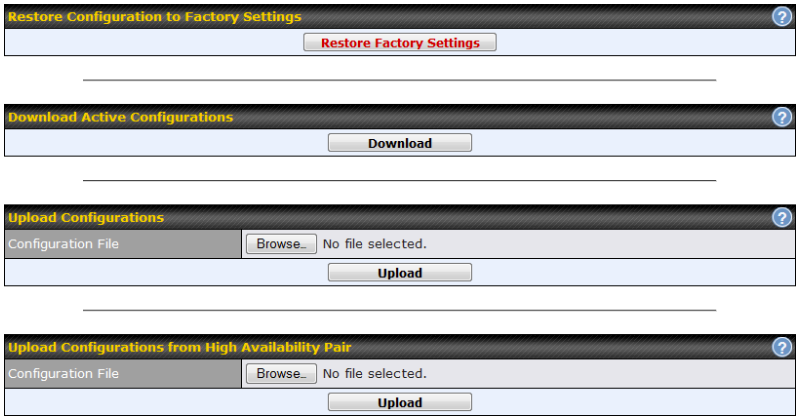
| Configuration | |
| Restore Configuration to Factory Settings | The Restore Factory Settings button is to reset the configuration to factory default settings. After clicking the button, you will need to click the Apply Changes button on the top right corner to make the settings effective. |
| Download Active Configurations | Click Download to backup the current active settings. |
| Upload Configurations | To restore or change settings based on a configuration file, click Choose File to locate the configuration file on the local computer, and then click Upload. The new settings can then be applied by clicking the Apply Changes button on the page header, or you can cancel the procedure by pressing discard on the main page of the web admin interface. |
| Upload Configurations from High Availability Pair | In a high availability (HA) configuration, a Pepwave router can quickly load the configuration of its HA counterpart. To do so, click the Upload button. After loading the settings, configure the LAN IP address of the Pepwave router so that it is different from the HA counterpart. |
Feature Add-ons#
Some Pepwave routers have features that can be activated upon purchase. Once the purchase is complete, you will receive an activation key. Enter the key in the Activation Key field, click Activate, and then click Apply Changes.

Reboot#
This page provides a reboot button for restarting the system. For maximum reliability, the Pepwave router can equip with two copies of firmware. Each copy can be a different version. You can select the firmware version you would like to reboot the device with. The firmware marked with (Running) is the current system boot up firmware.
Please note that a firmware upgrade will always replace the inactive firmware partition.

Ch27. Tools#
Ping#
The ping test tool sends pings through a specific Ethernet interface or a SpeedFusionTM VPN connection. You can specify the number of pings in the field Number of times, to a maximum number of 10 times. Packet Size can be set to a maximum of 1472 bytes. The ping utility is located at System>Tools>Ping, illustrated below:
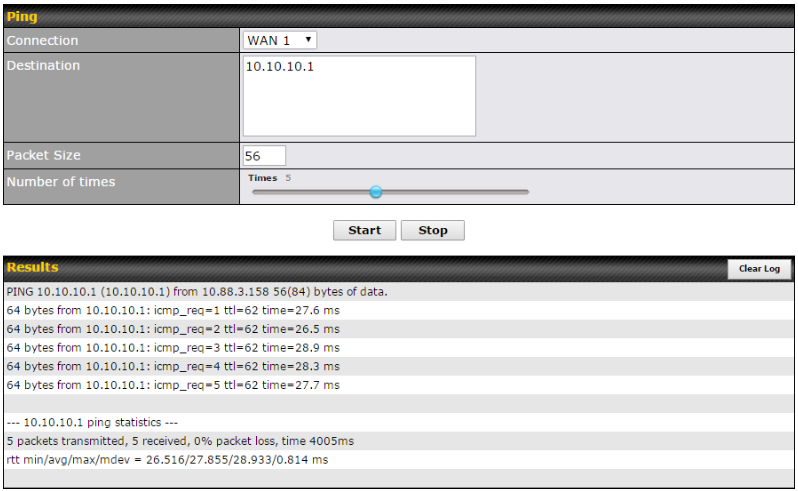
| Tip |
| A system administrator can use the ping utility to manually check the connectivity of a particular LAN/WAN connection. |
Traceroute Test#
The traceroute test tool traces the routing path to the destination through a particular Ethernet interface or a SpeedFusionTM connection. The traceroute test utility is located at System>Tools>Traceroute.
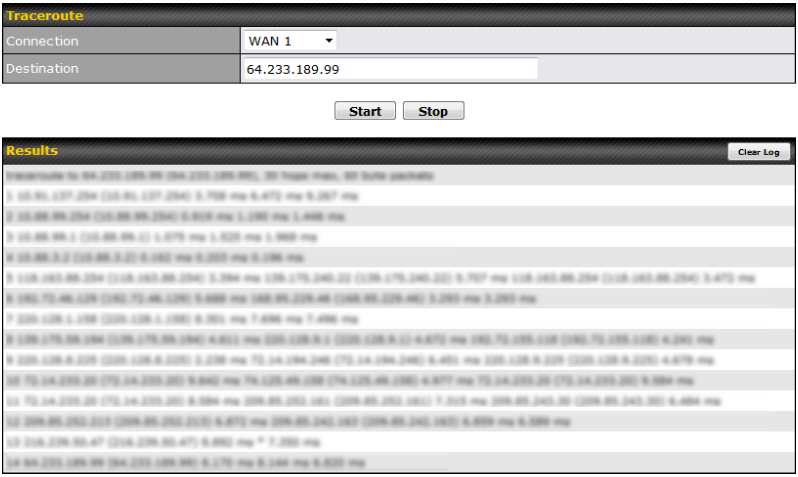
| Tip |
| A system administrator can use the traceroute utility to analyze the connection path of a LAN/WAN connection. |
Wake-on-LAN#
Peplink routers can send special “magic packets” to any client specified from the Web UI. To access this feature, navigate to System > Tools > Wake-on-LAN

Select a client from the drop-down list and click Send to send a “magic packet”
WAN Analysis#
The WAN Analysis feature allows you to run a WAN to WAN speed test between 2 Peplink devices .
You can set a device up as a Server or a Client. One device must be set up as a server to run the speed tests and the server must have a public IP address.
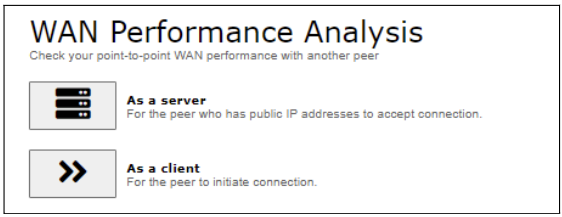
The default port is 6000 and can be changed if required. The IP address of the WAN interface will be shown in the WAN Connection Status section.

The client side has a few more settings that can be changed. Make sure that the Control Port matches what’s been entered on the server side. Select the WAN(s) that will be used for testing and enter the Servers WAN IP address. Once all of the options have been set, click the Start Test button.
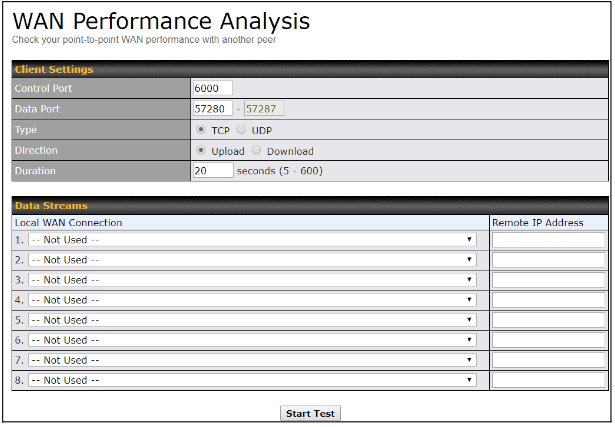
The test output will show the Data Streams Parameters, the Throughput as a graph, and the Results.
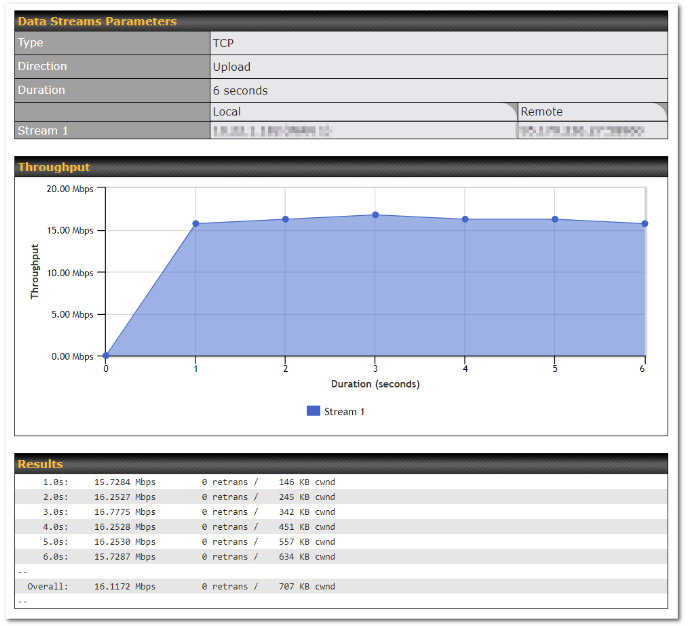
The test can be run again once it’s complete by clicking the Start button or you can click Close and change the parameters for the test.
CLI (Command Line Interface Support)#
The CLI (command line interface) can be accessed via SSH. This field enables CLI support. The below settings specify which TCP port and which interface(s) should accept remote SSH CLI access. The user name and password used for remote SSH CLI access are the same as those used for web admin access.
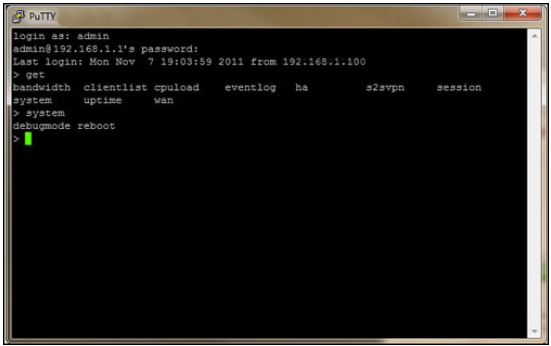
Ch28. Status#
Device#
System information is located at Status>Device.
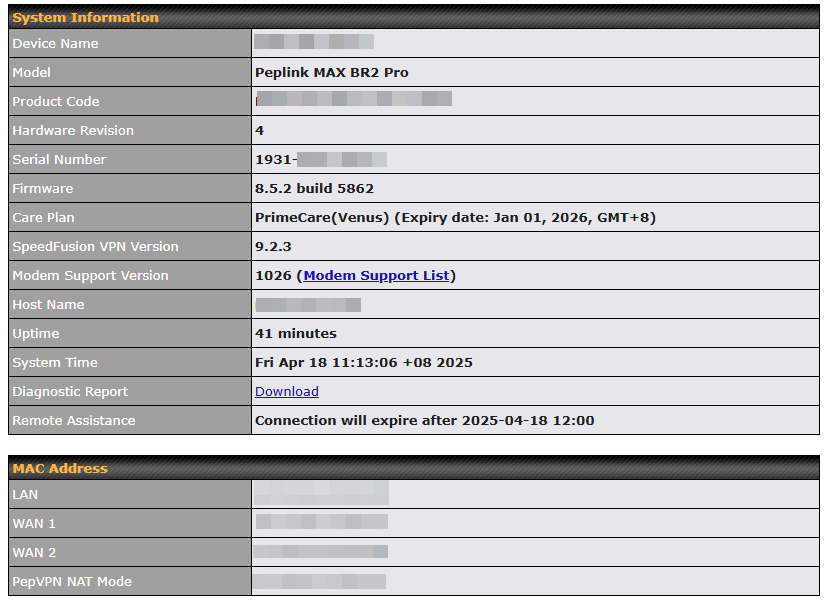
| System Information | |
| Device Name | This is the name specified in the Device Name field located at System > Admin Security. |
| Model | This shows the model name and number of this device. |
| Product Code | If your model uses a product code, it will appear here. |
| Hardware Revision | This shows the hardware version of this device. |
| Serial Number | This shows the serial number of this device. |
| Firmware | This shows the firmware version this device is currently running. |
| Care Plan | Display care plan status and expiry date. |
| SpeedFusion VPN Version | This shows the current SpeedFusion VPN version. |
| Modem Support Version | This shows the modem support version. For a list of supported modems, click Modem Support List. |
| InControl Managed Configuration | InControl Managed Configurations (firmware, VLAN, Captive Portal, etcetera) |
| Host Name | The host name assigned to the Peplink router appears here. |
| Uptime | This shows the length of time since the device has been rebooted. |
| System Time | This shows the current system time. |
| OpenVPN Client Profile | Link to download OpenVpn Client profile when this is enabled in Remote User Access |
| Diagnostic Report | The Download link is for exporting a diagnostic report file required for system investigation. |
| Remote Assistance | This option is to Turn on remote assistance with the time duration. |
The second table shows the MAC address of each LAN/WAN interface connected. To view your device’s End User License Agreement (EULA), click ![]() Legal.
Legal.
Active Sessions#
Information on active sessions can be found at Status > Active Sessions > Overview.
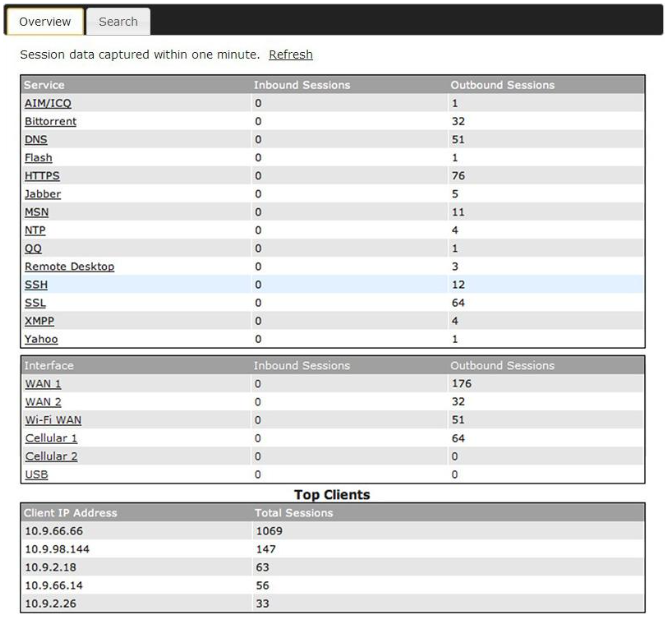
This screen displays the number of sessions initiated by each application. Click on each service listing for additional information. This screen also indicates the number of sessions initiated by each WAN port. In addition, you can see which clients are initiating the most sessions.
You can also perform a filtered search for specific sessions. You can filter by subnet, port, protocol, and interface. To perform a search, navigate to Status > Active Sessions > Search.
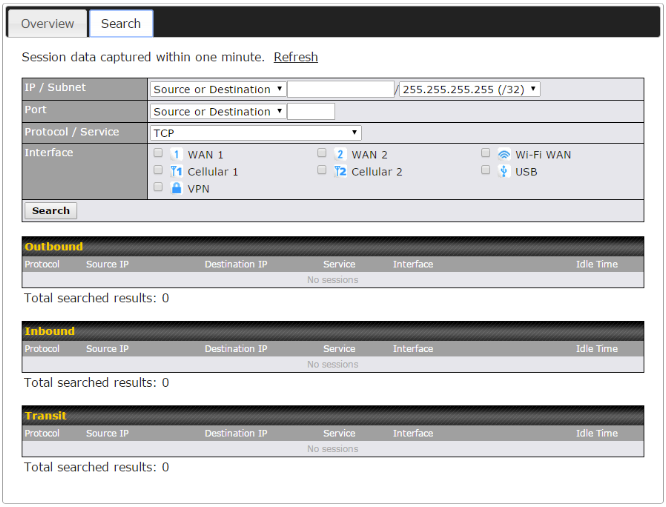
This Active Sessions section displays the active inbound/outbound sessions of each WAN connection on the Pepwave router. A filter is available to sort active session information. Enter a keyword in the field or check one of the WAN connection boxes for filtering.
Client List#
The client list table is located at Status > Client List. It lists DHCP and online client IP addresses, names (retrieved from the DHCP reservation table or defined by users), current download and upload rate, and MAC address.
Clients can be imported into the DHCP reservation table by clicking the ![]() button on the right. You can update the record after import by going to Network > LAN.
button on the right. You can update the record after import by going to Network > LAN.

If the PPTP server (see Section 19.2), SpeedFusionTM (see Section 12.1), or AP controller (see Section 20) is enabled, you may see the corresponding connection name listed in the Name field.
In the client list table, there is a “Ban Client” feature which is used to disconnect the Wi-Fi and Remote User Access clients by clicking the ![]() button on the right.
button on the right.

There is a blocklist on the same page after you banned the Wi-Fi or Remote User Access clients.

You may also unblock the Wi-Fi or Remote User Access clients when the client devices need to reconnect the network by clicking the ![]() button on the right.
button on the right.

UPnP / NAT-PMP#
The table that shows the forwarded ports under UPnP and NAT-PMP protocols is located at Status>UPnP/NAT-PMP. This section appears only if you have enabled UPnP / NAT-PMP as mentioned in Section 16.1.1.
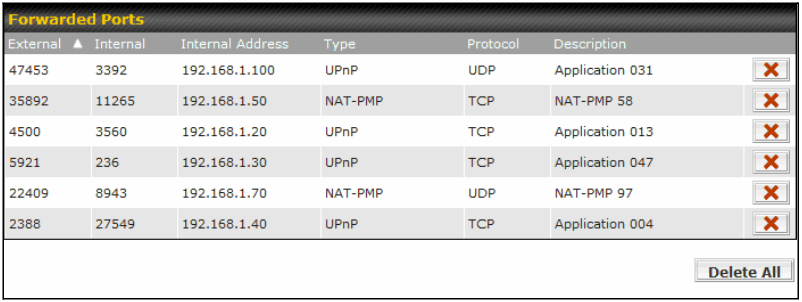
Click ![]() to delete a single UPnP / NAT-PMP record in its corresponding row. To delete all records, click Delete All on the right-hand side below the table.
to delete a single UPnP / NAT-PMP record in its corresponding row. To delete all records, click Delete All on the right-hand side below the table.
| Important Note |
| UPnP / NAT-PMP records will be deleted immediately after clicking the |
OSPF & RIPv2#
Shows status of OSPF and RIPv2

BGP#
Shows status of BGP

SpeedFusion VPN#
Current SpeedFusion VPN status information is located at Status > SpeedFusion VPN.
Details about SpeedFusion VPN connection peers appear below:

Click on the corresponding peer name to explore the WAN connection(s) status and subnet information of each VPN peer.
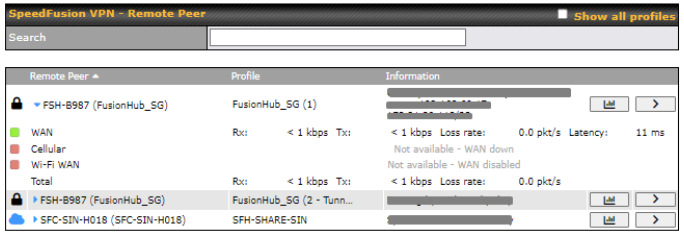
Click the ![]() button for a SpeedFusion chart displaying real-time throughput, latency, and drop-rate information for each WAN connection.
button for a SpeedFusion chart displaying real-time throughput, latency, and drop-rate information for each WAN connection.
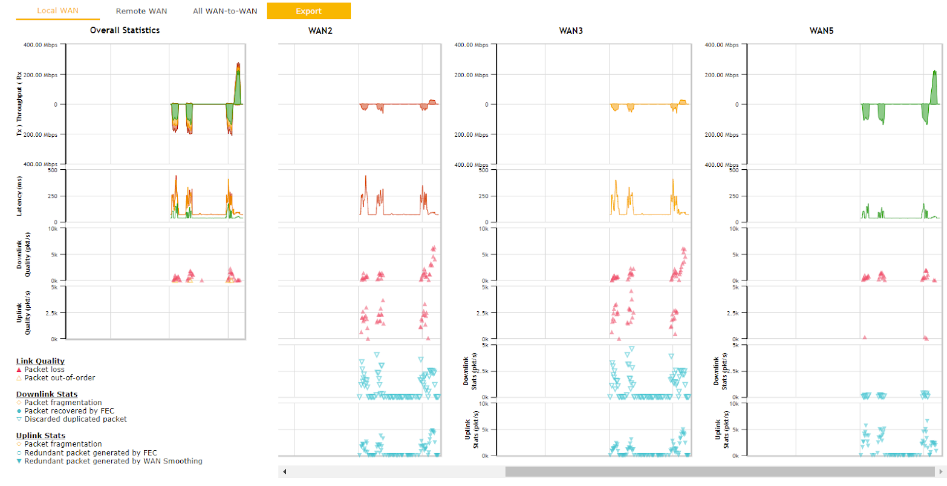
When pressing the ![]() button, the following menu will appear:
button, the following menu will appear:
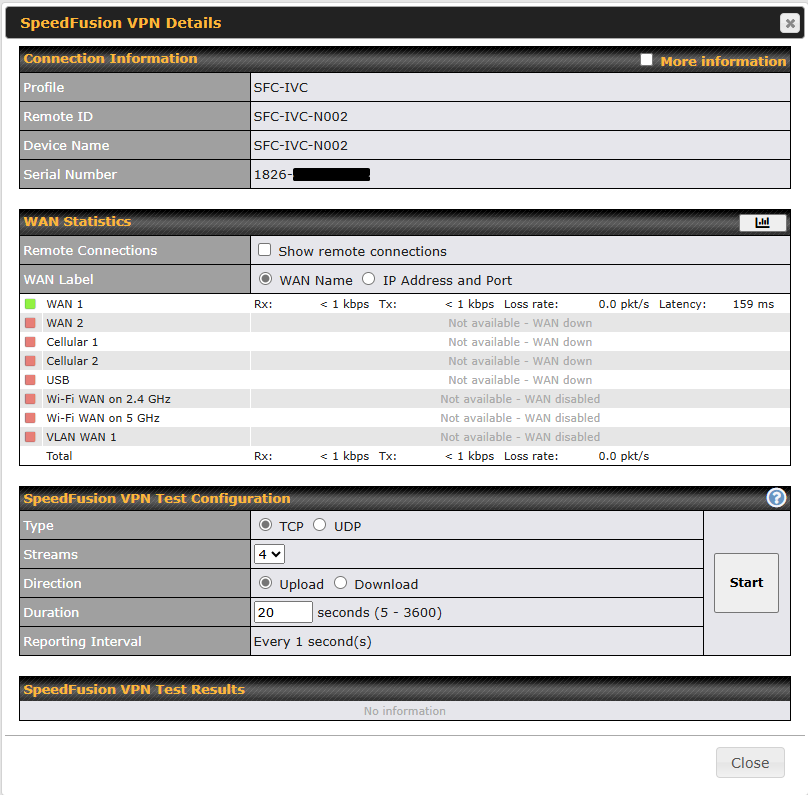
The connection information shows the details of the selected SpeedFusion VPN profile, consisting of the Profile name, Router ID, Router Name, and Serial Number of the remote router.
Advanced features for the SpeedFusion VPN profile will also be shown when the More Information checkbox is selected.
The WAN statistics show information about the local and remote WAN connections (when showing Remote connections) is selected.
The available details are the WAN Name, IP address, and port used for the Speedfusion connection. Rx and Tx rates, Loss rate and, Latency.
Connections can be temporarily disabled by sliding the switch button next to a WAN connection to the left.
The wan-to-wan connection disabled by the switch is temporary and will be re-enabled after 15 minutes without any action.
This can be used when testing the SpeedFusion VPN’s speed between two locations to see if there is interference or network congestion between certain WAN connections.

The SpeedFusion VPN test configuration allows us to configure and perform thorough testing.
This is usually done after the initial installation of the routers and when there are aggregation issues.

Press the Start button to perform the throughput test according to the configured options.
If TCP is selected, 4 parallel streams will be generated by default to obtain optimal results. This can be customized by selecting a different value of streams.
Duration can be set from a minimum of 5 seconds to a maximum of 3600 seconds. The reporting interval will increase based on the entered duration.
| Duration (seconds) | Reporting Interval (seconds) |
| 5 – 600 | 1 |
| 601 – 1200 | 2 |
| 1201 – 2400 | 5 |
| 2401 – 3600 | 10 |
Using more streams will usually give better results if the latency of the tunnel is high.
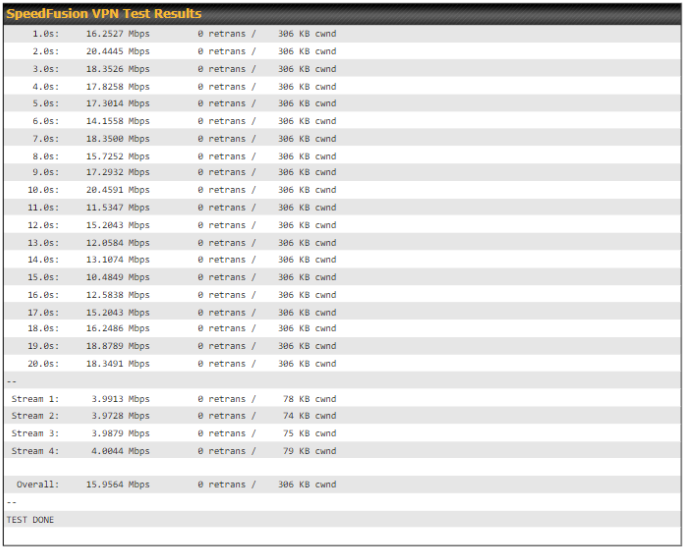
Peplink has also published a white paper on Speedfusion, which can be downloaded from the following URL:
http://download.peplink.com/resources/whitepaper-speedfusion-and-best-practices-2019.pdf
Event Log#
Event log information is located at Status > Event Log.
Device Event Log#
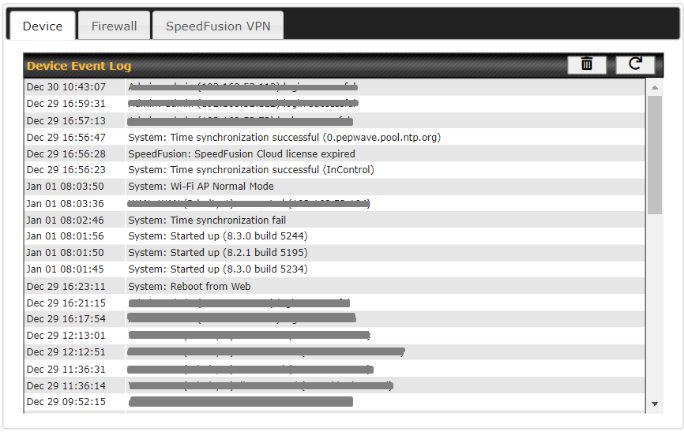
The log section displays a list of events that has taken place on the Pepwave router. Click the ![]() to refresh log entries automatically. Click the
to refresh log entries automatically. Click the ![]() button to clear the log.
button to clear the log.
Firewall Event log#
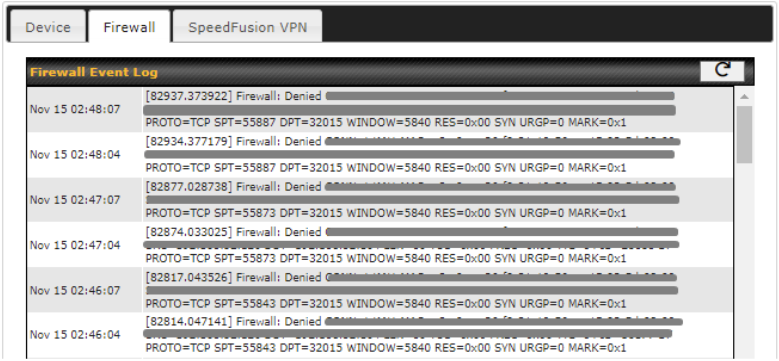
This section displays a list of events that have taken place within a firewall. Click the ![]() button and the log will be refreshed.
button and the log will be refreshed.
SpeedFusion VPN Event log#
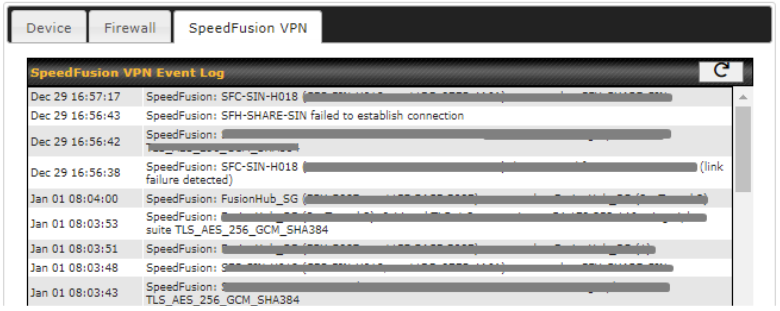
This section displays a list of events that have taken place within a SpeedFusion VPN connection. Click the ![]() button and the log will be refreshed.
button and the log will be refreshed.
Ch29. WAN Quality#
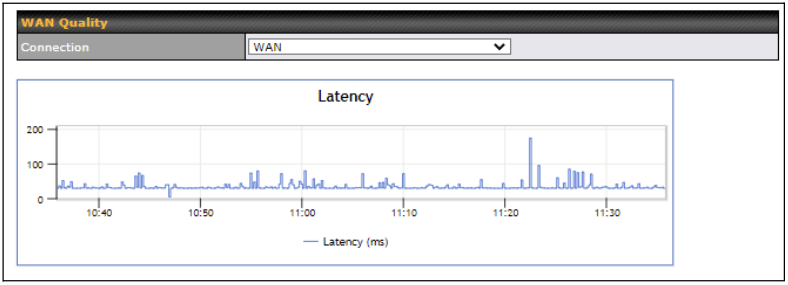
The Status > WAN Quality allow to show detailed information about each connected WAN connection.
For cellular connections it shows signal strength, quality, throughput and latency for the past hour.
Ch30. Usage Reports#
This section shows bandwidth usage statistics and is located at Status > Usage Reports
Bandwidth usage at the LAN while the device is switched off (e.g., LAN bypass) is neither recorded nor shown.
Real-Time#
The Data transferred since installation table indicates how much network traffic has been processed by the device since the first bootup. The Data transferred since last reboot table indicates how much network traffic has been processed by the device since the last bootup.
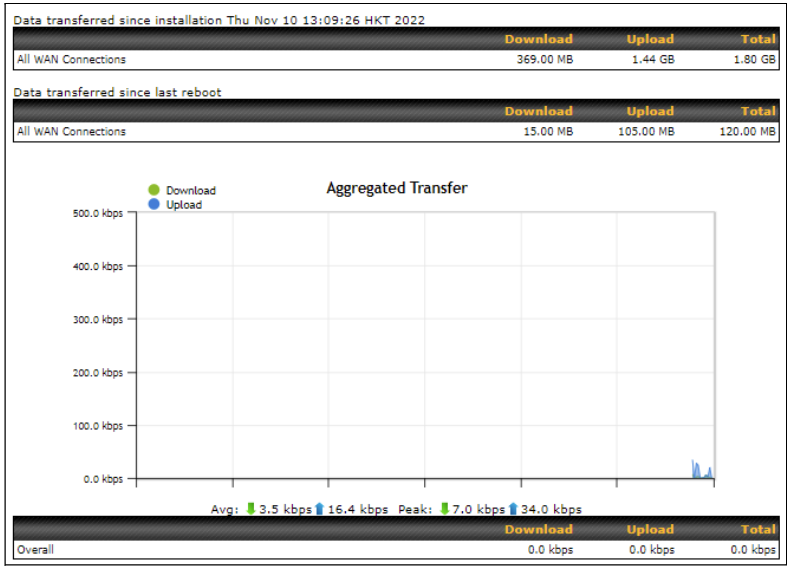
Hourly#
This page shows the hourly bandwidth usage for all WAN connections, with the option of viewing each individual connection. Select the desired connection to check from the drop-down menu.
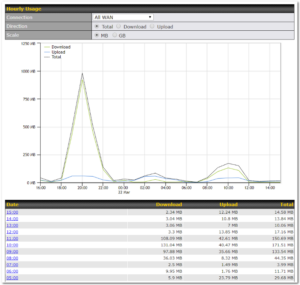
Daily#
This page shows the daily bandwidth usage for all WAN connections, with the option of viewing each individual connection.
Select the connection to check from the drop-down menu. If you have enabled the Bandwidth Monitoring feature, the Current Billing Cycle table for that WAN connection will be displayed.
Click on a date to view the client bandwidth usage of that specific date. This feature is not available if you have selected to view the bandwidth usage of only a particular WAN connection. The scale of the graph can be set to display megabytes (MB) or gigabytes (GB).
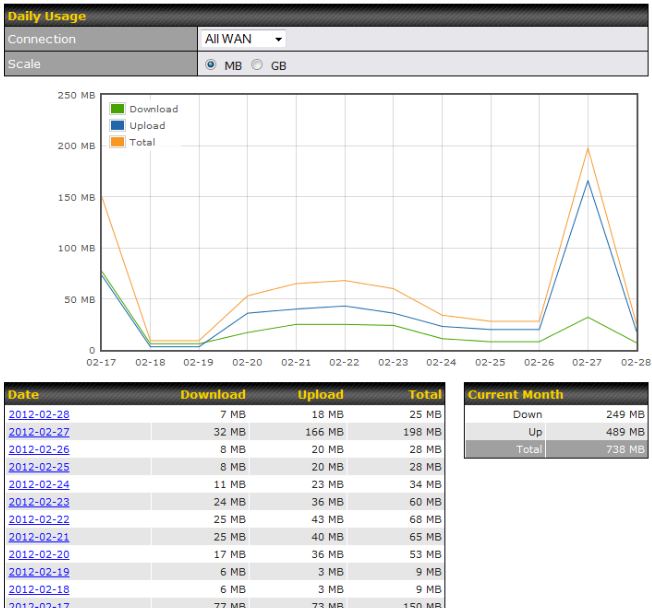
All WAN Daily Bandwidth Usage
Monthly#
This page shows the monthly bandwidth usage for each WAN connection. If you have enabled the Bandwidth Monitoring feature, you can check the usage of each particular connection and view the information by Billing Cycle or by Calendar Month.
Click the first two rows to view the client bandwidth usage in the last two months. This feature is not available if you have chosen to view the bandwidth of an individual WAN connection. The scale of the graph can be set to display megabytes (MB) or gigabytes (GB).

All WAN Monthly Bandwidth Usage
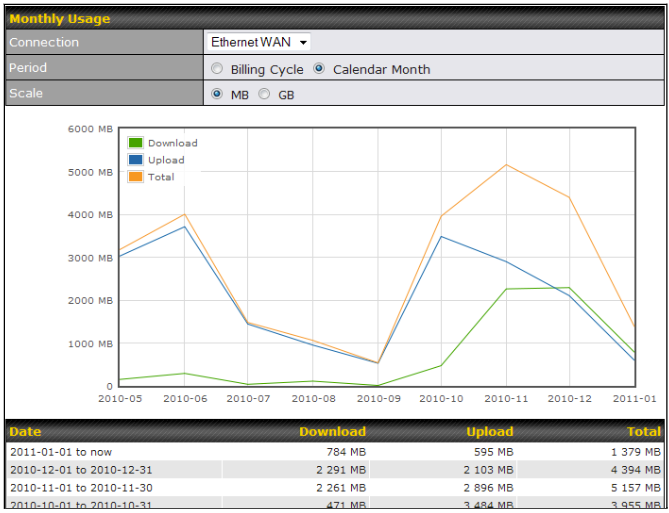
Ethernet WAN Monthly Bandwidth Usage
| Tip |
| By default, the scale of data size is in MB. 1GB equals 1024MB. |
Appendix List#
Appendix A. Restoration of Factory Defaults
Appendix B. Overview of ports used by Peplink SD-WAN routers and other Peplink services
Appendix A. Restoration of Factory Defaults#
Restoration of Factory Defaults
To restore the factory default settings on a Pepwave router, follow the steps below:
- Locate the reset button on the front or back panel of the Pepwave router.
- With a paperclip, press and keep the reset button pressed.
Hold for approximately 10 seconds for factory reset (Note: The LED status light shows in RED, until the status light off and release the button).
After the Pepwave router finishes rebooting, the factory default settings will be restored.
| Important Note |
| All previous configurations and bandwidth usage data will be lost after restoring factory default settings. Regular backup of configuration settings is strongly recommended. |
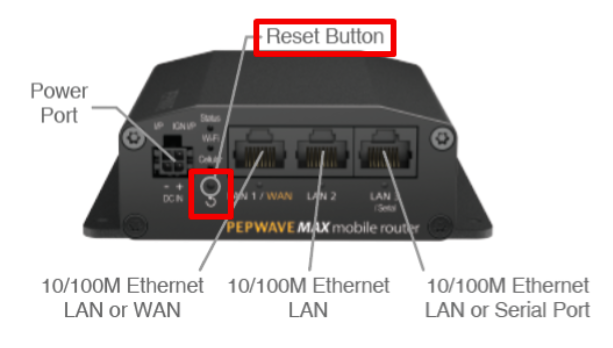
Appendix B. Overview of ports used by Peplink SD-WAN routers and other Peplink services#
Overview of ports used by Peplink SD-WAN routers and other Peplink services
| Default Port Number | Usage | Service | Inbound/Outbound | Default Status |
| UDP 5246 | Data flow | InControl | Outbound | Enabled |
| TCP 443 | HTTPS service | InControl | Outbound | Enabled |
| TCP 5246 | Optional, used when TCP 443 is not responding | InControl | Outbound | Enabled |
| TCP 5246 | Remote Web Admin | InControl Virtual Appliance | Outbound | Enabled |
| TCP 4500 | VPN Data (TCP Mode) | SpeedFusion VPN / SpeedFusion | Inbound / Outbound* | Disabled |
| TCP 32015 | VPN handshake | SpeedFusion VPN / SpeedFusion | Inbound / Outbound* | Disabled |
| UDP 4500 | VPN Data | SpeedFusion VPN / SpeedFusion | Inbound / Outbound* | Disabled |
| UDP 32015º | VPN Data (alternative) | SpeedFusion VPN / SpeedFusion | Inbound / Outbound* | Disabled |
| TCP/UDP 4500+N-1^ | VPN Sub-Tunnels Data | SpeedFusion VPN / SpeedFusion | Inbound / Outbound* | Disabled |
| UDP 32015+N-1^ | VPN Sub-Tunnels Data (alternative) | SpeedFusion VPN / SpeedFusion | Inbound / Outbound* | Disabled |
| UDP 4500 | VPN Data | IPsec | Inbound / Outbound* | Disabled |
| UDP 500 | VPN initiation | IPsec | Inbound / Outbound* | Disabled |
| UDP 500 | L2TP | Remote User Access | Inbound | Disabled |
| UDP 1701 | L2TP | Remote User Access | Inbound | Disabled |
| UDP 4500 | L2TP | Remote User Access | Inbound | Disabled |
| UDP 1194 | OpenVPN | Remote User Access | Inbound | Disabled |
| IP 47 | PPTP (GRE) | Remote User Access | Inbound | Disabled |
| TCP 2222 | Remote Assistance Direct connection | Peplink Troubleshooting Assistance | Outbound | Enabled |
| TCP 80 | HTTP traffic | Web Admin Interface access | Inbound | Enabled |
| TCP 443 | HTTPS traffic | Web Admin Interface access (secure) | Inbound | Enabled |
| TCP 8822 | SSH | SSH | Inbound | Disabled |
| UDP 161 | SNMP Get | SNMP monitoring | Inbound | Disabled |
| UDP 162 | SNMP Trap | SNMP monitoring | Outbound | Disabled |
| TCP, UDP 1812 | Radius Authentication | Radius | Outbound | Disabled |
| TCP, UDP 1813 | Radius Accounting | Radius | Outbound | Disabled |
| UDP 123 | Network Time Protocol | NTP | Inbound
Outbound |
Disabled
Enabled |
| TCP 60660 | Real-time location data in NMEA format | GPS | Inbound | Disabled |
Disclaimer:
- By default, only TCP 32015 and UDP 4500 are needed for SpeedFusion VPN / SpeedFusion.
- Inbound / Outbound* – Inbound = For Server mode; Outbound = For Client mode
- UDP 32015º – If IPsec VPN or L2TP/IPsec RUA is enabled, the UDP 4500 is occupied, so SpeedFusion VPN / SpeedFusion will automatically switch to UPD 32015 as VPN data port .
- UDP 32015+N-1^ / TCP/UDP 4500+N-1^ – When using Sub-Tunnels, multiple ports are in use (1 for each Sub-Tunnel profile).
- The default UDP data ports used when using (N number of Sub-Tunnel profiles) are: 4500…4500+N-1, or (when port 4500 is in use by IPsec or L2TP/IPsec) 32015… 32015+N-1″.
Appendix C. Bluetooth Service#
To disable Bluetooth, user may access to the device support.cgi page and scroll to the bottom to find the option and disable it.
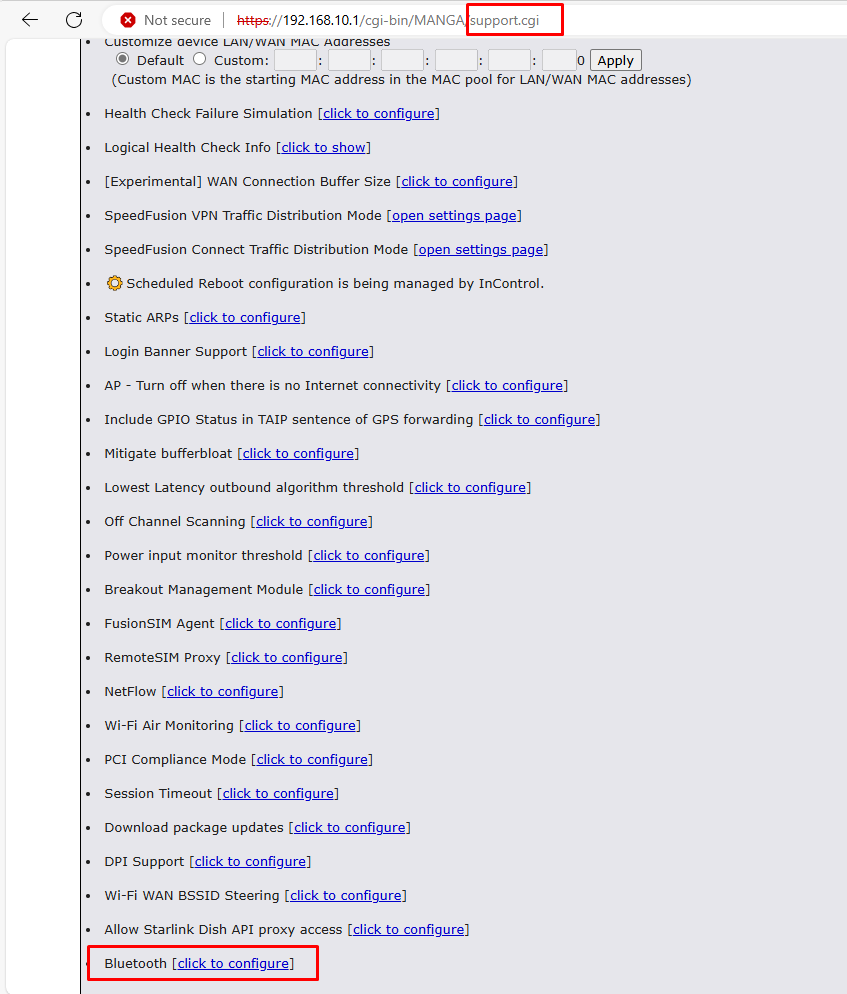
Appendix D. Declaration#
Details of the declaration can be found here (from page 255).
Appendix E: UK PSTI Statement of Compliance#
For B One 5G
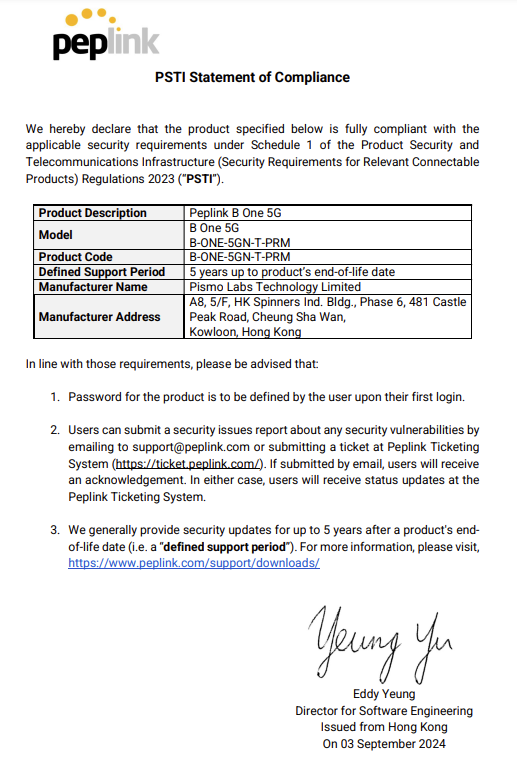
For B One Plus
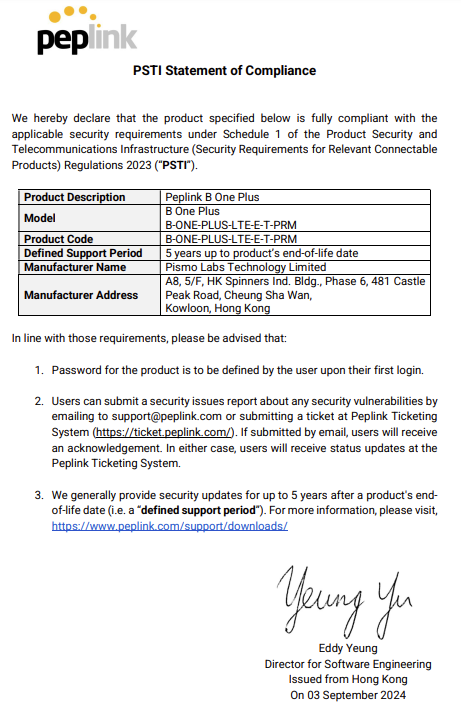
For B One
